Catamaran Relentless
- Availability & Rates
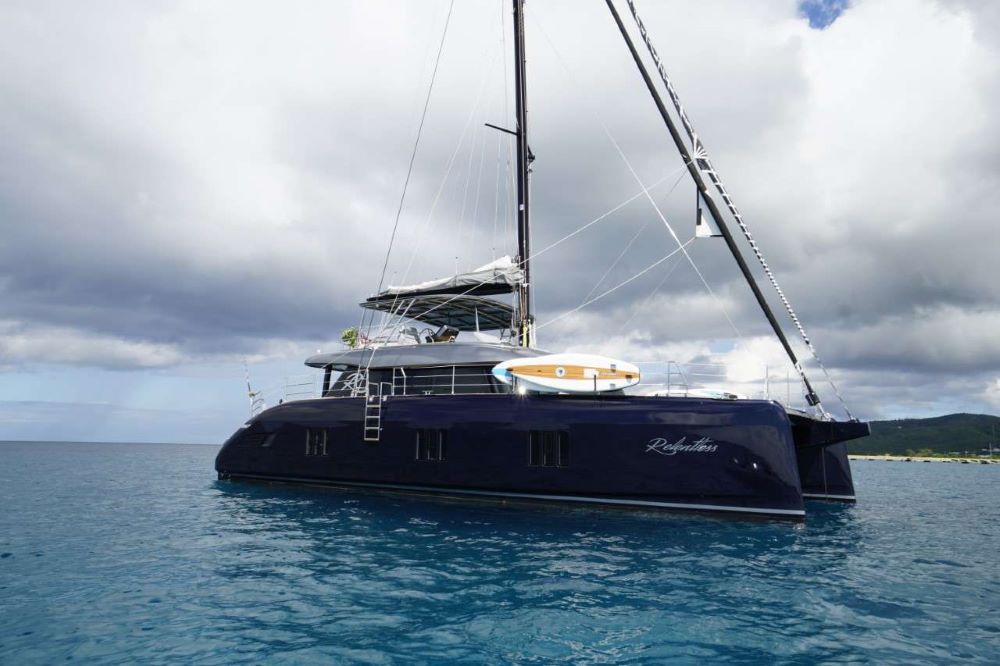

7-Night Charter Rates

| Guests | Up to 8 | |
| Guest Cabins | 4 | |
| Length | 60ft | |
| Guest Cabin Configuration | 1 King, 3 Queen en-suite cabins with A/C | |
| Designer | Sunreef | |
| Launched | 2020 | |
| Children Allowed | Yes (Min. age: Water safe) | |
| Home Port | West End, Tortola, British Virgin Islands | |
| Scuba | Rendezvous only | |
| Winter Cruising Area | Caribbean Leewards, Caribbean Virgin Islands (BVI) | |
| Summer Cruising Area | Caribbean Leewards, Caribbean Virgin Islands (BVI) | |
Catamaran Relentless Overview
RELENTLESS: A 60' Sunreef Yacht of Pure Luxury
Relentless is a stunning 60' Sunreef catamaran that offers the ultimate in luxury and comfort for up to 8 guests. She features an up-galley layout, an owner's edition layout with a spacious king owner's suite, and three additional queen cabins, all with en-suite bathrooms and stall showers. Each stateroom also has a 32" smart TV and wireless charging pads in the bedside tables.
The salon features a backlit marble bar with a pop-up TV, and all end tables have wireless charging pads. The aft deck lounge and alfresco dining area are perfect for relaxing and entertaining guests, and the spacious flybridge offers 360-degree views and sun pads.
Relentless is the perfect yacht for those who want to experience the best that the Caribbean has to offer. She is equipped with all the latest amenities and toys, including a 15' RIB with 90hp engine, kneeboard, a subwing, seabobs, a Crusader SUP for 6, kayaks, a 4-person floating dock with chairs, an underwater camera and video, and fishing gear.
Experience the best of the Caribbean in luxury and style aboard RELENTLESS.
Green Initiative
Reef safe/eco-friendly sunscreens, toiletries and cleaning products. Purified drinking water made onboard. Reusable water bottles available for use onboard.
Meet the Crew

Captain Dan Shivone (Rotational)
Captain Dan’s passion for the water started at an early age along the coast of Delaware. He truly developed his skills after moving to Wrightsville Beach, North Carolina, where he learned to read the wind and the water for both surfing and sailing. He obtained his Captain’s license in North Carolina in 2008 and quickly began guiding on the water and sharing his love of nature and the sea. After sailing from North Carolina to the Bahamas on his personal boat, he found his way to the Virgin Islands. He now has over 8 years experience sailing the US and British Virgin Islands on myriad boats. Dan focuses on curating a custom itinerary based on his knowledge of the local waters and the guests requests. Most importantly, he wants everyone to feel safe, relaxed and at home while on vacation.
Captain Lisa Roland
Captain Lisa grew up sailing in Nova Scotia Canada where she fell in love with the sea.
Her years on the water prepared her for an exciting career in yachting and her true love for her work is apparent to anyone onboard. Lisa is one half of Team Ocean Grown, a pairs ocean rowing team competing in the 2023 Talisker Atlantic Challenge, a 3,000nm ocean row raising funds for a maritime education scholarship for former foster youth. There are few things she loves more than sharing her enthusiasm for the sea, both above it and below with others through sailing, diving, educating, learning, and experiencing. ..read more
Chef Jade Konst
Born and raised nestled between the mountains and the sea on Canada’s West Coast, Jade found a love for all things ocean at an early age. Her hometown of Vancouver is known for it’s multinational cuisine and spectacular seafood fresh from the Pacific Ocean. There she honed her culinary talents while working in some of the most exclusive resorts the area has to offer. As a Chef, Divemaster and Captain, Jade has worn many hats over a decade of working on yachts, traveling the Caribbean, Eastern Mediterranean and New England. Every new destination she has gathered fresh flavors and new recipes to add to her ever evolving menus. A true mermaid, when not in the galley or on watch you can find her leading the snorkel trip in one of her many colorful tails!
Stew / Masseuse Julianna Leskie
Julianna's passion for adventure began when she moved to San Francisco to pursue her career in ballet, and fell in love with the Bay Area and all it had to offer. After retiring from her career as a ballet dancer, it was time to eat and drink some of the world’s best food and wine! She enthusiastically entered the world of hospitality, gaining experience in all areas of service, from craft bartending in posh lounges and Michelin dining rooms, to obtaining a sommelier certification and entering restaurant management and wedding coordinating. Expanding on her ability to deliver a memorable guest experience, she decided to pursue the study of massage therapy - where she has undoubtedly found her life’s work, helping clients escape, unwind and relax. This unique combination of skills has led Julianna to find her newest adventure aboard Relentless, allowing her to pursue her personal mission of creating a first-class relaxation experience at sea.
The crew aboard Relentless is excited to welcome guests aboard for another exciting season in the clear blue waters of the Virgin Islands! From visiting the famous beaches and beach bars, to exploring the secret spots that only locals know about, the team is here to cater to guests’ every need providing them with a relaxing vacation, and a lifetime of memories.
Captain Lisa will be onboard
September 1, 2023 - November 31, 2023
March 1, 2024 - May 31, 2024
Captain Dan will be onboard
December 1, 2023 - February 29, 2024
June 1, 2024 - August 31, 2024
Availability calendar for Relentless:
Listed below are any confirmed reservations or unavailability, as well as current holds / options. Note: this calendar is not always 100% current. Please contact us for more information about available dates aboard this yacht.
Hours required between charters: 48 preferred
| Aug 2024 | 1 | 2 | 3 | 4 | 5 | 6 | 7 | 8 | 9 | 10 | 11 | 12 | 13 | 14 | 15 | 16 | 17 | 18 | 19 | 20 | 21 | 22 | 23 | 24 | 25 | 26 | 27 | 28 | 29 | 30 | 31 |
|---|---|---|---|---|---|---|---|---|---|---|---|---|---|---|---|---|---|---|---|---|---|---|---|---|---|---|---|---|---|---|---|
| Sep 2024 | 1 | 2 | 3 | 4 | 5 | 6 | 7 | 8 | 9 | 10 | 11 | 12 | 13 | 14 | 15 | 16 | 17 | 18 | 19 | 20 | 21 | 22 | 23 | 24 | 25 | 26 | 27 | 28 | 29 | 30 | |
| Oct 2024 | 1 | 2 | 3 | 4 | 5 | 6 | 7 | 8 | 9 | 10 | 11 | 12 | 13 | 14 | 15 | 16 | 17 | 18 | 19 | 20 | 21 | 22 | 23 | 24 | 25 | 26 | 27 | 28 | 29 | 30 | 31 |
| Nov 2024 | 1 | 2 | 3 | 4 | 5 | 6 | 7 | 8 | 9 | 10 | 11 | 12 | 13 | 14 | 15 | 16 | 17 | 18 | 19 | 20 | 21 | 22 | 23 | 24 | 25 | 26 | 27 | 28 | 29 | 30 | |
| Dec 2024 | 1 | 2 | 3 | 4 | 5 | 6 | 7 | 8 | 9 | 10 | 11 | 12 | 13 | 14 | 15 | 16 | 17 | 18 | 19 | 20 | 21 | 22 | 23 | 24 | 25 | 26 | 27 | 28 | 29 | 30 | 31 |
| Jan 2025 | 1 | 2 | 3 | 4 | 5 | 6 | 7 | 8 | 9 | 10 | 11 | 12 | 13 | 14 | 15 | 16 | 17 | 18 | 19 | 20 | 21 | 22 | 23 | 24 | 25 | 26 | 27 | 28 | 29 | 30 | 31 |
| Feb 2025 | 1 | 2 | 3 | 4 | 5 | 6 | 7 | 8 | 9 | 10 | 11 | 12 | 13 | 14 | 15 | 16 | 17 | 18 | 19 | 20 | 21 | 22 | 23 | 24 | 25 | 26 | 27 | 28 | |||
| Mar 2025 | 1 | 2 | 3 | 4 | 5 | 6 | 7 | 8 | 9 | 10 | 11 | 12 | 13 | 14 | 15 | 16 | 17 | 18 | 19 | 20 | 21 | 22 | 23 | 24 | 25 | 26 | 27 | 28 | 29 | 30 | 31 |
| Apr 2025 | 1 | 2 | 3 | 4 | 5 | 6 | 7 | 8 | 9 | 10 | 11 | 12 | 13 | 14 | 15 | 16 | 17 | 18 | 19 | 20 | 21 | 22 | 23 | 24 | 25 | 26 | 27 | 28 | 29 | 30 | |
| May 2025 | 1 | 2 | 3 | 4 | 5 | 6 | 7 | 8 | 9 | 10 | 11 | 12 | 13 | 14 | 15 | 16 | 17 | 18 | 19 | 20 | 21 | 22 | 23 | 24 | 25 | 26 | 27 | 28 | 29 | 30 | 31 |
| Jun 2025 | 1 | 2 | 3 | 4 | 5 | 6 | 7 | 8 | 9 | 10 | 11 | 12 | 13 | 14 | 15 | 16 | 17 | 18 | 19 | 20 | 21 | 22 | 23 | 24 | 25 | 26 | 27 | 28 | 29 | 30 | |
| Jul 2025 | 1 | 2 | 3 | 4 | 5 | 6 | 7 | 8 | 9 | 10 | 11 | 12 | 13 | 14 | 15 | 16 | 17 | 18 | 19 | 20 | 21 | 22 | 23 | 24 | 25 | 26 | 27 | 28 | 29 | 30 | 31 |
7-night Charter Rates by Group Size
| Guests: | 2 guests | 3 guests | 4 guests | 5 guests | 6 guests | 7 guests | 8 guests |
|---|---|---|---|---|---|---|---|
| Summer 2024 | $48,000 | $49,000 | $50,000 | $51,000 | $52,000 | $53,000 | $54,000 |
| Winter 2024 to 2025 | $48,000 | $49,000 | $50,000 | $51,000 | $52,000 | $53,000 | $54,000 |
| Summer 2025 | $48,000 | $49,000 | $50,000 | $51,000 | $52,000 | $53,000 | $54,000 |
Contact us for rates and current availability or to book a charter aboard Relentless!
Full Specifications for Relentless
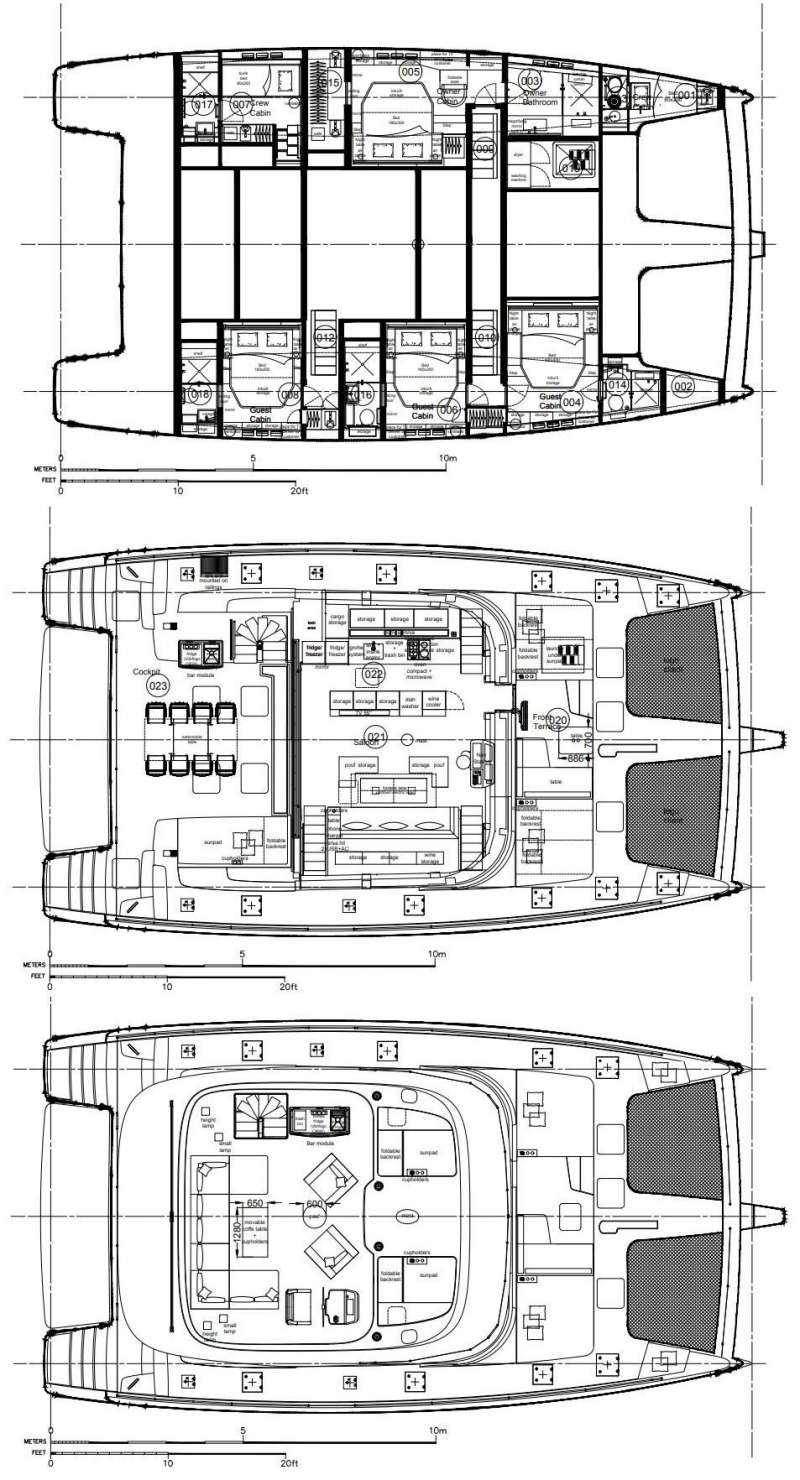
Specifications
| Length | 60ft |
| Beam | 33.5 |
| Draft | 5.75 |
| Designer | Sunreef |
| Launched | 2020 |
| Guests | Up to 8 |
| Children Allowed | Yes (Min. age: Water safe) |
| Air Conditioning | Full |
| Flag | USA |
| Max. Speed | 12Kts |
| Dinghy/Tender | 15ft (90HP) |
| Dingy Max. Passengers | 8 |
Accommodation
| Guest Cabins | 4 |
| Guest Cabin Configuration | 1 King, 3 Queen en-suite cabins with A/C |
| Guest Electric Heads | 4 |
| Accommodation Description: | |
| Salon has backlit marble bar with pop up TV plus all end tables have wireless charging pads Aft deck lounge and alfresco dining Fly-bridge with 360 degree view and sun pads Yamaha bluetooth JL speakers throughout the yacht 32 bottle wine fridge Full A/C Berth dimensions: Owner's cabin berth is 68’ wide Other cabin berths are 62’ wide | |
| Home Port | West End, Tortola, British Virgin Islands |
| Winter Cruising Area | Caribbean Leewards, Caribbean Virgin Islands (BVI) |
| Summer Cruising Area | Caribbean Leewards, Caribbean Virgin Islands (BVI) |
| Preferred Port | WE |
| Other Port | Nanny Cay, YHG or SXM |
| Hours Between Charters | 48 preferred |
| WiFi Internet | Onboard WIFI |
| Sun Awning | Yes |
| Hammock | No |
| Deck Shower | Yes |
| Hair Dryer | Yes |
| Water Maker | Yes |
| Ice Maker | Yes |
| BBQ | Yes |
| Voltage | 120v/240v |
| Other | Julianna is a licensed masseuse. She offers the following services to guests: -Each guest 18 years of age or older is offered 1 massage of their choice during charter. Extra massages may be arranged at additional cost if time permits. Guests will need to discuss pricing and make arrangements directly with her. |
Water Sports
| Adult Waterskis | Yes |
| Kids Waterskis | Yes |
| Stand Up Paddle Board | 2 |
| Snorkeling Gear | Yes |
| Tow Tube | Yes |
| Scurfer | Yes |
| Wake Board | Yes |
| Knee Board | Yes |
| 2-Person Kayak | 1 |
| Float Mats | Yes |
| Fishing Gear | Yes |
| Fishing Gear Type | Trolling |
| Number of Rods | 2 |
| Deep Sea | No |
| Underwater Camera | Yes |
| Underwater Video Camera | Yes |
| Other Water Toys | Crusader (6 person SUP) 4 person floating dock with chairs 8 underwater lights Various floats & noodles Seabob X 2 Wakeboard Subwing Tube |
Entertainment
| Stereo System | Yes |
| iPod Hookup | Yes |
| Satellite TV | No |
| DVD Player | Yes |
| Captain Nationality | USA |
| Captain License | USCG 100T |
| Crew Smokes | No |
| Crew Pets | No |
| Caters to Special Diets | Yes |
Sample Menu
SAMPLE MENU
Always includes boat-made Canadian Maple Granola, Natural Greek Yogurt, Tropical Fruit Platter, Fresh Squeezed Orange Juice, Selection of Coffee, Decaf and Teas served daily.
Shakshuka Skillet;
North Aftrican Tomato Egg Bake with Lamb Sausage, Roasted Red Peppers, Fresh herbs and Feta
Classic Eggs Benedict;
Canadian Bacon, Boat-made Herbed Biscuits, Lemon Hollandaise
West Coast Salmon Hash;
Alaskan Wild Smoked Salmon New Potato Hash, Lemon Dill Emulsion, Caribbean Avocado
Grilled Grapefruit;
Honey & Grand Marnier, Toasted Coconut, Bacon Chips
Belgian Waffles;
Vanilla Chantilly Whip, Warm Summer Berry Compote
Pain Perdue;
Boat-made Brioche French Toast, Nutmeg & Passion Fruit Syrup
Dutch Babies;
German Style Pancakes with Lemon Mascarpone, Fresh Blueberries
Full American Breakfast
Eggs Any Style, Pan Fries, Thick-cut Maplewood Smoked Bacon, Grilled Tomato
Toast & Confiture
Always followed by a cookie of the day!
Braised Beef Short Rib Sandwich;
Caramelized Dijon Onions , Blistered Cherry Tomatoes, Roquefort Melt on Toasted Sourdough
Thai Grilled Chicken Skewers;
Spicey Sprout Salad, Pickled Carrot Ribbons, Handmade Roti, Zesty Peanut Satay
Bison Beef Sliders;
boat-made Challah Mini Buns, Aged Gouda, Casava Truffle Frîtes
Cochinita Pibil;
Yucatan Style Tacos, Purple Slaw, Salsa Verde, Grilled Pineapple and Chili Lime Mexican Street Corn
House Specialty Sushi Platter;
Selection of Ahi Tuna, Atlantic Salmon, King Prawns, or Vegetarian Maki Rolls with Lotus Root Chips, Wakame Salad & Steamed Edamame
Polenta Crusted Chicken Breast;
Fennel Pollen, Romesco Sauce, Grilled Romaine Hearts, Yogurt Caesar Dressing, Parmesan Crisp
Fusion Tuna Niçoise;
Sesame Seared Ahi Tuna, Poached Purple Potatoes & Long Beans, Miso Aioli, Wasabi Foam
Mango Prosciutto Flatbread ;
Fresh Burrata, Rocket Salad, Maple Balsamic Vinaigrette
HORS D'OEUVRES
Happy hour delights paired with Julianna’s signature Cocktails!
Phyllo Baked Brie; Boat-made Crusty Baguette, Onion Confiture
Blue Crab Rangoon; Scallion Cream Cheese, Sweet Chili Dip
Italian Charcuterie and Olive Board; Boat-made Rosemary Focaccia
Fresh Catch Ceviche; Avocado and Roasted Salsa Roja
Spanish Chorizo; Fried Plantain & Boat-made Pickled Cucumbers
House Seasame Crackers; Beet Hummus, Olive Tapenade, Toasted Chickpeas
Chevre and Grapes; Rolled in Pistachios and Gold Foil with Pomegranate Molasses
Rainbow Salad Rolls ; Rice Wraps, Edible Flowers, Cashew Nuoc Nam
Foie Gras ; Pear pearls, Thyme Phyllo Pillows
Caribbean Spiney Lobster Carpaccio;
Lemon Dill Infused Olive Oil, Pickled Shallots, Hawaiian Black Salt
Avocado Cucumber Vichyssoise;
Parmesan Tuille, Herb oil
Californian Vera Cruz;
With Lime Poached Shrimp, Creme Fraiche
Watermelon Feta Salad;
Rocket and Roasted Pumpkin Seeds , Lime Mint Vinaigrette
Tuna à la Tahïtienne;
Lime and Coconut Milk, Roasted Garlic Crostini, Cilantro Caviar
Caribbean Cracked Conch Chowder;
Smoked Tomatoes, Sweet Corn Bisque, Dill Foam
Islands Curried Pumpkin Soup:
Garam Masala Spiced with Coconut Cream & Papadum
Melon Caprese Ensalata
Prosciutto, Baby Bocconcini, Basil Oil, Balsamic Pearls
MAIN COURSE
Jamaican Jerk Pork Tenderloin Medallions;
Apple Glazed Red Cabbage, Pea Puree, Plantain Crisps, Orange Thyme Jus
Five Spice Duck Magret;
Crispy skin, Passion Fruit Caramel, Polenta Cake, Scorched Bok Choy
Dukka Crusted Rack of Lamb;
Cauliflower Mash, Labneh, Pomegranate Molasses, Cilantro Mint Espuma
Prosciutto Wrapped Sous-vide Chicken Breast;
Boat-made Parsley Linguini, White Wine Parmesan Cream, Basil Tuilles
Hemp Heart Crusted Mahi Mahi;
Apple Saffron Butter, Broccolini, Roasted Sunchokes, Squid Ink Tuille
Sousvide Angus Beef Fillet Minion;
Mushroom Merlot Demi-Glaze, Truffle Mashed Potatoes, Asparagus Spears, Parsnip Crisps
Sous-Vide Butter Poached Lobster Tail,
Apple Celeriac velouté, Braised Baby Fennel , Nasturtium Leaf, Leek Foam
Grilled Pineapple , Lime Coconut Mousse, Spiced Rum Caramel
Poached Pears , Maple Walnuts, Port Reduction, Blue Cheese Mousse
Flourless Chocolate Cake , Black Currant Glaze, Candied Ginger, Gold Leaf
Espresso Martini Creme Brûlée , Chocolate Covered Coffee Beans
Key Lime Semi-Fredo , Graham Cookie Crumble, Marshmallow Whip
Grenadian Chocolate Mousse “ mud”, Eddible Almond “Dirt”, Fresh Flowers, Chocolate Rocks
Red Delicious Apple Rosettes , Dulce de Leche, Vanilla Ice Cream
- Overview
- Availability & Rates
- Specs
- Contact
Interested in Relentless? Get in touch to learn more or book your vacation!
NEW ON BOATSATSEA
- Serendipity
- One II Love
- La Vie Est Belle
NEWEST SPECIAL OFFERS
- Nae Kae ( 10% off)
- Mondango ( 10% off)
- Infinity ( 15% off)
- Mira Sol ( 10% off)
- Ritmo ( 15% off)
- Lupus Mare ( 15% off)
- See All Special Offers
TOP CHARTER YACHTS
- Crystal Dreams
- Just Enough ( 4 Days All-Inclusive Special )
- Barefeet Retreat
- C´est La Vie ( 10% off)
- Miss Summer
- See All Yachts
Most Searched Yacht
Esperanza ii.
From $23,000 per week
TOP DESTINATIONS
- Virgin Islands (BVI & USVI)
- Leeward Islands / St. Martin
- Windward Islands / Grenadines
EUROPE / MEDITERRANEAN
- Amalfi Coast & Sicily
- Riviera & Corsica & Sardinia
- Spain / Balearics
- New England
- South America
MY FAVORITE YACHTS
- See Favorite Yachts
- Send & Share Favorite Yachts
- Empty Favorite Yacht List
- Yacht Charter FAQ
- Rates Explanations
- Concierge Service
- Customer Satisfaction
- BoatsAtSea Reviews
- Dedicated Support
- Privacy Policy
- Cookie Policy
Relentless II 80 - Crewed Luxury Catamaran Charter
Relentless ii 80 $94,000, relentless ii 80.
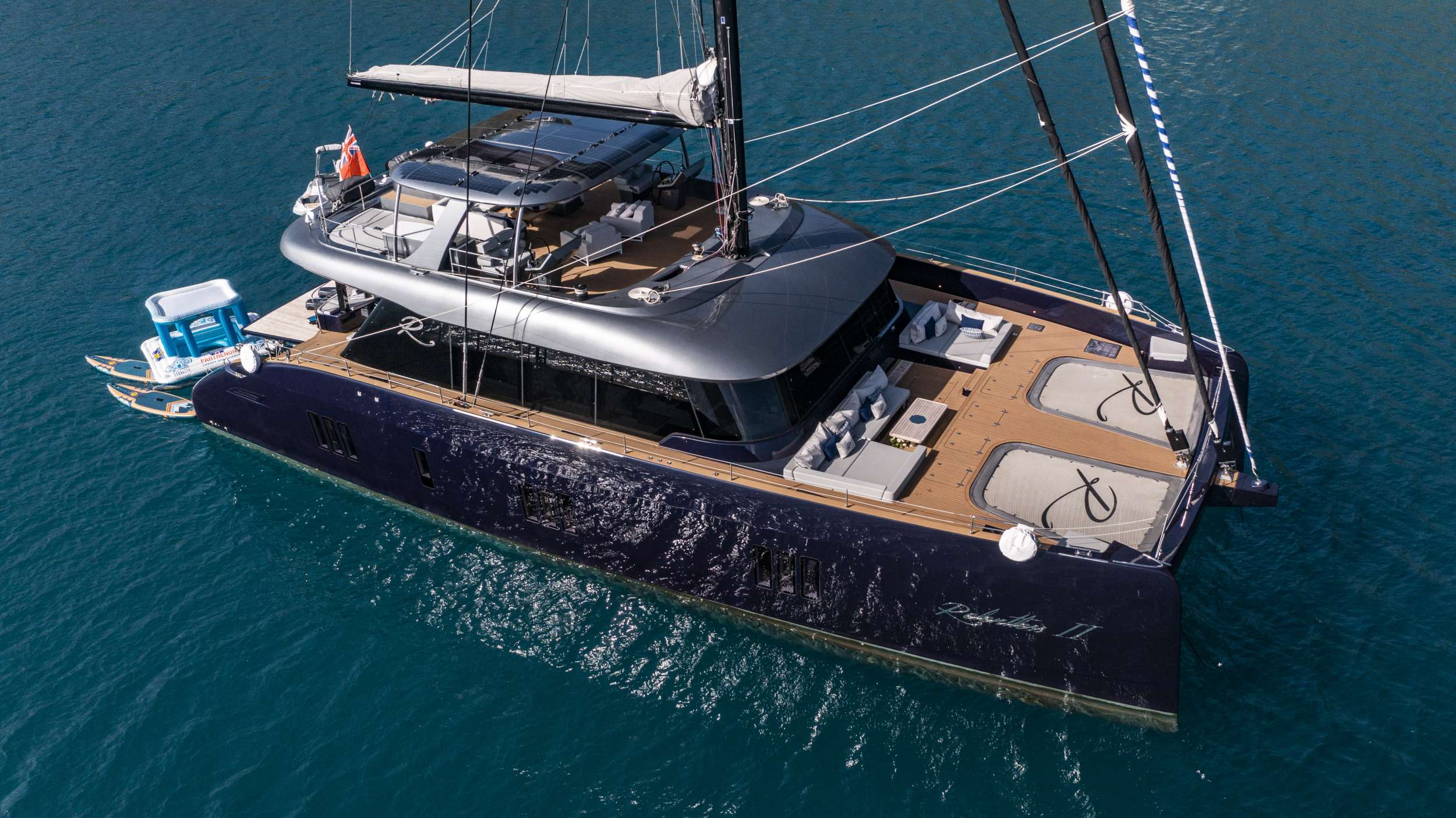
Relentless II 80 Image 1/24
Layout of Relentless II 80
Relentless II 80 Image 3/24
Relentless II 80 Image 4/24
Relentless II 80 Image 5/24
Relentless II 80 Image 6/24
Relentless II 80 Image 7/24
Relentless II 80 Image 8/24
Relentless II 80 Image 9/24
Relentless II 80 Image 10/24
Relentless II 80 Image 11/24
Relentless II 80 Image 12/24
Relentless II 80 Image 13/24
Relentless II 80 Image 14/24
Relentless II 80 Image 15/24
Relentless II 80 Image 16/24
Relentless II 80 Image 17/24
Relentless II 80 Image 18/24
Relentless II 80 Image 19/24
Crew of Relentless II 80
Magnus (Captain)
Jayde (Chef)
Gavin (First mate)
Ronette (Stew/Masseuse)
- From $94,000 / week
- Luxury Catamaran + 4 crew
- Summer Port: Cruising Areas Summer: Caribbean Leeward Islands, Caribbean Virgin Islands Summer Port: BVI Winter: Caribbean Leeward Islands, Caribbean Virgin Islands Winter Port: BVI Prefered Pickup: WEst End/Sopers Hole Other Pickup: Nanny Cay, SXM ">BVI
- Winter Port: Cruising Areas Summer: Caribbean Leeward Islands, Caribbean Virgin Islands Summer Port: BVI Winter: Caribbean Leeward Islands, Caribbean Virgin Islands Winter Port: BVI Prefered Pickup: WEst End/Sopers Hole Other Pickup: Nanny Cay, SXM ">BVI
- Length: 80 ft / 24.4 meters 80 feet 24.4 meters
- Guests: 8 in 4 cabins
- Builder: Sunreef Yachts
- Built: 2022
- Offers Rendezvous Scuba Diving only
All Inclusive
- Reviews (7)
Relentless II 80 Description
Relentless II, a 2022 Sunreef Yacht 80-foot sailing catamaran, is the perfect vessel for an unforgettable sailing vacation in the Caribbean British Virgin Islands. Her sleek design, spacious accommodations, and abundance of amenities, including an expansive flybridge with sun beds, couch and chairs, a large Jacuzzi nestled by sapphire lounge beds, and a wide range of watersports equipment, offer guests the ultimate in luxury and comfort. After a day of fun in the sun, indulge in a refreshing rinse under the gentle cascade of the cockpit rainfall showers. Each of the four cabins has its own en-suite bathroom, and the primary cabin features a king-size bed, desk/vanity, walk-in closet, and sofa that converts into a kid´s bed. The ample main salon, upholstered in aquamarine and sapphire tones, evokes the beauty of the ocean itself. Opposing U-shaped lounges flank a central dining area. The bow boasts a cozy conversational space with couches and occasional tables. The flybridge is an oasis of relaxation with sun beds, a lounging couch, chairs, and a large Jacuzzi. Her highly skilled and experienced crew is passionate about making your vacation dreams a reality. With everything you need to create a truly unforgettable vacation, Relentless II is the perfect choice for your next sailing adventure.
Cruising Area of Relentless II 80
Accommodations, specification, water sports, scuba diving, entertainment, green initiatives, relentless ii 80 crew profile.
Captain - Magnus Wittersø Captain Magnus hails from the frigid fjords of Norway with several captains in his blood line. He spent his entire childhood regatta racing, teaching sailing and working for the King in the Norwegian Navy before he felt himself being drawn to far more tropical latitudes. Now, thawed out, and after several years of cruising on his private sailboat, multiple ocean crossings and chartering the most stunning waters and island groups in the world, he can guarantee a fantastic experience with well thought out itineraries and adventures. Chef - Jayde Cou Jayde Cou is originally from sunny South Africa. She grew up being heavily influenced by the coastal culture, which is famous for its sailing, as well as, its unique and impeccable coastal foods and wines. It was here that her love for the service industry began. Jayde graduated from University with an honors degree in software development. Afterward, she went to pursue an offshore sailing license. Since then, she has spent the last 12 years working on board various vessels, such as cruise ships, catamarans, motor, and sailing yachts, as a key part of the galley service, as well as interior and deck teams. Jayde believes that yachting is the perfect career for her. She takes particular pride in going the extra mile to enhance the experience of your time onboard and in creating beautiful, fresh, and island-influenced meals. When not onboard the vessel, she is a passionate traveler, snowboarder, kitesurfer, writer and even a sailing vessel captain. Stewardess/Masseuse - Ronette Liebenberg Ronette, hailing from Cape Town, South Africa, carries a heart brimming with passion, particularly for the ocean where she feels most at home. Infusing every moment onboard with the enchantment of a sunset over the horizon has become her mission. And when it comes to wine, well, it´s the apple of her eye - or perhaps, should we say, grape? Each sip unfolds a story she eagerly embraces. Her enthusiasm extends to the art of food and wine pairing, a delight shared by many. Armed with certifications in Swedish Massage, Bartending, and a WSET Level 2 in wine, she goes beyond serving beverages; she crafts experiences. For Ronette, it´s not just about providing service; it´s about fostering connections and ensuring every detail is impeccably executed. She thrives on forging bonds, sharing tales, and creating memories that linger well beyond the voyage´s end. Her ultimate aim? To make every moment onboard feel like coming home. First Mate - Gavin Conradie Meet Gavin, the adventurous South African First Mate. Born with a natural love for the outdoors, Gavin embraces the thrill of sailing and the serenity of freediving. On land, he´s always on the move, hiking, exploring, and staying active. What´s more, he´s a bit of a racing aficionado with a motorsport background that´s netted him multiple national titles. Gavin is passionate about people and making lifelong friendships along the way, and, above all, ensuring guests have an amazing time on board. ´Life´s a journey, and I´m here to ride the waves with you.´
Relentless II 80 Calendar
| Aug 2024 | 1 | 2 | 3 | 4 | 5 | 6 | 7 | 8 | 9 | 10 | 11 | 12 | 13 | 14 | 15 | 16 | 17 | 18 | 19 | 20 | 21 | 22 | 23 | 24 | 25 | 26 | 27 | 28 | 29 | 30 | 31 |
|---|---|---|---|---|---|---|---|---|---|---|---|---|---|---|---|---|---|---|---|---|---|---|---|---|---|---|---|---|---|---|---|
| Sep 2024 | 1 | 2 | 3 | 4 | 5 | 6 | 7 | 8 | 9 | 10 | 11 | 12 | 13 | 14 | 15 | 16 | 17 | 18 | 19 | 20 | 21 | 22 | 23 | 24 | 25 | 26 | 27 | 28 | 29 | 30 | |
| Oct 2024 | 1 | 2 | 3 | 4 | 5 | 6 | 7 | 8 | 9 | 10 | 11 | 12 | 13 | 14 | 15 | 16 | 17 | 18 | 19 | 20 | 21 | 22 | 23 | 24 | 25 | 26 | 27 | 28 | 29 | 30 | 31 |
| Nov 2024 | 1 | 2 | 3 | 4 | 5 | 6 | 7 | 8 | 9 | 10 | 11 | 12 | 13 | 14 | 15 | 16 | 17 | 18 | 19 | 20 | 21 | 22 | 23 | 24 | 25 | 26 | 27 | 28 | 29 | 30 | |
| Dec 2024 | 1 | 2 | 3 | 4 | 5 | 6 | 7 | 8 | 9 | 10 | 11 | 12 | 13 | 14 | 15 | 16 | 17 | 18 | 19 | 20 | 21 | 22 | 23 | 24 | 25 | 26 | 27 | 28 | 29 | 30 | 31 |
| Jan 2025 | 1 | 2 | 3 | 4 | 5 | 6 | 7 | 8 | 9 | 10 | 11 | 12 | 13 | 14 | 15 | 16 | 17 | 18 | 19 | 20 | 21 | 22 | 23 | 24 | 25 | 26 | 27 | 28 | 29 | 30 | 31 |
| Feb 2025 | 1 | 2 | 3 | 4 | 5 | 6 | 7 | 8 | 9 | 10 | 11 | 12 | 13 | 14 | 15 | 16 | 17 | 18 | 19 | 20 | 21 | 22 | 23 | 24 | 25 | 26 | 27 | 28 | |||
| Mar 2025 | 1 | 2 | 3 | 4 | 5 | 6 | 7 | 8 | 9 | 10 | 11 | 12 | 13 | 14 | 15 | 16 | 17 | 18 | 19 | 20 | 21 | 22 | 23 | 24 | 25 | 26 | 27 | 28 | 29 | 30 | 31 |
| Apr 2025 | 1 | 2 | 3 | 4 | 5 | 6 | 7 | 8 | 9 | 10 | 11 | 12 | 13 | 14 | 15 | 16 | 17 | 18 | 19 | 20 | 21 | 22 | 23 | 24 | 25 | 26 | 27 | 28 | 29 | 30 | |
| May 2025 | 1 | 2 | 3 | 4 | 5 | 6 | 7 | 8 | 9 | 10 | 11 | 12 | 13 | 14 | 15 | 16 | 17 | 18 | 19 | 20 | 21 | 22 | 23 | 24 | 25 | 26 | 27 | 28 | 29 | 30 | 31 |
| Jun 2025 | 1 | 2 | 3 | 4 | 5 | 6 | 7 | 8 | 9 | 10 | 11 | 12 | 13 | 14 | 15 | 16 | 17 | 18 | 19 | 20 | 21 | 22 | 23 | 24 | 25 | 26 | 27 | 28 | 29 | 30 | |
| Jul 2025 | 1 | 2 | 3 | 4 | 5 | 6 | 7 | 8 | 9 | 10 | 11 | 12 | 13 | 14 | 15 | 16 | 17 | 18 | 19 | 20 | 21 | 22 | 23 | 24 | 25 | 26 | 27 | 28 | 29 | 30 | 31 |
| Aug 2025 | 1 | 2 | 3 | 4 | 5 | 6 | 7 | 8 | 9 | 10 | 11 | 12 | 13 | 14 | 15 | 16 | 17 | 18 | 19 | 20 | 21 | 22 | 23 | 24 | 25 | 26 | 27 | 28 | 29 | 30 | 31 |
Relentless II 80 Reservations & Port Locations
| Start Date | End Date | Details |
|---|---|---|
| Aug 01, 2024 | Oct 31, 2024 | Unavailable: Grenada, St Georges to TBD |
| Dec 20, 2024 | Dec 27, 2024 | Booked: Tortola, West End, BVI to Tortola, West End, BVI |
| Dec 29, 2024 | Jan 05, 2025 | Booked: Tortola, West End, BVI to Tortola, West End, BVI |
| Feb 15, 2025 | Feb 22, 2025 | Booked: Tortola, West End, BVI to Tortola, West End, BVI |
| Mar 15, 2025 | Mar 22, 2025 | Hold: Tortola, West End, BVI to Tortola, West End, BVI |
| Apr 05, 2025 | Apr 12, 2025 | Hold: Tortola, Trellis Bay, BVI to Tortola, Trellis Bay, BVI |
| May 07, 2025 | May 14, 2025 | Booked: Tortola, West End, BVI to Tortola, West End, BVI |
Relentless II 80 Rates / week
Low price: $94,000, high price: $100,000.
| Season | 2 Pax | 3 Pax | 4 Pax | 5 Pax | 6 Pax | 7 Pax | 8 Pax |
|---|---|---|---|---|---|---|---|
| 2024 Summer | $94,000 | $95,000 | $96,000 | $97,000 | $98,000 | $99,000 | $100,000 |
| 2024/25 Winter | $94,000 | $95,000 | $96,000 | $97,000 | $98,000 | $99,000 | $100,000 |
| 2025 Summer | $94,000 | $95,000 | $96,000 | $97,000 | $98,000 | $99,000 | $100,000 |
ADDITIONAL RATE DETAILS
Relentless ii 80 guest reviews, february 2024.
-Dear Crew of Relentless, We all had an amazing time on with Relentless II celebrating Larry’s 60th birthday. Your service was amazing and you all made the trip so enjoyable. We hope you use Larry’s mottos of DWZ and remember us. We all have tons of memories of this trip, a time we will remember forever. Until next time, take care and always remember you are the best and most enjoyable crew we’ve had yet!
It´s hard to know where to start to describe the amazing week we have had aboard Relentless II. Not only did we love learning about the islands from our knowledgeable captain and crew, we loved playing with the crew on all of the toys and getting to know you all. Katie´s meal were delicious and we ate way too much. We loved her passion for her work. Rita is the perfect hostess and so talented. We loved all of her inventive cocktails and therapeutic massages. Heather is a pro and we always felt safe in her capable hands. The trip was fantastic and the boat beautiful. We have made memories to last a lifetime. You are all the best of the best! Deborah, Michael, Christina, Bela, Bronwyn, Kim & Peter
What an amazingly special week!
Relentless II is a fabulously comfortable home. Captain Magnus, Heather, Riita and Katie are the most incredibly warm, friendly helpful people. All of whom made the week ultra special Our excursions, hikes beach walks, water fun with toys, snorkling, paddling - all a blast! Food drinks an fun on board was the best ever. Thank you all for making this an ultra fun experience. Hope to see you next year ! -Nita & James
January 2023
We had an amazing time on Relentless II. The staff was wonderful and so helpful. We couldn’t have asked for a more relaxing fun vacation. Our girls loved everything. The food was fantastic and the cocktails were phenomenal. The beaches we visited and the watersport activities were so much fun. - Brandon Marah and Harper
It is difficult to give enough thanks to the crew for their Relentless pursuit of hospitality. This is how it is done. Amazing, luxurious and spacious boat with every amenity and water toy. Superlative food and drink. Avail yourself of the relaxing massages and the delicious cocktails! Pro tip: Fly Relentless Air to the boat! Thanks Magnus, Heather, Rita and Katie for the experience of a lifetime - Lawrence & Jitka
December 2022
Captain Bret, Chef Katie & Rita - you are the most incredibly fabulous crew and we will never ever forget our time aboard the spectacular Relentless. From the sails, hikes, swims, “Lime Out” excursion, peaceful coves, massages (we are all converts now) the unbelievably over the top amazing meal after meal (we photographed every one!) and oh - those never ending cocktails. Everything was magical, perfec,t memorable, and glorious. We can’t even imagine the amount of effort you all put in to make this week seem effortlessly perfect. Thank you! Please keep in touch so we can do this again! - Julie
Oh my goodness, what an incredible trip! It was the perfect balance of adventure, fun and relaxation. We had so many opportunities to bond as a family and there is no greater gift than connection between one another. Rita - Your energy is so pure. It is so apparent you lead with your heart and your heart is full of kindness Plus your cocktails are killer. Heather - you’re a badass. Your knowledge of the islands was not only helpful but made the trip more personal. Katie - you kept us perfectly fed! Your menus were everything we wanted. Comforting, clean fun and balanced Ian - Thank you for going with the flow. You hit all the spots we had hoped for. Thank you for giving us a forever memorable trip. - Jeff, Blair, Pryce & Rara
Relentless II 80 Sample Menu
Breakfast plates.
Bacon & Leek Quiche (GF O/A) Served With Side Of Chicken Sausage & Topped With Locally Grown Kale Microgreens Salad
Passionfruit Eggs Benedict Poached Egg, Sweet Plantain Cakes, Pork Belly & Passionfruit Hollandaise
French Omelet Served With A Fresh Baked Croissant & Thick Cut Applewood Smoked Bacon
Stuffed Sweet Potato Roasted Sweet Potatoes Stuffed With Sautéed Apple, Cinnamon, Banana With Side Of Sliced Brie & Thick Cut Applewood Smoked Bacon
Bacon Egg & Cheese Bagels Applewood Smoked Bacon, Aged Cheddar Cheese & Egg On Fresh Made Bagels With Side of Hash Browns
Huevos Rancheros Two Sunny Side Up Eggs Over Black Bean & Roasted Red Pepper Puree, Fresh Pico De Gallo, Roasted Salsa, Cotija Cheese, Avocado Over Warm Corn Tortilla With Lime Cheeks & Cilantro
Relentless Pancakes Buttermilk Pancakes With Choice of Fruit Topping, Canadian Maple Syrup Served With Applewood Smoked Chicken Sausage
Scotch Eggs Two Soft Boiled Eggs Encased In Breakfast Style Sausage Over Savory Porridge & Sautéed Spinach
Frangelico French Toast Infused French Toast Topped With Maple Whipped Ricotta Cheese & Bacon Crumble
Lox & Bagel Freshly Made Everything Bagels, Smoked Lox, Whipped Herb Cream Cheese, Capers, Pickled Red Onions, Sliced Cucumbers, Tomatoes & Kale Micogreens. Served With Side Of Soft Boiled Quail Eggs & Bacon
Lunch Plates
Mahi & Burrata Salad Locally Caught Mahi Over Ovation Greens, Creamy Italian Burrata, Cherry Tomatoes & Asparagus Tips, Topped With Basil Pesto & Radish
Hand Rolled Sushi With Edamame & Seaweed Salad Blackberry Salmon Roll Salmon, Blackberry Cream Cheese, Avocado & Carrot Spicy Tuna Roll Honey, Soy, Ginger Marinated Tuna, Cucumber, Carrot, Avocado & Sriracha Aioli Rancher Roll (Non-Fish Option) Chicken, Bacon, Carrot & Avocado Topped With Buttermilk Ranch, BBQ, Bacon, Chive & Bacon Fat Panko Crunchies Tuna Sushi balls Tuna & Nori Rice Balls Topped With Honey Soy Reduction & Toasted Sesame Seeds
Seared Wild Caught Salmon & Grapefruit Salad Crispy, Skin-On Salmon Over Locally Grown Ovation Greens, Grapefruit Supreme, Shaved Green Apples, Fennel, Fire Roasted Kumquats, Avocado Creme & Feta, Topped With Grapefruit Vinaigrette
Roasted Beet Salad Roasted Red & Golden Beets, Baby Arugula, Shaved Red Onion, Zhoug, Puffed Quinoa, Whipped Labneh & Pistachio Crumble
Marinated Ahi Tuna Bowls Ginger, Soy & Honey Marinated Sake Tuna Over Shaved Carrots, Red Cabbage, Radish & Sticky Rice With Shiitake Sesame Dressing & Avocado
Cuban Thick Cut Ham, Slow Roasted Pork, Aged Swiss Cheese, Boat-made Pickles, Dijon Mustard On Crispy Grilled Loaf With Sweet Potato Parmesan Fries
Signature Pizzas All pizzas are made fresh before your eyes! With this interactive lunch the possibilities are endless! Please indicate any special pizzas or toppings on your preference sheets so we may customize the perfect pie for your upcoming trip! Margarita Slow Roasted Tomato Sauce, Fresh Mozzarella Topped With Fresh Basil & Drizzled With Olive Oil Pepperoni Slow Roasted Tomato Sauce, Fresh Mozzarella, Spicy Pepperoni Topped With Aged Parmesan & Fresh Basil Pork & Blue Sausage & Gorgonzola Pizza Topped With Pickled Red Onions, Pickled Mustard Seed Topped With Local Microgreens & Prosciutto Mushroom & Onion Baby Portobello & Bunashimeji Mushrooms, Caramelized Onions, Chopped Garlic, Mozzarella, Aged Parmesan Topped With Arugula & Truffle Oil Berries & Cream Blackberries, Raspberries & Blueberries Over Honey Whipped Ricotta It’s Bananas! Nutella Pizza Topped With Roasted Bananas & Dusted With Shaved Grenadian Chocolate
Starter Plates
Arancini Crispy Italian Rice Balls Stuffed With Mozzarella & Herbs, Coated In Bread Crumbs Over Roasted Red Pepper & Goat Cheese Puree
Crispy Tuna Wonton Nachos Fresh Marinated Tuna Over Warm Wonton Nachos, Edamame, Shaved Radish, Green Onion, Purple Cabbage, Topped With Sweet & Tangy Soy Marinate, Sriracha & Wasabi Aioli
Baked Brie Creamy, Melted Brie & Fig Wrapped In Crispy Warm Filo Dough Served with Fresh Fruit & Crackers
Rocket & Strawberry Salad Baby Rocket, Strawberries, Toasted Shaved Almonds Tossed In Strawberry Vinaigrette Topped With Feta & Lemon Zest
Foie Gras Pan Seared Served With Rich Red Wine Port Sauce, Green Grapes & Crusty Loaf
Shrimp & Tuna Tartare Diced Spicy Marinated Shrimp &Tuna With Avocado In Cucumber Coulis
Dinner Plates
Sea Bass Crispy Seared Sea Bass Over Garlic Whipped Pomme Puree, Asparagus, Beurre Blanc & Passion Fruit Butter
Filet Mignon Grass-Fed New Zealand Tenderloin Medallions Over Creamy Smoked Gouda Polenta, Roasted Heirloom Carrots, Fondant Potato, With Port Red Wine Reduction
Snapper Crispy Skin Snapper Over Pea Risotto, Radish, Sweet Corn Foam & Prosciutto
Braised Short Rib Raviolis Boat-Made Red Wine Braised Short Rib Raviolis In Truffle Cream Sauce Topped With Shaved Spring Truffles & Basil Microgreens
Duck Seared Duck Over Cauliflower Puree, Tatsoi, Asparagus, Bunashimeji, Duck Fat Potato Terrine & Duck Demi-glace
Octopus Grilled Octopus Over Romesco, Charred Corn Ribs, Hasselback Potatoes, Broccolini, Chimichurri & Toasted Almond
Caribbean Lobster Butter Poached Caribbean Lobster Tails Over Cream Sweet Corn Puree, Haricot Vert & Cherry “Bomb” Tomatoes
Lamb Chimichurri Encrusted Lamb Lollipops Over Grilled Vegetable Couscous
Scallops Seared Scallops Over Pancetta & Tomato Corn Salad Tossed In Warm Bacon Vinaigrette, Crispy Prosciutto & Avocado Foam
Pork Pork Schnitzel Over Celeriac & Apple Remoulade & Fried Local Egg
Dessert Plates
Fresh ginger molasses cake with strawberry compote, candied ginger, and vanilla cream
Salted dark chocolate & coconut tart with pomegranate & dragonfruit
Tropical pineapple rum cake with a butter rum glaze and toasted coconut
Coconut and vanilla bean rice pudding cake with fresh raspberry jam
Rich Nutella cupcakes with toasted meringue frosting and crusted hazelnut
Tangy lemon curd and strawberry parfaits with coconut cookie, walnuts, and candied blackberries
Award Winning Vegan Chocolate Torte With Strawberries & Chocolate Shavings
Lemon Curd With Raspberries, Bee Pollen, Raspberry Dust & 14K Gold
Pavlova Kisses With Fresh Strawberries, Kiwi, Strawberry Coulis & Strawberry Dust
Flourless Chocolate Torte Topped With Chocolate Ganache & Fresh Berries
Browned Butter Chocolate Chunk Ice Cream Cookie Sandwiches
Classic Tiramisu
Lemon Posset With Mint & Berries
Boat-Made Ice Cream Inquire for flavors or request something special!
Spice Island Carrot Cake
Chilled Red Wine Poached Pears With Pistachio Crumble & Boat-Made Vanilla Ice Cream
SIMILAR YACHTS
Check out similar yachts to relentless ii 80, $92,500 / week.
Guests in Cabins: 8 / 4
Length: 80 ft (24.4 m)
Summer Port: NA
Winter Port: BVI
Prices from: $92,500 / week
Ocean Vibes
$61,965 / week
Length: 74.8 ft (22.8 m)
Summer Port: Tortola, BVI
Winter Port: Tortola, BVI
Prices from: $61,965 / week
Relentless 60
$48,000 / week
Length: 60 ft (18.3 m)
Summer Port: BVI
Prices from: $48,000 / week
$43,200 / week
Prices from: $43,200 / week
$44,500 / week
Guests in Cabins: 9 / 4
Length: 70 ft (21.30 m)
Prices from: $44,500 / week
$90,000 / week
Guests in Cabins: 10 / 5
Prices from: $90,000 / week
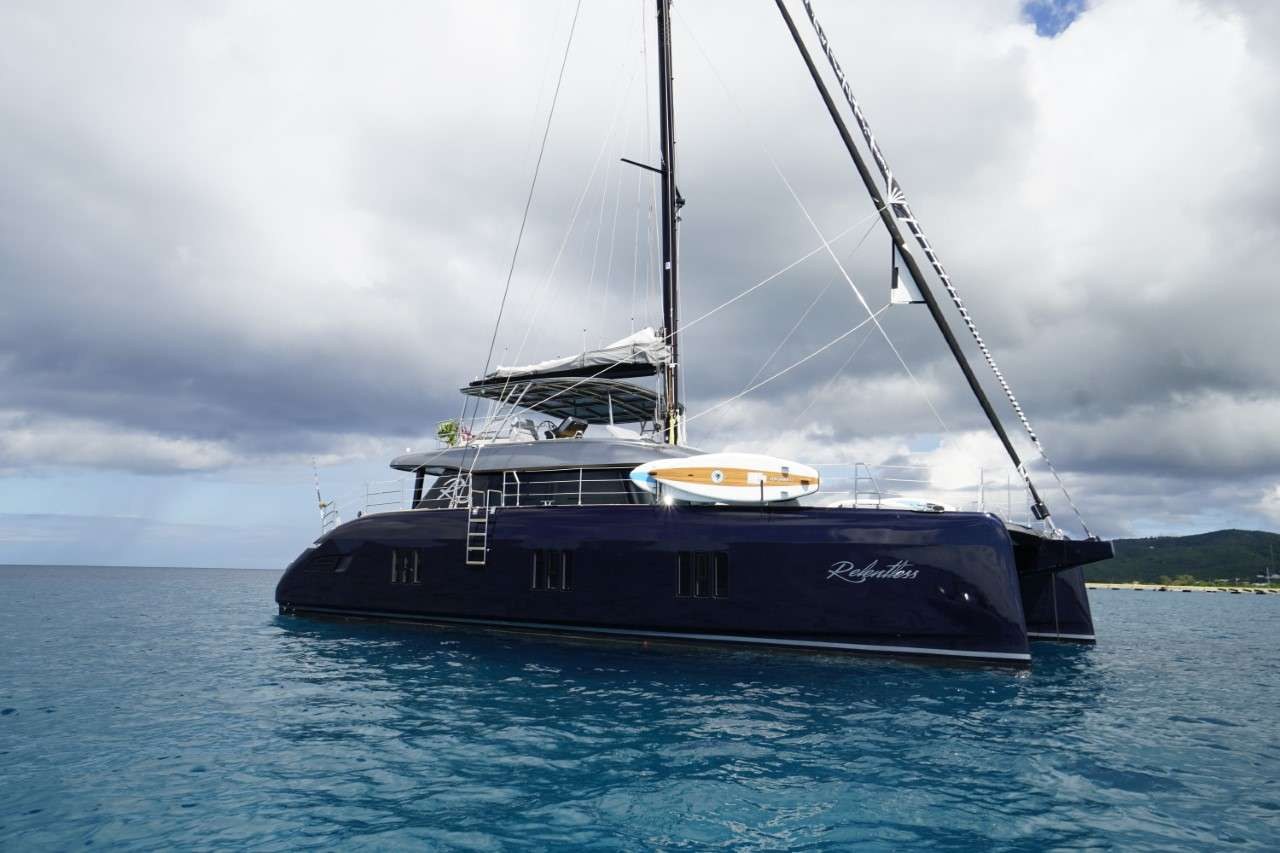
Open Gallery
RELENTLESS 60 Yacht Charter Catamaran
Rates & Calendar
Size / Year Built / Builder
Other specifications
- Beam 33.5 Feet
- Draft 5.75 Feet
- Type Catamaran
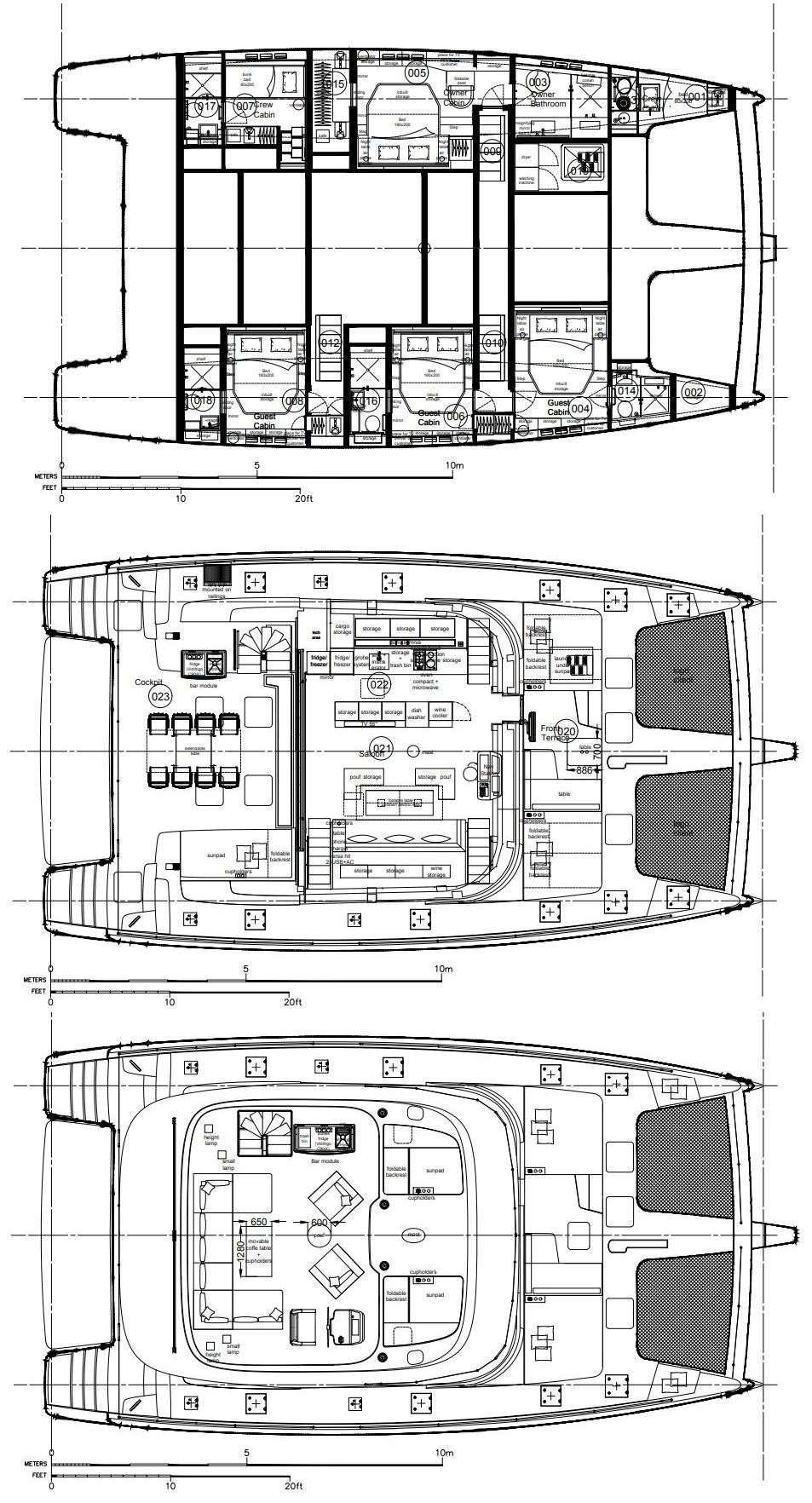
Accommodations
Deck jacuzzi, air conditioning, wind scoops, deck shower, hair dryers, wheelchair access, stabilizers, onboard entertainment, salon tv/dvd, salon stereo/music, board games, ipod/mp3 hookups, gym equipment, water entertainment, water skis - adult, water skis - kids, wave runners, snorkel gear, kayaks - 2 man, floating mats, beach games, fishing gear, under water camera, under water video, stand-up paddle, sea scooters, deep sea fishing, sailing instructions, swim platform, boarding ladder (loc/type), fishing gear type, scuba diving, license info, air compressor, technical details, cruising speed, water maker, water capacity, charter types, special diets, kosher diets, gay charters, nudist charters, crew smokes, pets onboard, guest pets allowed, children allowed, minimum age, guest smokes, type of pets, green initiatives, make drinking water tested for purity, re-usable water bottles, other green initiatives, nationality, languages spoken by crew.

Always includes boat-made Canadian Maple Granola, Natural Greek Yogurt, Tropical Fruit Platter, Fresh Squeezed Orange Juice, Selection of Coffee, Decaf and Teas served daily.
Shakshuka Skillet;
North Aftrican Tomato Egg Bake with Lamb Sausage, Roasted Red Peppers, Fresh herbs and Feta
Classic Eggs Benedict;
Canadian Bacon, Boat-made Herbed Biscuits, Lemon Hollandaise
West Coast Salmon Hash;
Alaskan Wild Smoked Salmon New Potato Hash, Lemon Dill Emulsion, Caribbean Avocado
Grilled Grapefruit;
Honey & Grand Marnier, Toasted Coconut, Bacon Chips
Belgian Waffles;
Vanilla Chantilly Whip, Warm Summer Berry Compote
Pain Perdue;
Boat-made Brioche French Toast, Nutmeg & Passion Fruit Syrup
Dutch Babies;
German Style Pancakes with Lemon Mascarpone, Fresh Blueberries
Full American Breakfast
Eggs Any Style, Pan Fries, Thick-cut Maplewood Smoked Bacon, Grilled Tomato
Toast & Confiture
Always followed by a cookie of the day!
Braised Beef Short Rib Sandwich;
Caramelized Dijon Onions , Blistered Cherry Tomatoes, Roquefort Melt on Toasted Sourdough
Thai Grilled Chicken Skewers;
Spicey Sprout Salad, Pickled Carrot Ribbons, Handmade Roti, Zesty Peanut Satay
Bison Beef Sliders;
boat-made Challah Mini Buns, Aged Gouda, Casava Truffle Frîtes
Cochinita Pibil;
Yucatan Style Tacos, Purple Slaw, Salsa Verde, Grilled Pineapple and Chili Lime Mexican Street Corn
House Specialty Sushi Platter;
Selection of Ahi Tuna, Atlantic Salmon, King Prawns, or Vegetarian Maki Rolls with Lotus Root Chips, Wakame Salad & Steamed Edamame
Polenta Crusted Chicken Breast;
Fennel Pollen, Romesco Sauce, Grilled Romaine Hearts, Yogurt Caesar Dressing, Parmesan Crisp
Fusion Tuna Niçoise;
Sesame Seared Ahi Tuna, Poached Purple Potatoes & Long Beans, Miso Aioli, Wasabi Foam
Mango Prosciutto Flatbread ;
Fresh Burrata, Rocket Salad, Maple Balsamic Vinaigrette
HORS D'OEUVRES
Happy hour delights paired with Julianna’s signature Cocktails!
Phyllo Baked Brie; Boat-made Crusty Baguette, Onion Confiture
Blue Crab Rangoon; Scallion Cream Cheese, Sweet Chili Dip
Italian Charcuterie and Olive Board; Boat-made Rosemary Focaccia
Fresh Catch Ceviche; Avocado and Roasted Salsa Roja
Spanish Chorizo; Fried Plantain & Boat-made Pickled Cucumbers
House Seasame Crackers; Beet Hummus, Olive Tapenade, Toasted Chickpeas
Chevre and Grapes; Rolled in Pistachios and Gold Foil with Pomegranate Molasses
Rainbow Salad Rolls ; Rice Wraps, Edible Flowers, Cashew Nuoc Nam
Foie Gras ; Pear pearls, Thyme Phyllo Pillows
Caribbean Spiney Lobster Carpaccio;
Lemon Dill Infused Olive Oil, Pickled Shallots, Hawaiian Black Salt
Avocado Cucumber Vichyssoise;
Parmesan Tuille, Herb oil
Californian Vera Cruz;
With Lime Poached Shrimp, Creme Fraiche
Watermelon Feta Salad;
Rocket and Roasted Pumpkin Seeds , Lime Mint Vinaigrette
Tuna à la Tahïtienne;
Lime and Coconut Milk, Roasted Garlic Crostini, Cilantro Caviar
Caribbean Cracked Conch Chowder;
Smoked Tomatoes, Sweet Corn Bisque, Dill Foam
Islands Curried Pumpkin Soup:
Garam Masala Spiced with Coconut Cream & Papadum
Melon Caprese Ensalata
Prosciutto, Baby Bocconcini, Basil Oil, Balsamic Pearls
MAIN COURSE
Jamaican Jerk Pork Tenderloin Medallions;
Apple Glazed Red Cabbage, Pea Puree, Plantain Crisps, Orange Thyme Jus
Five Spice Duck Magret;
Crispy skin, Passion Fruit Caramel, Polenta Cake, Scorched Bok Choy
Dukka Crusted Rack of Lamb;
Cauliflower Mash, Labneh, Pomegranate Molasses, Cilantro Mint Espuma
Prosciutto Wrapped Sous-vide Chicken Breast;
Boat-made Parsley Linguini, White Wine Parmesan Cream, Basil Tuilles
Hemp Heart Crusted Mahi Mahi;
Apple Saffron Butter, Broccolini, Roasted Sunchokes, Squid Ink Tuille
Sousvide Angus Beef Fillet Minion;
Mushroom Merlot Demi-Glaze, Truffle Mashed Potatoes, Asparagus Spears, Parsnip Crisps
Sous-Vide Butter Poached Lobster Tail,
Apple Celeriac velouté, Braised Baby Fennel , Nasturtium Leaf, Leek Foam
Grilled Pineapple , Lime Coconut Mousse, Spiced Rum Caramel
Poached Pears , Maple Walnuts, Port Reduction, Blue Cheese Mousse
Flourless Chocolate Cake , Black Currant Glaze, Candied Ginger, Gold Leaf
Espresso Martini Creme Brûlée , Chocolate Covered Coffee Beans
Key Lime Semi-Fredo , Graham Cookie Crumble, Marshmallow Whip
Grenadian Chocolate Mousse “ mud”, Eddible Almond “Dirt”, Fresh Flowers, Chocolate Rocks
Red Delicious Apple Rosettes , Dulce de Leche, Vanilla Ice Cream
Bon Appetit!
Similar yachts to RELENTLESS 60
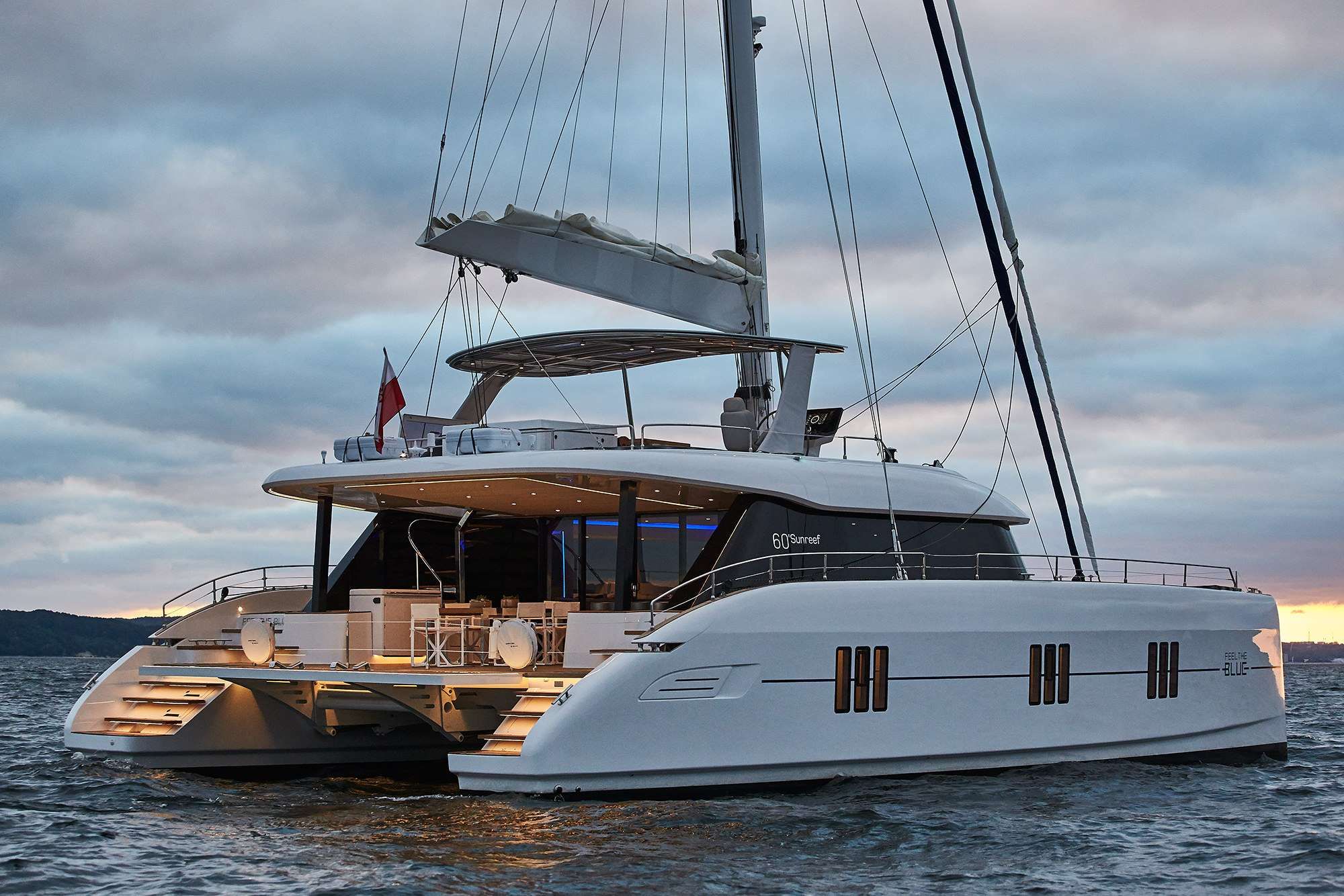
Sleeps 8 guests in 4 Cabins
Size: 60 Ft
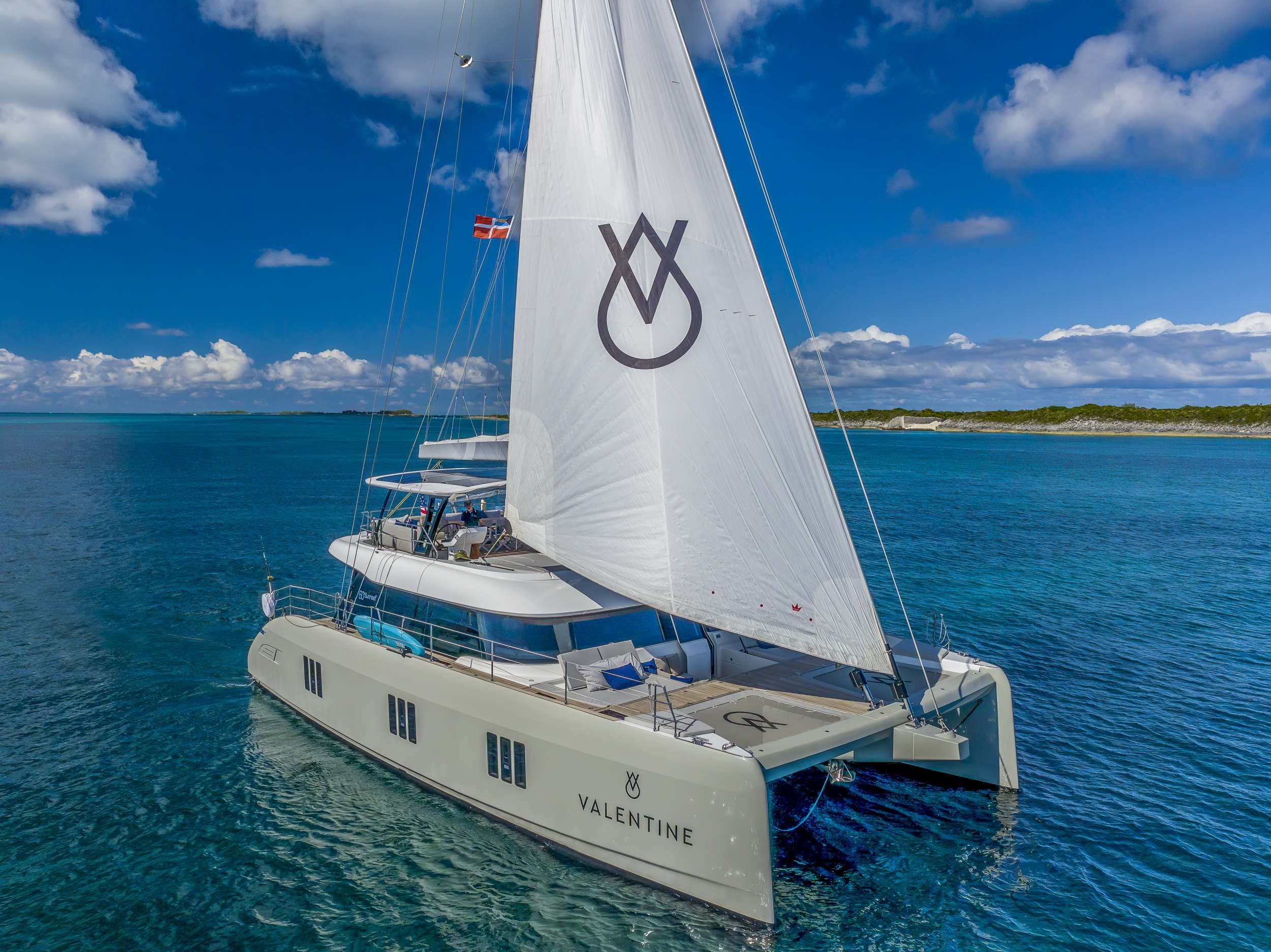
Sleeps 10 guests in 5 Cabins
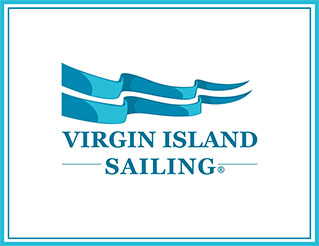
- Yacht Type: Sailing Catamarans
- Charter Type: Crewed Charters
Destination
Weekly rates.
- Start Time: 12:00 PM
- End Time: 12:00 PM
Rate Details
The charter fee includes captain, professional chef, 3 meals each day (unless an alternate meal plan is chosen), full ship’s bar, water toys and onboard amenities. Not included are gratuity, special/vintage alcohol requests and dockage if preferred by the client.
RELENTLESS II 80 Crewed Charters in British Virgin Islands
$ 13,428.00
Loading ...
Guest Comments
Relentless II, a 2022 Sunreef Yacht 80-foot sailing catamaran, is the perfect vessel for an unforgettable sailing vacation in the Caribbean British Virgin Islands. Her sleek design, spacious accommodations, and abundance of amenities, including an expansive flybridge with sun beds, couch and chairs, a large Jacuzzi nestled by sapphire lounge beds, and a wide range of watersports equipment, offer guests the ultimate in luxury and comfort. After a day of fun in the sun, indulge in a refreshing rinse under the gentle cascade of the cockpit rainfall showers. Each of the four cabins has its own en-suite bathroom, ... Learn More and the primary cabin features a king-size bed, desk/vanity, walk-in closet, and sofa that converts into a kid's bed. The ample main salon, upholstered in aquamarine and sapphire tones, evokes the beauty of the ocean itself. Opposing U-shaped lounges flank a central dining area. The bow boasts a cozy conversational space with couches and occasional tables. The flybridge is an oasis of relaxation with sun beds, a lounging couch, chairs, and a large Jacuzzi. Her highly skilled and experienced crew is passionate about making your vacation dreams a reality. With everything you need to create a truly unforgettable vacation, Relentless II is the perfect choice for your next sailing adventure.
- Yacht Details
- Meet your Crew
Special Offers
- Reviews (0)
- Yacht Name: RELENTLESS II 80
- Manufacturer: Sunreef Yachts
- Yacht Age: 2022
- Yacht Length (Feet): 80
- Beam (Feet): 38.5
- Max Passengers: 8
- Electric Heads: 4
- Total Showers: 4
- King Cabins: 1
- Queen Cabins: 3
- Yacht Layout
Electronics
- WiFi: Onboard WIFI
- TV / DVD Player
- Stereo: Yes
110V & 220V
- Water Maker
Standard Items
- PFDs & Safety Equipment
- Linens and towels: Yes
- First Aid Kit
- Air Conditioning: With Generator
Water Toys / Entertainment
- Dinghy: 16' center console
- Outboard: 90hp
- Snorkeling gear: Yes
- Stand Up Paddle Board: Yes
- Stand Up Paddle Board Number Allotted: 4
- Floats: Yes
- Children Skis
- Board Games
- Beach Games
Two cockpit rainfall showers
Massage therapist and wellness coach onboard 4 SUP 2 kayaks 2 Kayoga 1 floating dock 1 Giga 7person sup 2 Jet Boards 2 Sea Bobs Snorkel gear 1 wakeboard 2 ski 1 kneeboard
Deep Sea fishing not offered onboard can be arranged by crew at guest’s expense.
All amenities available at this time and up to date. While every effort will be made to stay up to date, unforseen circumstances may result in substitutions or unavailability. Float Mats
Scuba & Fishing
- Scuba Diving: Rendezvous With Dive Company
- Scuba Diving Resort Course
- Full Course
- Scuba Costs: Yacht provides 3 dives per week with up to four divers per dive. Additional dives may be available on request, subject to negotiation with the Captain.
- Scuba Details: Divers will be required to sign a liability waiver.
- Scuba Compressor On Board: Yes
- Number of BCs: 8
- Number of Regulators: 8
- Number of Wet Suits: 8
- Number of Weights: 8
- Number of Divers: 4
- Number of Dives: 3
- Number of Dive Lights: 8
- Fishing Gear On Board: Yes
- Fishing Gear Type: Trolling, casting, & bottom fi
- Number of Fishing Rods: 4
- Guest Fishing License Required: Yes
- Yacht Registered For Fishing (BVI): Yes
Crew Details
- Number of Crew: 4
- Sample Menu
- Captain Name: Magnus Wittersø
- Captain Nationality: Norway
- Captain Age / Born: 1988
- Captain Licenses: RYA YACHTMASTER OFFSHORE 200T/ USCG 100T
- Chef Name: Katie Saunders
- Chef Nationality: USA
- Chef Age / Born: 1987
- Chef Licenses: STCW
- Languages: English
- Crew Smokes: No
- Yacht Brochure
Purified Drinking Water. Reusable Water Bottles.
- Pet Type: N/A
- Accommodate Special Diets
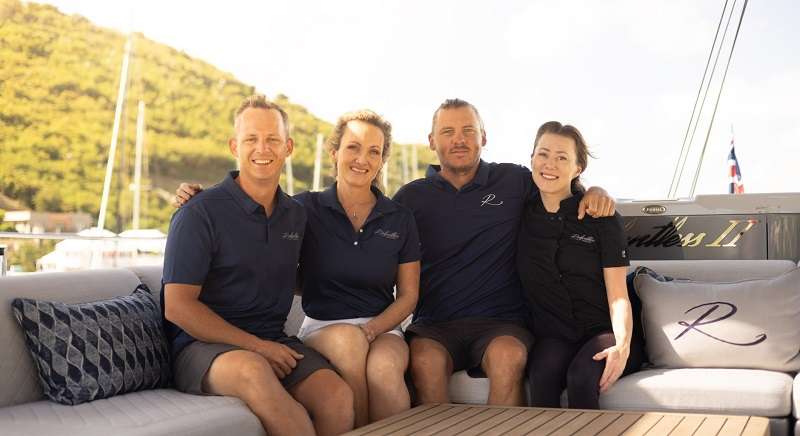
Not found special offers
Customer reviews, be the first to review “relentless ii 80 crewed charters in british virgin islands”.
Review title
Your Rating Rate… Perfect Good Average Not that bad Very Poor
Your Review
There are no reviews yet.
Cancellation Policy
If you need to cancel, there is no refund unless we are able to resell your charter dates. Trip insurance is highly recommended.
Minimum # of Nights
Payment schedule.
More Than 6 Months Prior to Charter Start: 25% of the Charter Fee is Due 6 Months Prior to Charter Start: 50% of the Charter Fee is Due 45 Days Prior to Charter Start: Full Charter Fee + Additional Fees (if Applicable) are Due
Request Confirmation
Terms and conditions, charter experts, llc terms & conditions.
PLEASE READ THESE TERMS AND CONDITIONS (“ Terms ”) CAREFULLY AS THEY CONTAIN IMPORTANT INFORMATION REGARDING YOUR LEGAL RIGHTS, REMEDIES AND OBLIGATIONS AS WELL AS A SECTION GOVERNING THE JURISDICTION AND VENUE OF DISPUTES. THESE TERMS ALSO CONTAIN A LEGALLY BINDING RELEASE, WAIVER OF LIABILITY, AND ASSUMPTION OF RISK. By creating a username, a login, clicking submit, using the services of Charter Experts, LLC d/b/a Virgin Island Sailing® (“ Broker ) or by accessing Broker’s website, you agree that you have read, and acknowledge your acceptance of these Terms. The Terms are subject to change at any time without notice at Broker’s sole discretion. Additionally, any transaction for which you have made payment shall be governed by the form of Terms in effect at the time of such payment notwithstanding any subsequent changes hereto.
If you are obtaining a quote, information, booking travel for and/or securing or procuring a Charter (as that term is defined in Section 1 below) for more than just yourself, all references below to “Charterer” or “you” (and derivations thereof) shall be read to mean you on behalf of yourself and each individual within your group for whom you are obtaining a quote, information, booking travel for and/or securing or procuring Charter.
These Terms shall be read together and construed, to the fullest extent possible, to be in concert with any other agreement by or among Broker and Charterer. To the extent they cannot be so construed, then in the event of any direct conflict between these Terms and any other agreement by or among Broker and Charterer (including but not limited to the agreement executed by Charterer for a Charter Reservation (as that term is defined in Section 1 below), these Terms shall prevail.
- Prepaid Charter Reservations . Typically, Broker negotiates charter rates in advance with the yacht owner or charter company (“ Charter Provider ”) to obtain cost-effective rates, and facilitate reservations and availability for yacht charters, excursions and travel (the “ Charter ”). Broker also provides services to you by facilitating the booking of reservations for consideration and receives a commission from the Charter Provider (the “ Broker Fee ”). The Broker Fee is included in the pre-negotiated Charter rate provided to you, plus taxes and other fees where applicable. You agree that your payment is for the total amount set forth in the applicable Charter agreement (which Charter Provider may refer to as a Charter Contract, Charter Agreement, Booking Terms & Conditions, Instructions and Terms for Accommodations, as well as other derivations) provided to you by Broker (“ Charter Agreement ”). Upon execution of the Charter Agreement and receipt of the applicable deposit, you will have made a reservation for the Charter that authorizes Broker to facilitate the Charter on your behalf (“Charter Reservation”), including making payment arrangements with the Charter Provider. You further agree that Broker is a third-party beneficiary to the Charter Agreement and shall have the right to enforce such agreement to the extent it deems such enforcement necessary or advisable to protect its rights hereunder or under the Charter Agreement.
Broker retains the Broker Fee as compensation in arranging your Charter Reservation. The Broker Fee varies based on the amount and type of Charter and/or services provided by Broker. By making a Charter Reservation, you accept and agree to the relevant cancellation and no-show policy of the Charter Provider set forth in the Charter Agreement. Cancellation and no-show policies vary for each Charter. Carefully read the Charter Agreement and additional information provided to you by Broker. It is expressly agreed by Charterer that the Broker Fee is earned at the time the Charter Reservation is made. Late payment, wrong credit card or debit card details, invalid credit or debit cards, or insufficient funds are for your own risk and account, and you will not be entitled to any refund of any prepaid amount unless the Charter Provider expressly agrees otherwise under the Charter Agreement or in some other signed writing.
- Charter Rules and Restrictions . Additional terms and agreements will apply to your Charter Reservation and any purchase or rental of equipment or other items, supplies, provisions and travel you may select. Please read those additional terms carefully. In particular, if you have purchased airfare, please ensure that you read the full terms and conditions of carriage issued by the supplier. You agree to abide by the terms of purchase imposed by any supplier with whom you elect to deal, including but not limited to payment of all amounts when due and compliance with the supplier’s rules and restrictions regarding availability, charges, fares, and use of products and services.
- Payment . All payments must be made by personal check, bank/wire transfer, ACH payment and/or with a major credit card unless otherwise expressly stated. The total price for the Charter Reservation will be billed in U.S. Dollars unless otherwise stated. Some banks and credit card companies impose fees for international transactions. If you are making a reservation from outside of the United States on a US credit card, your bank may convert the payment amount to your local currency and charge you a conversion fee. This means the amount listed on your credit or bank card statement may be in your local currency and therefore a different figure than the amount provided by Broker for the Charter Reservation. In addition, a foreign transaction fee may be assessed if the financial institution that issued your credit card is located outside of the United States. Booking international travel may be considered to be an international transaction by the financial institution or card company. The currency exchange rate and foreign transaction fee is determined solely by your financial institution on the day that it processes the transaction. If you have any questions about these fees or the exchange rate applied to your booking, please contact your financial institution. Broker shall not be liable to you for any such service, conversion, or exchange fee.
Broker expressly reserves the right to cancel your Charter Reservation if full payment is not timely received as set forth in the Charter Agreement.
- Cancellation and Rescheduling . You may cancel or change your Charter Reservation as set forth in the Charter Agreement by and among you, the Charter Provider and/or Broker. Please note that some Charter Providers do not permit changes to or cancellation of reservations after they are made, or after a certain date, as indicated in the Charter Agreement. You agree to abide by the terms of the Charter Agreement with respect to your Charter Reservation. Broker will not be responsible for reimbursing Charterer for any previously tendered deposits or payments by Charterer and disclaims all liability for the failure of a Charter Provider to refund or return any such funds.
- Credit Card Transactions and Chargebacks . If for any reason, any Charter Provider is unable to provide the Charter, or any part thereof, for which you have contracted, your remedy lies against the Charter Provider, and not against Broker. However, Broker will use reasonable efforts to assist you and Charter Provider in reaching a resolution to a dispute between you and the Charter Provider. In the event that your payment has already been transferred from Broker to Charter Provider or to an escrow account, you agree that you will not seek a chargeback against Broker for such amounts transferred. You further agree to indemnify and hold Broker harmless from and against any liability, loss, damage or expense (including without limitation, reasonable attorneys’ fees) that Broker may incur in connection with chargebacks against Broker or under the Charter Agreement and your performance thereunder. If Broker incurs any costs, including but not limited to attorneys’ fees, to recover any payments charged back by your credit card company or other financial institution, you agree that you will be liable for these costs. If your payment is declined for any reason, you agree to settle any amounts owed to Broker via money order, cashier’s check, personal check or bank/ACH transfer immediately.
- Broker Responsibility . Broker makes arrangements with the Charter Provider. Broker additionally makes additional arrangements with other suppliers for the various components and other services that comprise your Charter (“Charter Suppliers”). Broker is not an agent of these Charter Providers or the Charter Suppliers (and the Charter Providers and Charter Suppliers are not agents of Broker). Broker expressly disclaims any liability for the actions or omissions of the Charter Provider and the Charter Suppliers. The Charter Providers and the Charter Suppliers reserve the right to refuse service to you at their sole discretion. Broker assumes no liability for the acts of the Charter Provider or the Charter Suppliers in refusing service. Broker is not responsible for schedule changes and does not offer compensation for those changes. Broker is not responsible under any circumstances for any injury or damages you may suffer, in connection with sea, air or ground transportation, hotel accommodations, or other travel or excursion services arranged by Broker.
You understand Broker is not the source or supplier of the Charter or other travel services you requested and acts solely as a broker for the Charter Provider and the Charter Suppliers. You agree that the Charter Provider and Charter Suppliers whose names appear in the information supplied to you are those who are solely responsible for providing the Charter you purchase. You consent to and request the use of the Charter Provider and the Charter Suppliers and agree to not hold Broker responsible should any of them: (i) fail to provide the Charter or travel services you purchased, whether or not such services are listed in the Charter Agreement or otherwise, (ii) fail to comply with any applicable law, or (iii) engage in any negligent act or omission that causes you any sort of injury, damage, delay or inconvenience.
By using Broker’s services, you waive and release any claim against Broker, its affiliated and subsidiary companies, and their respective officers, directors, employees, contractors, and agents, arising out of or in connection with any loss of or damage to property or injury to any person caused by reason of (i) any defect, negligence, or other wrongful act or omission, or any failure of performance of any kind, by any Charter Provider, Charter Suppliers, or any other provider of sea, airline, hotel, ground transportation or any other travel provider connected to or otherwise associated with the Charter, (ii) any claim for inconvenience, loss of enjoyment, mental distress or other similar claim, (iii) any delayed departure, missed connection, substitute accommodation, termination of service or change in fares or rates, and (iv) overbooking, flight or other travel cancellation, lost or misconnected personal property, or any claim arising out of the air transportation portion of your travel, and (v) or any other claim arising out of or otherwise related to the Charter Agreement or services provided by the Charter Provider and the Charter Suppliers.
Excepting only liability that directly arises from the gross negligence or willful misconduct of Broker, you will not hold Broker responsible for any injury, damage or loss you may suffer while on a Charter, whether incurred on the Charter or in connection with any other rental, purchase, excursion or activity, regardless of the relationship of any of the foregoing with the Charter Provider or the Charter Suppliers.
- Your Responsibility . By booking a Charter with Broker, you agree to defend and indemnify and hold harmless Broker, Charter Provider, Charter Suppliers, and each of their respective officers, directors, employees and agents, from and against any and all claims, causes of action, demands, recoveries, losses, damages, fines, penalties or other costs or expenses of any kind or nature, including but not limited to reasonable legal fees, arising out of or in connection with: (i) your breach of these Terms or the documents referenced herein; (ii) your violation of any law or rights of a third party; or (iii) your use of the Broker website.
You will review your Charter Agreement and travel documents for accuracy upon receipt. You understand that it is your responsibility to review the accuracy of all details in the Charter Reservation provided to you, and that you may contact Broker if you have any questions.
You assume full and complete responsibility for checking and verifying any and all passport, visa, vaccination, or other entry requirements of your destination(s), and all conditions regarding health, safety, security, political stability, and labor or civil unrest at such destination(s).
You understand that Broker recommends purchasing travel insurance to cover certain risks inherent in travel such as supplier bankruptcy and the inability to travel due to a medical or personal emergency.
- No Warranties . All Charters, products, services, advice and information is provided on an “as is” and “as available” basis without warranties of any kind, either expressed or implied to the fullest extent permitted under the law, including but not limited to, warranties of title or implied warranties of merchantability, satisfactory quality or fitness for a particular purpose. Without limiting the above, no warranty or guarantee is made (i) regarding the acceptance of any reservation request or Charter Reservation; (ii) regarding the availability of Charters, or any other product and/or services through Broker; (iii) that the use of Broker’s website will be error-free; or (iv) regarding the completeness, accuracy, reliability or quality of any information, content, data, service, advice or merchandise provided by Broker or through Broker’s website.
Broker has no special knowledge regarding the Charter Provider’s or Charter Supplier’s financial condition, unsafe conditions, health hazards, weather hazards, or climate extremes at locations to which you may travel during or otherwise in connection with your Charter.
- Limitation on Liability . In no event shall Broker, Charter Provider, Charter Suppliers, and/or their respective affiliates, or any employees, agents, officers, directors, members or managers of any of the foregoing (“Broker and Charter Releasees”), be liable for any direct, indirect, punitive, incidental, special or consequential damages arising out of, or in any way connected with, your access to, display of or use the Broker’s website, the Charter or services provided to you in connection with the Charter (including, but not limited to, your reliance upon opinions of the Broker), whether based on a theory of negligence, contract, tort, strict liability, consumer protection statutes, or otherwise, and even if Broker and/or any other of the Broker and Charter Releasees have been advised of the possibility of such damages.
If, despite the limitation above, Broker or the Broker and Charter Releasees are found liable for any loss or damage which arises out of or in any way connected with any of the occurrences described above, then Broker, Charter Provider, Charter Supplier and the Broker and Charter Releasees will in no event exceed, in the aggregate, the greater of (a) the Broker Fee, and (b) One-Hundred Dollars (US $100.00).
The foregoing limitation of liability reflects the allocation of risk between the parties. The limitations specified in this section will survive and apply even if any limited remedy specified in these Terms is found to have failed of its essential purpose. The limitations of liability provided in these Terms inure to the benefit of Broker and/or its providers.
The foregoing does not affect any liability which cannot be excluded or limited under applicable law.
- Limitation on Time to File Claims . ANY CAUSE OF ACTION OR CLAIM YOU MAY HAVE ARISING OUT OF RELATING TO BROKER’S SERVICES OR THE WEBSITE MUST BE COMMENCED WITHIN ONE (1) YEAR AFTER THE CAUSE OF ACTION ACCRUES, OTHERWISE, SUCH CAUSE OF ACTION OR CLAIM IS PERMANENTLY BARRED.
- Waiver . No waiver by Broker of any term or condition set forth in these Terms shall be deemed a further or continuing waiver of such term or condition or a waiver of any other term or condition, and any failure of the Broker to assert a right or provision under these Terms shall not constitute a waiver of such right or provision.
- Severability . If any provision of these Terms is held by a court or other tribunal of competent jurisdiction to be invalid, illegal or unenforceable for any reason, such provision shall be eliminated or limited to the minimum extent such that the remaining provisions of the Terms will continue in full force and effect.
- Governing Law and Mandatory Venue . The laws of the State of Florida govern the rights and obligations of the parties to this Agreement and the interpretation, construction and enforceability thereof. You agree that any action or proceeding initiated by Charterer against Broker shall be brought solely in the federal and state courts of Hillsborough County, Florida, and you submit to the jurisdiction of those courts and waive any objections to the exercise of personal jurisdiction over you by those courts. In the event any action or proceeding is initiated by Charterer in a court outside of Hillsborough County, Florida, Charterer agrees to pay Broker’s costs and reasonable attorneys’ fees associated with defending such action or proceeding and waives any and all defenses to the transfer of said action or proceeding, whether jurisdictional or otherwise, to a federal or state court in Hillsborough County, Florida.
Next Steps ...
Ready for the vacation of a lifetime, there’s no cost to you for our service.
Privacy & Terms | Sitemap | Copyright © 2024 Virgin Island Sailing® All rights reserved | [email protected] | (800) 382-9666 | (941) 966-9387 | Tampa, FL

Relentless ll 80ft Catamaran
Low season rate, high season rate, boat length, number of cabins, number of people.
Relentless ll is an 80ft Sunreef catamaran sleeping 8 guests in 4 cabins. The master cabin has a king bed then the remaining 3 have queen beds. Yacht is fully airconditioned and each room has its own temperature control. There is two rainfall cockpit showers, sat WiFi and a Jacuzzi on deck. Massage therapist and wellness coach onboard

Cruising Area
Pref. Pick-up : YHG St Thomas, Other Pick-up : Nanny CayBVI & SXM. Yacht is USVI based, but legal for BVI charters, Yacht Haven Grande ports for charters starting/ending in St Thomas, Nanny Cay ports for charters starting/ending in BVI Inquire for availability in GRENADINES for summer season. Summer & Winter Base Port: USVI. Summer & Winter Operating Area: Caribbean Virgin Islands (US/BVI), Caribbean Leewards, Caribbean Virgin Islands (US), Caribbean Virgin Islands (BVI)
Full Yacht Amenities
- Sat. TV and device hookups
- Hairdryers : No smoking allowed onboard
- Onboard Sat. WIFI
- Water Maker
- Dinghy with 90 hp engine
- Snorkel Gear
- Tube & Wake Board
- 4 SU Paddle Boards
- Fishing Gear
- Fishing Permit : USVI only
- Two cockpit rainfall showers
- Massage therapist and wellness coach onboard
- 2 x E-foils
- Deep Sea fishing not offered onboard can be arranged by crew at guest’s expense.
Charter Information
All rates are for the entire boat and are subject to change without notice prior to actual reservation Charter Fee does not include a customary gratuity in the amount of 15-20% of the total charter fee payable to a deserving Captain and Crew upon the completion of a successful charter. All guests over 18 yrs wishing to fish in BVI must purchase a BVI license prior to boarding ask us for information. Marina dockage if applicable upon the request of the charter guests is not included. Fine wines champagnes and top shelf liquors are not included and can be purchased upon request of the charter guests at their expense. Hurricane Season is from 1st June to end of November and it is imperative that all guests purchase trip insurance. Yacht's are not responsible for clients shore side expenses if charter cancelled for a named storm (this includes meals hotels transportation as well as air transport) Most yachts will allow client to rebook unused dates within 6 months of cancellation (excluding holidays).
Yacht Rates in USD
| 2 pax | 3 pax | 4 pax | 5 pax | 6 pax | 7 pax | 8 pax | |
| S 2023 | 94,000 | 95,000 | 96,000 | 97,000 | 98,000 | 99,000 | 100,000 |
| W 2023/24 | 94,000 | 95,000 | 96,000 | 97,000 | 98,000 | 99,000 | 100,000 |
| S 2024 | 94,000 | 95,000 | 96,000 | 97,000 | 98,000 | 99,000 | 100,000 |
All inclusive rates are based on a 7 night charter (1 week) with food, beverages and standard bar, cruising permits and licenses are paid by boat. Taxes, relocation fees may be extra, see below for Charter Information
Charter Fee does not include a customary gratuity in the amount of 15-20% of the total charter fee payable to a deserving Captain and Crew upon the completion of a successful charter.
Full board only, no sleep aboard. No smoking whatsoever allowed on board. Included in contract specials conditions.
RELENTLESS AIR: The Yacht has a jet. Inquire for rates.
2022/2023 CHRISTMAS/NEW YEARS: 7 night minimum. CHRISTMAS 2023: 1-8 guests @ $125,000. Must end by Dec 26. NEW YEARS 23/34: 1-8 guests @ $125,000. May not start prior to Dec 28.
MASSAGE: The masseuse on board is a Licensed Massage Therapist Each guest is offered 1 massage of their choice during charter. Extra massages may be arranged at additional cost if time permits. Guests will need to discuss pricing and make arrangements directly with the masseuse.
Yacht offers Rendezvous Diving
Crew Information

Relentless ll has a crew of 4, Captain: Magnus Wittersø from Norway, Chef: Katie Saunders from USA, Rita Fogta form Hungary and Heather Hessler from Virgin Islands.
Captain - Magnus Wittersø Captain Magnus hails from the frigid fjords of Norway with several captains in his blood line. He spent his entire childhood regatta racing, teaching sailing and working for the King in the Norwegian Navy before he felt himself being drawn to far more tropical latitudes. Now, thawed out, and after several years of cruising on his private sailboat, multiple ocean crossings and chartering the most stunning waters and island groups in the world, he can guarantee a fantastic experience with well thought out itineraries and adventures.
Chef - Katie Saunders Chef Saunders is a small town girl with big world experience and is excited to bring her knowledge of food and fine dining to your vacation! With background in catering, resort event planning, cafes, and organic eateries. Katie has always had a passion for cooking and entertaining. Her career brought her to the sunny island of St Thomas, where she fell in love with the simple, sweet way of island life. Soon after, the opportunity to cook on the water presented itself and she dove into the world of yachting. As a luxury yacht chef and chief stewardess with 6+ years experience operating luxury yacht charters throughout Caribbean, she will amaze you with her incredible food and warm hospitality!
Stewardess/Masseuse - Rita Fogta Chief Stewardess and Massage Therapist Rita Fogta was born and raised in Hungary, but her passion for travel led her to voyaging around the world, including exotic locations such as Thailand, Bali, Hawaii, and the Virgin Islands. Her life goal of helping people, made her trade in her office job to become a full time massage therapist, working with clients at internationally renowned hotels and spas. Combining her passions for travel and massage, it was just a matter of time before the yachting industry became her calling. Nothing makes Rita happier than seeing relaxed and happy guests onboard, and she’s always ready to provide the extra touches that make a vacation special. As an accomplished mixologist Rita spends her down time crafting new cocktail recipes. Her elixirs are as enchanting as she is.
First Mate - Heather Hessler 1st Mate Heather has been exploring the Virgin Islands by sea for over 20 years. Her passion for surfing first brought her to the BVI’s at the age of 12. She settled in the Island of St. Thomas where she attended the University of the Virgin Islands. While in college, Heather worked at one of the top restaurants on island. There she mastered her skills in mixology, fine wine, and five star service. The Virgin Islands have been home ever since. Heather is passionate about the island history and culture. Heather started in the maritime industry 7 years ago, she has now earned a 100ton USCG Captain’s License. Heather loves using all the skills that she has acquired in different roles on yachts over the years to provide the ultimate guests experience. Whether it be a hike and history tour, best snorkel spots, surf lessons, fishing or maybe just a really good cocktail, Heather is there to make your vacation dreams come true.
Sample Menu
Breakfast Plates – For more photo representation of my work, please visit my Instagram @kate_paints_the_plate
Bacon & Leek Quiche (GF O/A) Served With Side Of Chicken Sausage & Topped With Locally Grown Kale Microgreens Salad
Passionfruit Eggs Benedict Poached Egg, Sweet Plantain Cakes, Pork Belly & Passionfruit Hollandaise
French Omelet Served With A Fresh Baked Croissant & Thick Cut Applewood Smoked Bacon
Stuffed Sweet Potato Roasted Sweet Potatoes Stuffed With Sautéed Apple, Cinnamon, Banana With Side Of Sliced Brie & Thick Cut Applewood Smoked Bacon
Bacon Egg & Cheese Bagels Applewood Smoked Bacon, Aged Cheddar Cheese & Egg On Fresh Made Bagels With Side of Hash Browns
Huevos Rancheros Two Sunny Side Up Eggs Over Black Bean & Roasted Red Pepper Puree, Fresh Pico De Gallo, Roasted Salsa, Cotija Cheese, Avocado Over Warm Corn Tortilla With Lime Cheeks & Cilantro
Relentless Pancakes Buttermilk Pancakes With Choice of Fruit Topping, Canadian Maple Syrup Served With Applewood Smoked Chicken Sausage
Scotch Eggs Two Soft Boiled Eggs Encased In Breakfast Style Sausage Over Savory Porridge & Sautéed Spinach
Frangelico French Toast Infused French Toast Topped With Maple Whipped Ricotta Cheese & Bacon Crumble
Lox & Bagel Freshly Made Everything Bagels, Smoked Lox, Whipped Herb Cream Cheese, Capers, Pickled Red Onions, Sliced Cucumbers, Tomatoes & Kale Micogreens. Served With Side Of Soft Boiled Quail Eggs & Bacon
Lunch Plates
Mahi & Burrata Salad Locally Caught Mahi Over Ovation Greens, Creamy Italian Burrata, Cherry Tomatoes & Asparagus Tips, Topped With Basil Pesto & Radish
Hand Rolled Sushi With Edamame & Seaweed Salad Blackberry Salmon Roll Salmon, Blackberry Cream Cheese, Avocado & Carrot Spicy Tuna Roll Honey, Soy, Ginger Marinated Tuna, Cucumber, Carrot, Avocado & Sriracha Aioli Rancher Roll (Non-Fish Option) Chicken, Bacon, Carrot & Avocado Topped With Buttermilk Ranch, BBQ, Bacon, Chive & Bacon Fat Panko Crunchies Tuna Sushi balls Tuna & Nori Rice Balls Topped With Honey Soy Reduction & Toasted Sesame Seeds
Seared Wild Caught Salmon & Grapefruit Salad Crispy, Skin-On Salmon Over Locally Grown Ovation Greens, Grapefruit Supreme, Shaved Green Apples, Fennel, Fire Roasted Kumquats, Avocado Creme & Feta, Topped With Grapefruit Vinaigrette
Roasted Beet Salad Roasted Red & Golden Beets, Baby Arugula, Shaved Red Onion, Zhoug, Puffed Quinoa, Whipped Labneh & Pistachio Crumble
Marinated Ahi Tuna Bowls Ginger, Soy & Honey Marinated Sake Tuna Over Shaved Carrots, Red Cabbage, Radish & Sticky Rice With Shiitake Sesame Dressing & Avocado
Cuban Thick Cut Ham, Slow Roasted Pork, Aged Swiss Cheese, Boat-made Pickles, Dijon Mustard On Crispy Grilled Loaf With Sweet Potato Parmesan Fries
Signature Pizzas All pizzas are made fresh before your eyes! With this interactive lunch the possibilities are endless! Please indicate any special pizzas or toppings on your preference sheets so we may customize the perfect pie for your upcoming trip! Margarita Slow Roasted Tomato Sauce, Fresh Mozzarella Topped With Fresh Basil & Drizzled With Olive Oil Pepperoni Slow Roasted Tomato Sauce, Fresh Mozzarella, Spicy Pepperoni Topped With Aged Parmesan & Fresh Basil Pork & Blue Sausage & Gorgonzola Pizza Topped With Pickled Red Onions, Pickled Mustard Seed Topped With Local Microgreens & Prosciutto Mushroom & Onion Baby Portobello & Bunashimeji Mushrooms, Caramelized Onions, Chopped Garlic, Mozzarella, Aged Parmesan Topped With Arugula & Truffle Oil Berries & Cream Blackberries, Raspberries & Blueberries Over Honey Whipped Ricotta It’s Bananas! Nutella Pizza Topped With Roasted Bananas & Dusted With Shaved Grenadian Chocolate
Starter Plates
Arancini Crispy Italian Rice Balls Stuffed With Mozzarella & Herbs, Coated In Bread Crumbs Over Roasted Red Pepper & Goat Cheese Puree
Crispy Tuna Wonton Nachos Fresh Marinated Tuna Over Warm Wonton Nachos, Edamame, Shaved Radish, Green Onion, Purple Cabbage, Topped With Sweet & Tangy Soy Marinate, Sriracha & Wasabi Aioli
Baked Brie Creamy, Melted Brie & Fig Wrapped In Crispy Warm Filo Dough Served with Fresh Fruit & Crackers
Rocket & Strawberry Salad Baby Rocket, Strawberries, Toasted Shaved Almonds Tossed In Strawberry Vinaigrette Topped With Feta & Lemon Zest
Foie Gras Pan Seared Served With Rich Red Wine Port Sauce, Green Grapes & Crusty Loaf
Shrimp & Tuna Tartare Diced Spicy Marinated Shrimp &Tuna With Avocado In Cucumber Coulis
Dinner Plates
Sea Bass Crispy Seared Sea Bass Over Garlic Whipped Pomme Puree, Asparagus, Beurre Blanc & Passion Fruit Butter
Filet Mignon Grass-Fed New Zealand Tenderloin Medallions Over Creamy Smoked Gouda Polenta, Roasted Heirloom Carrots, Fondant Potato, With Port Red Wine Reduction
Snapper Crispy Skin Snapper Over Pea Risotto, Radish, Sweet Corn Foam & Prosciutto
Braised Short Rib Raviolis Boat-Made Red Wine Braised Short Rib Raviolis In Truffle Cream Sauce Topped With Shaved Spring Truffles & Basil Microgreens
Duck Seared Duck Over Cauliflower Puree, Tatsoi, Asparagus, Bunashimeji, Duck Fat Potato Terrine & Duck Demi-glace
Octopus Grilled Octopus Over Romesco, Charred Corn Ribs, Hasselback Potatoes, Broccolini, Chimichurri & Toasted Almond
Caribbean Lobster Butter Poached Caribbean Lobster Tails Over Cream Sweet Corn Puree, Haricot Vert & Cherry “Bomb” Tomatoes
Lamb Chimichurri Encrusted Lamb Lollipops Over Grilled Vegetable Couscous
Scallops Seared Scallops Over Pancetta & Tomato Corn Salad Tossed In Warm Bacon Vinaigrette, Crispy Prosciutto & Avocado Foam
Pork Pork Schnitzel Over Celeriac & Apple Remoulade & Fried Local Egg
Dessert Plates
Award Winning Vegan Chocolate Torte With Strawberries & Chocolate Shavings
Lemon Curd With Raspberries, Bee Pollen, Raspberry Dust & 14K Gold
Pavlova Kisses With Fresh Strawberries, Kiwi, Strawberry Coulis & Strawberry Dust
Flourless Chocolate Torte Topped With Chocolate Ganache & Fresh Berries
Browned Butter Chocolate Chunk Ice Cream Cookie Sandwiches
Classic Tiramisu
Lemon Posset With Mint & Berries
Boat-Made Ice Cream (Inquire for flavors or request something special!)
Spice Island Carrot Cake
Chilled Red Wine Poached Pears With Pistachio Crumble & Boat-Made Vanilla Ice Cream
Testimonials from guests on Relentless ll 80ft Catamaran
March 2023 It’s hard to know where to start to describe the amazing week we have had aboard Relentless II. Not only did we love learning about the islands from our knowledgeable captain and crew, we loved playing with the crew on all of the toys and getting to know you all. Katie’s meal were delicious and we ate way too much. We loved her passion for her work. Rita is the perfect hostess and so talented. We loved all of her inventive cocktails and therapeutic massages. Heather is a pro and we always felt safe in her capable hands. The trip was fantastic and the boat beautiful. We have made memories to last a lifetime. You are all the best of the best! Deborah, Michael, Christina, Bela, Bronwyn, Kim & Peter
What an amazingly special week! Relentless II is a fabulously comfortable home.
Captain Magnus, Heather, Riita and Katie are the most incredibly warm, friendly helpful people. All of whom made the week ultra special
Our excursions, hikes beach walks, water fun with toys, snorkling, paddling – all a blast! Food drinks an fun on board was the best ever.
Thank you all for making this an ultra fun experience. Hope to see you next year !
-Nita & James
January 2023 We had an amazing time on Relentless II. The staff was wonderful and so helpful. We couldn’t have asked for a more relaxing fun vacation. Our girls loved everything. The food was fantastic and the cocktails were phenomenal. The beaches we visited and the watersport activities were so much fun. – Brandon Marah and Harper
January 2023 It is difficult to give enough thanks to the crew for their Relentless pursuit of hospitality. This is how it is done. Amazing, luxurious and spacious boat with every amenity and water toy. Superlative food and drink. Avail yourself of the relaxing massages and the delicious cocktails! Pro tip: Fly Relentless Air to the boat! Thanks Magnus, Heather, Rita and Katie for the experience of a lifetime
– Lawrence & Jitka
December 2022 Captain Bret, Chef Katie & Rita – you are the most incredibly fabulous crew and we will never ever forget our time aboard the spectacular Relentless. From the sails, hikes, swims, “Lime Out” excursion, peaceful coves, massages (we are all converts now) the unbelievably over the top amazing meal after meal (we photographed every one!) and oh – those never ending cocktails. Everything was magical, perfec,t memorable, and glorious. We can’t even imagine the amount of effort you all put in to make this week seem effortlessly perfect. Thank you! Please keep in touch so we can do this again! – Julie
January 2023 Oh my goodness, what an incredible trip! It was the perfect balance of adventure, fun and relaxation. We had so many opportunities to bond as a family and there is no greater gift than connection between one another.
Rita – Your energy is so pure. It is so apparent you lead with your heart and your heart is full of kindness Plus your cocktails are killer. Heather – you’re a badass. Your knowledge of the islands was not only helpful but made the trip more personal. Katie – you kept us perfectly fed! Your menus were everything we wanted. Comforting, clean fun and balanced Ian – Thank you for going with the flow. You hit all the spots we had hoped for. Thank you for giving us a forever memorable trip. – Jeff, Blair, Pryce & Rara
Enquire about this charter today.
All of our charters are personalised, so we will tailor your holiday to you.
Choose Your Dates
Press the down arrow key to enter the datepicker and choose two dates. Navigate dates with arrow keys and skip to previous and next month with ctrl + left and ctrl + right
- Tower Suite Collection
- Drink & Dine
- Harborside Pool Club
- Holidays & Events
- Tennis & Pickleball
- Water Sports
- Spa Palmera
- Meetings & Events
- Celebrations
- Boca By Design
Yacht Charters
Meet Relentless , your personal 42-foot classic cruising yacht. A luxury Wesmac boat, this is the newest jewel in our fleet, designed entirely to take you on one-of-a-kind experiences with friends or family. Choose from one of our private Extraordinary Experiences, available exclusively to Club members and resort guests. Captained cruises offer an array of possibilities, from activity-filled adventures to sunset excursions along the Intracoastal. Make each trip your own – during your scheduled sailing, your captain will cruise or anchor at your whim. For parties of up to 12 people.
- Wednesday-Sunday
Special dates and times may
be available upon request
Experiences for all ages
Parties up to 12 guests
Each experience features a unique menu; catering will be coordinated in advance
Cruise and Swim
Cruise your way to the Lake Boca Raton Sandbar right outside of The Boca Raton Marina. Unwind and escape in one of the most sought-after destinations in Boca Raton and lounge in the clear shallow waters. Before anchoring in Lake Boca, Relentless will cruise north allowing guests to see Boca Raton from a different advantage point, all while enjoying peaceful surroundings of nature, breathtaking views of the grand mansions, and the fresh ocean air. Activities include swimming, snorkeling, paddleboarding, and more.
A light bites menu is served, including chips salsa and guacamole, fruit and berry skewers, and artisan sandwiches. Served with still and sparkling water, soft drinks, and your selection from the featured wine list.
- 10:00 am - 12:30 pm
- $1,650++ for up to 6 guests
- $160++ per additional person age 13+
- $80++ per additional child (ages 4-12)
- Complimentary for children 3 & younger
- 12 passenger maximum
Out for the Day
Move at your own pace with a private laid-back day out at sea and your own captain at the helm. Charter Relentless to your choice of destinations along the Intracoastal, and discover such spots as Lake Wyman – a calm cove that is surrounded by mangroves and nature, where you may see manatees or wading birds catching their meal along the shoreline. The yacht comes equipped with floats, games and towels.
During your cruise, enjoy an assortment of exotic fruit and croissants, as well as burgers, local fish tacos, wraps, desserts, and more.
- 9:00 am – 1:00 pm
- $3,000++ for up to 6 guests
- $250++ per additional person age 13+
- $125++ per additional child (ages 4-12)
Cruise, Drink & Dine - Flybridge Experience
Perfect for an intimate celebration or special occasion, you’ll indulge in a 90-minute private cruise down the Intracoastal, followed by a six-course dinner at Flybridge. This exclusive fine dining concept is perched in a stunning setting atop Yacht Club, with sweeping views of the Intracoastal and the ocean beyond.
During your cruise, you’ll sample coastal-inspired light bites and limitless sparkling wine. The seasonal six-course tasting menu at Flybridge highlights seafood and vegetable-forward cuisine, and may feature dishes such as Hamachi carpaccio, lobster ravioli, or braised veal cheeks, as well as spectacular desserts. Sip sparkling wine and a cocktail from the restaurant’s beverage cart.
- Thursday-Saturday
- Cruise: 5:00 - 6:30 pm; dinner reservation at 6:45
- $3,500++ for up to 4 guests
Cruise, Drink & Dine - Principessa Ristorante Experience
Just as Principessa Ristorante’s waterfront outdoor bar comes alive for the evening, you’ll amble aboard Relentless for a 90-minute private cruise down the Intracoastal, sampling light bites and wine along the way. Following the journey, indulge in a three-course classic Italian dinner at Principessa Ristorante.
While onboard, appetizers will be served, including tomato caprese, prosciutto & melon, and smoked salmon and caviar fingerling potatoes. To sip, the crew will offer soft drinks, still and sparkling water, imported beer, canned cocktails, and a bottle of wine for every two guests. Upon your return to Principessa Ristorante, you’ll select from a set menu including favorites such as tonno crudo, beef carpaccio, classic veal Milanese, Fusilli Bolognese, and decadent desserts for the table. Dinner includes a glass of wine for each guest.
- $3,000++ for up to 4 guests; add up to 4 more guests for an additional $500++ per person
Afternoon and Evening Cruises
Take in remarkable views while on a cruise to Hillsboro Inlet Lighthouse, located midway between Fort Lauderdale and Boca Raton. This light marks the northern limit of the Florida Reef, an underwater coral formation on the east coast of the state. In the evening, our pre-dinner excursions provide the ultimate setting for on-the-water hors d’oeuvres.
A light bites menu will be served, including chilled shrimp with cocktail sauce, tuna ceviche, charcuterie, and a key lime tart, to name a few. Beverages include still and sparkling water, soft drinks, and your selection from the featured wine list.
- Wednesday-Sunday, 2:00 – 4:00 pm
- Sunday, 5:00 – 7:00 pm
- $1,500++ for up to 6 guests
- $150++ per additional person age 13+
- $75++ per additional child (ages 4-12)
- Complimentary for children 3 & under
The Relentless 1 and 1/2 Hour Cruise
A perfect addition to your day, take a 90 minute boat ride up and down the Intracoastal. Soak up the sun, take in the views, and relish in relaxation. Complimentary refreshments offered and al fresco food available for purchase with options like chilled shrimp cocktail, artisan cheese board, twisted caesar salad, and so much more.
- WEDNESDAY-SUNDAY
- 11:00 AM, 2:00 PM, 5:00 PM
- $175++ PER PERSON AGE 13+
- $75++ PER CHILD (AGES 4-12)
- COMPLIMENTARY FOR CHILDREN 3 & YOUNGER
- 12 PASSENGER MAXIMUM
Destinations | Activities, Toys & Tenders | Cuisine | Galleries | Crew
Embark on the dream holiday of a lifetime.
“The sea, once it casts its spell, holds one in its net of wonder forever.”
~ Jacques Yves Cousteau
The real world will fade away as your charter begins on board the magnificent yacht Relentless. Enjoy the perfect respite amid the bright lights and bustle of the city, or go where the bright skies and azure seas blur together at the horizon… where an endless array of sparkling white beaches and swaying palm trees takes your breath away on your own private island getaway.
Get spoiled in the best of ways while enjoying the elegant comforts on board and our crew’s signature hospitality. Invigorate your soul with a brisk wave runner adventure or underwater dive. Let our chef tease your tastebuds with culinary delights, then unwind with cocktails under the stars. Your worries fade and your spirits will lift as you truly relax among friends and family aboard Relentless.

Table of Content
Textile Manufacturing Business Plan Sample
According to a report by Grand View Research, the global textile market size was valued at USD 1.25 trillion in 2023 and might reach USD 1.84 trillion in 2030. In this booming sector, preparing a professional textile manufacturing business plan is not just a formality; it’s a strategic move that can determine the success or failure of your venture.
This article is crucial for entrepreneurs who aim to enter the textile market. By the end of this article, you will have a clear understanding of how to write a business plan for the textile industry and its key components, including:
Executive Summary
Company overview, industry analysis, customer analysis, competitive analysis, marketing plan, operations plan, financial plan.
We will use FabriCo as a sample textile manufacturing business as a practical example. This will give you a clear understanding of what a textile manufacturing business plan looks like, and you’ll be able to use FabriCo’s textile business plan template for your business. You can also refer to our fabric store business plan here.
Business Overview
Name: FabriCo
Location: Los Angeles, California
Legal Structure: Limited Liability Company (LLC)
Mission: To produce high-quality, eco-friendly, and affordable textile products for the domestic and international markets
Vision: To become a leading textile manufacturer and exporter in the US and beyond
Objectives: To achieve the following goals in the next five years:
- Increase annual revenue by 20%
- Expand production capacity by 50%
- Diversify product portfolio by adding new categories and designs
- Enter new markets in Europe, Asia, and Africa
- Enhance brand awareness and customer loyalty
FabriCo’s products are divided into two main categories:
FabriCo produces fabrics using various types of natural and synthetic fibers. FabriCo also creates fabrics with different patterns, colors, textures, and finishes as explained in our clothing retail business plan . FabriCo’s fabrics are categorized into four segments:
- Basic fabrics
- Premium fabrics
- Luxury fabrics
- Eco-friendly fabrics
2. Garments
FabriCo manufactures garments using its own fabrics. FabriCo can produce various types of garments for:
FabriCo also offers services such as:
- Sewing (use our sewing business plan )
- Embroidery (use our embroidery business plan )
- Embellishment
- Quality control.
FabriCo’s garments are categorized into three segments:
- Casual garments
- Formal garments
- Custom garments
Customer Focus
FabriCo’s target customers are fashion brands, retailers, and wholesalers looking for high-quality, sustainable, and innovative fabrics and garments for their collections.
FabriCo’s target customers are mainly located in the US and Europe, where the demand for textile products is high, and the awareness of environmental and social issues is increasing.
FabriCo’s target customers are segmented into four groups:
- Small and medium-sized fashion brands
- Large and established fashion brands
- Fashion retailers and wholesalers
- Eco-friendly and ethical fashion brands, retailers, and wholesalers

Management Team
FabriCo’s management team consists of the following key members:
- Emily Thompson, CEO and Founder
- David Wong, Chief Operating Officer
- Jessica Lee, Creative Director
Success Factors
Success factors are the areas that FabriCo will focus on and excel at, and that will differentiate FabriCo from its competitors. FabriCo’s success factors are:
- Eco-friendly production processes
- Sustainable sourcing
- Innovative textile designs
- Cutting-edge technology
- Strong partnerships with fashion brands and retailers
- Efficient supply chain and operations
- Commitment to ethical labor practices and social responsibility
Financial Highlights
FabriCo has a solid and profitable financial performance, as shown by the following financial highlights:
- Generate $1.2 million in revenue in the first year of operation, growing at a CAGR of 25% to reach $2.4 million in the third year.
- Achieve a gross profit margin of 50% in the first year of operation, increasing to 54% in the third year.
- Achieve an operating profit margin of 25% in the first year of operation, increasing to 33% in the third year.
- Achieve a net profit margin of 20% in the first year of operation, increasing to 27% in the third year.

Who is FabriCo?
FabriCo is a textile manufacturing company founded in 2024 by Emily Thompson. The mission is to produce:
- High-quality
- Eco-friendly
- Innovative fabrics for various industries and customers.
The company’s vision is to become a leader and a pioneer in the textile industry by offering products and services that are superior, sustainable, and creative.
FabriCo Textile History
2020 – Emily and David met at a textile conference and decided to start a business together.
2021 – Developed a smart e-textile business plan and a prototype of their products.
2022 – Secured funding from angel investors and venture capitalists.
2023 – Leased a warehouse and machinery in Los Angeles, California.
2024 – Launched their products and services and started selling fabrics and garments.
The global textile manufacturing industry is a multi-billion dollar market. According to a report by Mordor Intelligence:
- The Textile Market size is estimated at USD 748 billion in 2024
- It is expected to reach USD 889.24 billion by 2029
- The CAGR is estimated to be 3.52% during the forecast period (2024-2029)

Image Source: Mordor Intelligence
The textile industry is influenced by several factors, such as:
- Raw material availability and prices
- Labor costs and availability of skilled labor
- Technological advancements
- Consumer preferences and fashion trends
- Environmental regulations and sustainability concerns
- Trade policies and international trade agreements
Demographic Profile of Target Market
FabriCo’s target market consists of customers interested in buying high-quality, eco-friendly, and innovative fabrics for various purposes and applications. The demographic profile of FabriCo’s target market is:
| Age | 25-54 years old |
| Gender | Primarily female-led brands and designers |
| Income | Middle to high-income ($50,000 to $200,000 or above) |
| Education | College degree or higher |
| Location | Urban and suburban areas |
| Lifestyle | Eco-conscious, socially responsible, health-conscious |
| Values | Prioritize sustainability, ethical practices, transparency |
Customer Segmentation
FabriCo’s customer base is segmented into the following groups:
- Fashion Brands: Includes eco-friendly fashion labels, designer brands, and apparel retailers that prioritize sustainable and ethically produced textiles.
- Home Furnishing Retailers: Includes home furnishing stores, interior design firms, and retailers that offer eco-friendly home textiles.
- Conscious Consumers: Includes environmentally conscious individuals and prefer to purchase sustainable and ethically produced products.
Table: Demographic Data
| Fashion Brands | 25-45 | Male & Female | $60,000 – $150,000 | Urban areas |
| Home Furnishing Retailers | 35-55 | Male & Female | $80,000 – $200,000 | Suburban areas |
| Conscious Consumers | 25-45 | Female | $50,000 – $120,000 | Urban and suburban areas |
Direct and Indirect Competitors
FabriCo faces competition from direct and indirect competitors who offer similar or substitute products and services in the textile industry. Some of the main competitors are:
Direct Competitors
Direct competitors produce and sell fabrics for the same or similar industries and customers as FabriCo. Some of the direct competitors are:
1. TextiCo (Los Angeles, CA)
TextiCo is a well-established player in the sustainable textile manufacturing industry, headquartered in Los Angeles. TextiCo specialize in producing a range of eco-friendly fabrics for the fashion and apparel market.
- Long-standing reputation in the industry
- Diverse product portfolio catering to various market segments
- Established relationships with major fashion brands
- Perceived as a more traditional player, lacking innovation
- Limited focus on cutting-edge fabric technologies
- Relatively higher production costs due to legacy systems
2. Fabrica (Portland, OR)
Fabrica is a leading manufacturer of sustainable textiles based in Portland, Oregon. They specialize in producing high-performance fabrics from recycled and biodegradable materials, primarily targeting the activewear and athleisure markets.
- Cutting-edge research and development capabilities
- Strong focus on performance and functional fabrics
- Established partnerships with leading activewear brands
- Limited product offerings for the high-end fashion market
- Relatively smaller scale of operations compared to larger competitors
- Geographical concentration in the Pacific Northwest region
Indirect Competitors
Indirect competitors produce and sell fabrics for different or complementary industries and customers as FabriCo. Some of the indirect competitors are:
1. Traditional Textile Manufacturers
Traditional manufacturers have been operating in the industry for decades, producing fabrics using conventional materials and processes. While they may not specifically focus on sustainable textiles, they offer alternative fabric options for various market segments.
- Large production capacities and global reach
- Diversified product offerings catering to various industries
- Established relationships with major brands and retailers
- Perceived as less environmentally friendly due to traditional manufacturing processes
- Slower adaptation to sustainable practices and consumer trends
- Limited focus on innovative and specialized fabric solutions
2. Imported Fabrics from Overseas Markets (e.g., China, India)
Textile manufacturing is a significant industry in many overseas markets, where fabrics are produced at lower costs and exported globally. While not necessarily focused on sustainability, these imported fabrics can compete on price and availability.
- Cost advantages due to lower labor and production costs
- Ability to quickly scale production to meet high-volume demands
- Access to diverse raw materials and manufacturing capabilities
- Longer lead times and potential supply chain disruptions
- Varying quality standards and limited transparency
- Potential challenges in adhering to sustainable and ethical practices
Competitive Advantage
FabriCo highly focuses on sustainability and innovation. FabriCo differentiates itself through the following strengths:
- Advanced Technology – FabriCo invests heavily in modern technology that minimizes environmental impact while ensuring superior product quality.
- Innovative Material Sourcing – FabriCo uses renewable and recycled materials and new sustainable fibers.
- Strong Partnerships – FabriCo has established strategic partnerships with suppliers, ensuring a reliable and responsible supply chain.
- Continuous Research and Development – FabriCo’s in-house research team continuously explores new fabric solutions to stay ahead of market trends.
- Exceptional Customer Service – FabriCo prioritizes building strong customer relationships and offering personalized support.
Promotions Strategy
FabriCo’s promotional strategy is to raise awareness, generate interest, and increase sales of its products and services. FabriCo’s promotions strategy consists of the following tactics:
1. Digital Marketing
- Social media campaigns
- Influencer collaborations with sustainable fashion influencers
- Targeted online advertising campaigns
- Content marketing
2. Trade Shows and Exhibitions
- Participation in key industry events
- Showcasing products and networking
- Organizing product demonstrations and seminars
3. Strategic Partnerships
- Collaborations with like-minded organizations, influencers, and industry associations
- Co-marketing campaigns and cross-promotions
- Sponsorships and endorsements
4. Sustainable Fashion Events
- Organizing or sponsoring eco-friendly fashion shows
- Engaging with the local sustainable fashion community
- Showcasing our products and thought leadership
5. Public Relations
- Press releases and media outreach
- Guest articles and interviews in industry publications
- Speaking opportunities at relevant conferences and events
FabriCo’s total annual marketing budget is $400,000 , 8% of its projected revenue for the first year. FabriCo’s marketing budget will be used as follows:

FabriCo’s pricing strategy is to offer competitive and value-based prices for its products and services. FabriCo’s prices vary depending on the products and services type, quantity, and quality. The average prices are:
- Cotton fabrics: $10 per yard
- Synthetic fabrics: $8 per yard
- Blended fabrics: $9 per yard
- Design service: $100 per hour
- Customization service: $50 per hour
- Delivery service: $20 per order
Operation Functions
FabriCo’s operations are designed to ensure efficient and sustainable textile manufacturing processes. FabriCo’s operation functions include:
1. Sourcing
- Identifying and selecting the best suppliers
- Negotiating the terms and prices
- Maintaining a good relationship and communication
- Receiving and inspecting the materials
2. Production
- Spinning the fibers into yarns
- Knitting or weaving the yarns into fabrics
- Dyeing the fabrics using environmentally friendly dyes
- Finishing the fabrics using finishing machines and treatments
- Testing the fabrics for quality, durability, and performance
- Generating and developing design concepts
- Presenting and discussing the designs with the customers
- Revising and finalizing the designs according to the feedback
4. Customization
- Understanding and analyzing the customer’s needs
- Using techniques and treatments to enhance the fabrics
- Checking and confirming the quality and accuracy
- Delivering the customized fabrics, if needed
5. Delivery
- Packing the fabrics in secure packages
- Labeling the packages properly
- Shipping the packages using the chosen method
- Receiving and verifying the delivery confirmation and feedback
FabriCo’s milestones are the goals and objectives that company aims to achieve in the short-term and long-term. FabriCo’s milestones for the next two years are:
| Q1 2024 | Official launch of FabriCo’s online store and first product line |
| Q2 2024 | Achieve break-even point |
| Q3 2024 | Introduce a second line of eco-friendly fabrics |
| Q4 2024 | Expand production capacity by 25% |
| Q1 2025 | Launch a partnership program with fashion designers |
| Q2 2025 | Begin international shipping to select countries |
| Q3 2025 | Open a physical showroom in Los Angeles for B2B clients |
| Q4 2025 | Introduce a recycling program for fabric scraps |
Key Revenue & Costs
FabriCo’s key revenue will come from:
- Fabric Sales: Primary source of revenue, projected to account for 80% of total revenue.
- Custom Design Services: Offering bespoke design solutions, estimated to contribute 10% of revenue.
- Consultation Services: Providing industry expertise, expected to generate 5% of revenue.
- Workshops and Training: Hosting educational events, potentially bringing in 3% of revenue.
- Licensing and Partnerships: Collaborating with other brands that could account for 2% of revenue.
FabriCo’s key cost includes:
1. Startup Costs
- Acquisition of manufacturing equipment and facility setup
- Initial working capital and inventory
- Initial research
- Branding and marketing
2. Fixed Costs
- Rent or lease payments
- Salaries and benefits for employees
- Insurance premiums
- Administrative expenses
3. Variable Costs
- Raw material procurement
- Packaging and labeling materials
- Shipping and logistics costs
- Sales commissions or incentives
- Marketing and promotion
- Development expenses
Funding Requirements and Use of Funds
Funding requirements: FabriCo requires $1.5 million to start and operate its business. FabriCo has secured $1 million in funding from angel investors and venture capitalists and is seeking another $500,000 from banks and other sources.
Use of funds: FabriCo plans to use the funds for the following purposes:
| Equipment and machinery | $500,000 |
| Raw materials and inventory | $300,000 |
| Rent and utilities | $200,000 |
| Labor and salaries | $200,000 |
| Marketing and advertising | $100,000 |
| Research and development | $100,000 |
| Legal and accounting | $50,000 |
| Contingency | $50,000 |
Key Assumptions
FabriCo’s assumptions are based on market research, industry trends, and our strategic plan, providing a solid foundation for our financial projections:
- 20% year-over-year increase in sales volume.
- 5% annual increase in the cost of raw materials and overheads.
- Inventory turnover ratio of 6 times per year.
- Averaging 45 days for the collection of receivables.
- Allocating 10% of annual profits towards capital investments.
- Interest rates on borrowed capital are assumed to be at 7% annually.
- Corporate tax rate is assumed to be 25% of pre-tax profits.
Financial Projections
FabriCo’s financial projections are the forecasts and calculations of its financial performance and position. FabriCo’s financial projections include:
- Projected Income Statement
Projected Balance Sheet
Projected cash flow statement, need help with your textile manufacturing business plan ogscapital can help.
At OGSCapital, we pride ourselves on our extensive experience and deep expertise in crafting bespoke business plans like the maternity clothing business plan . We understand how much it costs to start a textile manufacturing venture, and we’re here to guide you through every step.
We go beyond templates and generic software to provide personalized strategies, in-depth market research, and financial projections that align with your objectives. Our expertise lies in transforming your entrepreneurial ideas into compelling textile recycling business plans that attract investors and secure funding.
Contact Us today, and let’s create a business plan that sets you up for success.
Frequently Asked Questions
Are textiles profitable?
Textile manufacturing is a profitable industry, with the global market size valued at USD 993.6 billion in 2021 and expected to grow at a compound annual growth rate of 4.0% from 2022 to 2030.
What are examples of textile businesses?
Textile businesses encompass a wide range of companies, including Milliken & Company, Hanesbrands Inc., Culp Inc., Burlington Industries, Glen Raven Inc., W.L. Gore & Associates, and more.
OGSCapital’s team has assisted thousands of entrepreneurs with top-rate business plan development, consultancy and analysis. They’ve helped thousands of SME owners secure more than $1.5 billion in funding, and they can do the same for you.
Real Estate
Export/Import
Manitoba MPNP Visa Business Plan (Canada)
Nova Scotia NSNP Visa Business Plan (Canada)
British Columbia BC PNP Visa Business Concept (Canada)
Self-Employed Visa Business Plan (Canada)
Start-Up Business Visa (Canada)
E1 Visa Business Plan (USA)
Lamp Business Plan for Bank Loan
Pitch Deck Marketing Agency
L1 Visa Business Plan (USA)
E2 Visa Business Plan (USA)
Franchise Business Plan
Maeme’s Franchise Business Plan
Subway Franchise Business Plan
Pitch Deck Sport Wear
Cannabis Business Plan PDF
Ecommerce Business Plan PDF
EB2 NIW visa Business Plan
EB-1 Business Plan
Cananabis Pitch Deck Sample
StartUp Visa Business Plan (UK)
Start Up Visa Business Plan (Canada)
Real Estate Business Plan Sample
Innovator Visa Business Plan Sample (UK)
Cannabis Business Plan Sample
Intra-Company Transfer (ICT) Work Permit Business Plan
OINP Program Business Plan
LMIA Business Plan Canada

Business Plan for Mentoring Program

Business Continuity Plan for Manufacturing

Business Plan for Potato Chips

Sourcing and Fulfillment Business Plan

Business Plan for Sheep Farming

Business Plan for Sole Proprietor

Any questions? Get in Touch!
We have been mentioned in the press:
Leave a Reply Cancel reply
Your email address will not be published. Required fields are marked *
Save my name, email, and website in this browser for the next time I comment.
Search the site:

How to start textile business and scale it up by effective planning in 2024

Introduction
Embarking on the journey of establishing a textile business requires a meticulous blend of strategic planning, industry insight, and an unwavering passion for the realm of fabrics. Initiating a textile business involves traversing diverse stages, from the inception of ideas to their tangible execution, all with the ultimate aim of crafting a prosperous and sustainable venture. Within this comprehensive guide, we will explore pivotal elements such as conducting thorough market research, adeptly sourcing raw materials, establishing a robust supply chain, and crafting effective marketing strategies tailored to the dynamic textile landscape.
Grasping the intricacies of the textile industry is paramount, and this guide aims to furnish you with invaluable insights to make judicious decisions at every juncture. Whether you’re a seasoned entrepreneur venturing into a new sector or an enthusiastic newcomer with a fervour for textiles, consider this guide your steadfast companion, poised to aid you in the pursuit of launching and nurturing a flourishing textile business.
Textile Supply Chain Process
The textile supply chain process is a dynamic and intricate system that intricately weaves together various stages, ensuring the seamless production and distribution of textiles globally. From the meticulous sourcing of raw materials to the final delivery of finished products, understanding the nuances of this process is paramount for industry players aiming to optimise efficiency and respond to market demands.
Raw Material Sourcing:
At the core of the textile supply chain process lies raw material sourcing — the foundational stage that significantly influences the quality and characteristics of the end product. Choosing the right materials, whether natural fibres like cotton or synthetic alternatives, is pivotal. This initial step sets the tone for the entire process and emphasises the need for responsible sourcing practices that align with sustainability and ethical considerations.
In the realm of the textile supply chain process, raw material sourcing emerges as a critical determinant of product quality and market competitiveness. Companies must meticulously evaluate suppliers, considering factors such as cost, environmental sustainability, and ethical practices. Prioritising responsible sourcing not only ensures the production of high-quality textiles but also contributes to a more sustainable and socially conscious industry.
Manufacturing and Processing:
Once the raw materials are secured, the textile supply chain process moves to the manufacturing and processing stage. Here, various intricate processes like spinning, weaving, knitting, dyeing, and finishing come into play, shaping the raw materials into the final textile product. Advanced machinery and technology play a pivotal role, emphasising the industry’s commitment to efficiency and precision.
In the manufacturing and processing stage of the textile supply chain process, companies constantly strive for innovation to enhance productivity and reduce waste. Embracing cutting-edge technologies and sustainable practices not only streamlines production but also aligns with the industry’s increasing focus on eco-friendly and cost-effective manufacturing methods.
Distribution and Logistics:
The journey of textiles continues with the distribution and logistics phase, where products move from manufacturing facilities to distribution centres and, eventually, to retailers or consumers. Effective logistics management is crucial for minimising lead times, reducing costs, and ensuring timely delivery.
Distribution and logistics within the textile supply chain process require constant optimization. Companies invest in advanced tracking systems, inventory management software, and strategic partnerships with logistics providers to gain visibility and control over the entire supply chain. This proactive approach is instrumental in mitigating potential disruptions and maintaining a seamless flow of products from production to consumption.
Retail and Consumer Engagement:
The final stages of the textile supply chain process unfold in retail and consumer engagement. Retailers play a key role in presenting and selling the finished textile products to consumers. Success in this stage hinges on effective marketing strategies, responsive customer service, and adaptability to market trends.
In the textile supply chain process, retail and consumer engagement underscore the significance of staying attuned to market preferences. Companies leverage data analytics and consumer feedback to tailor their offerings, meeting evolving demands. Effective communication with consumers enhances brand loyalty, fostering a positive reputation within the industry.
The textile supply chain process is a multifaceted journey from raw material sourcing to consumer engagement. The keyword “textile supply chain process” encapsulates the intricate steps involved in bringing textiles from conception to consumption, highlighting the industry’s commitment to quality, sustainability, and continuous evolution.
How Much Investment Needed To Start A Textile Industry
Investing in a textile industry can be a lucrative venture, but determining the exact amount needed to start such a business requires a comprehensive understanding of various factors. The keyword, “how much investment needed to start a textile industry,” emphasises the critical aspect of financial planning in this endeavour.
Initial Capital Requirements:
The first consideration is the scale of your textile industry. Starting on a smaller scale may require less initial investment, but if you aim for a larger and more sophisticated operation, a substantial capital infusion becomes imperative. The keyword, “how much investment needed to start a textile industry,” underscores the significance of estimating this initial capital.
Plant and Machinery:
A significant portion of your investment will be allocated to acquiring and setting up the necessary machinery and equipment. Modern textile manufacturing often involves advanced technology and automation, which can impact the overall cost. Ensuring that the machinery meets industry standards and is capable of handling the volume you intend to produce is crucial for the success of your venture.
Raw Materials:
Procuring raw materials is another pivotal factor. The type of textiles you plan to manufacture will determine the nature and quantity of raw materials required. Your investment needs to account for securing a stable supply chain and maintaining an inventory to sustain production without interruptions.
Infrastructure and Facilities:
Building a suitable infrastructure is a non-negotiable aspect of starting a textile industry. This includes constructing or adapting a facility that meets regulatory standards, ensures worker safety, and facilitates efficient production processes. Allocating funds for infrastructure development is crucial for a seamless and sustainable operation.
Labour and Training:
Investing in skilled and semi-skilled labour is paramount. Adequate funds must be allocated for recruiting, training, and retaining a competent workforce. Labour costs can significantly impact your budget, and ensuring a fair and safe working environment is essential for long-term success.
Market Research and Marketing:
The keyword, “how much investment needed to start a textile industry,” extends beyond the physical aspects of production. Adequate funds must be reserved for thorough market research to understand consumer needs and preferences. Developing a robust marketing strategy is equally crucial to ensure your products reach the target audience.
Contingency Fund:
Finally, it’s wise to set aside a contingency fund for unforeseen circumstances. Economic fluctuations, market trends, or unexpected challenges can arise, and having a financial buffer will help your textile industry weather uncertainties.
Determining how much investment is needed to start a textile industry requires a meticulous examination of various factors. The keyword emphasises the importance of financial planning, considering not only the tangible assets but also the intangible elements crucial for the sustained success of your venture.
Supply Chain Management In Textile Industry
In the intricate tapestry of the textile industry, the pivotal thread that weaves efficiency and success is none other than supply chain management (SCM). This strategic orchestrator, the linchpin of streamlined operations, acts as the beacon guiding the industry towards a future defined by precision and innovation.
Supply Chain Management in Textile Industry:
Supply chain management in the textile industry isn’t just a phrase; it’s the symphony that harmonises the procurement, production, and distribution notes. Repeated throughout this discourse is the mantra “supply chain management in textile industry,” echoing the industry’s commitment to synchronising every chord in its intricate composition.
Precision Crafting:
Repeated articulation of the keyword underscores the industry’s dedication to precision crafting. It’s about more than just sourcing raw materials; it’s about optimising processes for maximum efficiency. By seamlessly aligning every stage of the supply chain, from the loom to the showroom, textile companies can create a masterpiece of resource utilisation, reduce lead times, and leave an indelible mark of satisfaction on their customers.
Navigating the Loom of Risks:
The repetitive inclusion of the keyword accentuates the textile industry’s commitment to navigating the loom of risks. In a landscape where market fluctuations and unforeseen disruptions are as common as warp and weft, supply chain resilience is the key. Diversifying suppliers, fortifying contingency plans, and utilising technology for real-time monitoring become the threads of resilience that ensure the fabric of the industry remains unbroken even in the face of adversity.
Technological Tapestry:
Repeatedly echoing the keyword highlights the industry’s relentless pursuit of a technological tapestry. It’s about more than just embracing innovation; it’s about leveraging technology for strategic advantage. The integration of IoT devices, the embrace of data analytics for demand forecasting – these are the tools that allow the textile industry to not only keep pace with change but to set the pace.
Textile Industry Business Plan
In the intricate tapestry of business, a well-crafted textile industry business plan is the thread that binds success. As you embark on this journey, it is essential to understand the significance of meticulous planning to seamlessly navigate the complexities of the textile sector.
The textile industry, a dynamic and ever-evolving sector, demands a comprehensive business plan that serves as the compass for entrepreneurs. A textile industry business plan lays the foundation for success by outlining the vision, mission, and strategies that will drive the business forward.
Market Analysis:
A robust textile industry business plan begins with a detailed market analysis. Identifying key trends, consumer preferences, and competitor landscapes are pivotal. By integrating this keyword – ‘Textile Industry Business Plan’ – into the market analysis section, you ensure a continual focus on the core document that will shape your business’s destiny.
Operational Framework:
Efficient operations are the loom upon which a successful textile business is woven. Detailing the production processes, supply chain logistics, and quality control measures is crucial. This keyword, ‘Textile Industry Business Plan,’ serves as a constant reminder of the overarching strategy embedded in every operational facet.
Financial Projections:
Financial viability is the warp and weft of any business. Integrating the ‘Textile Industry Business Plan’ keyword into the financial projections section emphasises the financial foresight that is integral to your textile venture’s sustainability. From startup costs to revenue projections, this keyword underscores the financial intricacies that must be woven into the fabric of your business plan.
Marketing and Sales Strategy:
In a competitive market, effective marketing and sales strategies are akin to the vibrant colours that make a fabric stand out. Weave the ‘Textile Industry Business Plan’ keyword into this section to highlight how your business will position itself, reach target customers, and drive sales. This keyword serves as a constant reminder that every marketing initiative is aligned with the overarching business plan.
Risk Management:
No business is immune to risks, and the textile industry is no exception. The ‘Textile Industry Business Plan’ keyword, when integrated into the risk management section, emphasises your proactive approach to identifying and mitigating potential challenges. It showcases your commitment to adaptability and resilience, crucial qualities in a rapidly changing industry.
How to Start a Textile Business?
Begin by researching the textile supply chain process, determining the required investment, and crafting a comprehensive business plan. Execute your plan systematically.
What is the Textile Supply Chain Process?
The textile supply chain includes raw material sourcing, production, quality control, and distribution. Understanding each stage is crucial for efficient business operations.
How Much Investment Needed to Start a Textile Industry?
The investment varies, but a detailed analysis considering machinery, raw materials, and operational costs is essential. Seek professional advice to determine an accurate figure.
Importance of Supply Chain Management in Textile Industry?
Efficient supply chain management ensures timely production, reduces costs, and enhances customer satisfaction. It’s a critical factor in maintaining a competitive edge.
What Should a Textile Industry Business Plan Include?
A business plan should outline your goals, target market, competition analysis, marketing strategies, and financial projections. It serves as a roadmap for success.
Conclusion:
In conclusion, launching and growing a textile business in 2024 demands meticulous planning. Qodenext brand stands as a testament to successful planning and execution in the textile industry. Follow these guidelines to make your mark in the competitive textile market.

24x7. With Multiplier Effect.
How to start a profitable textile business [11 steps].
Business steps:, 1. perform market analysis..
Embarking on a textile business venture requires a thorough understanding of the current market. A comprehensive market analysis is crucial to identify opportunities, understand potential challenges, and tailor your products to meet customer demands. Here are some key steps to guide you through the process:
Are Textile businesses profitable?
2. draft a textile business plan..
Creating a solid business plan is essential for success in the textile industry. It will serve as a roadmap for your business, outlining your vision, objectives, and strategies. Here's a guide to drafting a comprehensive business plan for your textile venture:
How does a Textile business make money?
A textile business typically makes money by selling fabric and other textile products to customers. It is possible for a textile business to also generate revenue by offering services such as fabric dying and printing, as well as through the manufacture of products such as apparel and home furnishings.
3. Develop a textile brand.
How to come up with a name for your textile business.
Coming up with a name for a textile business can be a creative yet daunting task. Start by thinking of words that best describe the types of textiles you are offering, such as "luxury", "stylish", or "contemporary". Then, brainstorm how you could combine those words with other words that capture the essence of your business. Additionally, research other textile businesses in your area and see if you can come up with a name that stands out. Finally, do a quick search online to make sure the name you've chosen isn't already being used by someone else.
4. Formalize your business registration.
Resources to help get you started:.
Explore key resources designed to support textile entrepreneurs with up-to-date market trends, operational excellence, and strategic growth insights:
5. Acquire necessary licenses and permits for textile.
Starting a textile business involves compliance with industry-specific regulations, particularly concerning environmental and safety standards. Acquiring the right permits and licenses is crucial for smooth operations. Essential permits include:
What licenses and permits are needed to run a textile business?
6. open a business bank account and secure funding as needed., 7. set pricing for textile services., what does it cost to start a textile business.
Initiating a textile business can involve substantial financial commitment, the scale of which is significantly influenced by factors such as geographical location, market dynamics, and operational expenses, among others. Nonetheless, our extensive research and hands-on experience have revealed an estimated starting cost of approximately $47000 for launching such an business. Please note, not all of these costs may be necessary to start up your textile business.
8. Acquire textile equipment and supplies.
Starting a textile business requires careful selection of the right equipment and supplies to ensure that your operations run smoothly and efficiently. Depending on your specific niche within the textile industry, the equipment and supplies you'll need may vary. Below are some essential steps to guide you as you acquire your textile equipment and supplies.
List of Software, Tools and Supplies Needed to Start a Textile Business:
9. obtain business insurance for textile, if required..
Ensuring your textile business is protected against potential risks is a crucial step toward long-term success. Obtaining the right business insurance not only safeguards your investment but also provides peace of mind as you navigate the complexities of the industry. Here are some key insurance options to consider:
10. Begin marketing your textile services.
Once your textile services are ready to be offered, it's time to let the world know about your unique offerings. Effective marketing strategies can set your textile business apart from the competition and attract a loyal customer base. Here are some essential steps to start marketing your textile services:
11. Expand your textile business.
With the foundation of your textile business well established, step 11 focuses on growth and expansion. This phase involves strategic planning and execution to diversify your product line, reach new markets, and increase your brand presence. Below are key strategies to consider:

How To Start A Textile Business
If you’re passionate about textiles and are ready to take the leap into entrepreneurship, starting a textile business can be a fulfilling and lucrative venture. However, it takes more than just a love for fabrics and designs to succeed in this industry. It requires careful planning, research, and execution to create a successful textile business.
In this article, you’ll learn the essential steps to start your textile business, from researching the market and developing a business plan to creating your brand and promoting your business.
Whether you’re a seasoned textile professional or a newcomer to the industry, this guide will provide you with the tools and knowledge you need to turn your passion into a thriving business.
So, let’s get started and turn your dream of owning a textile business into a reality.
Table of Contents
Research the Textile Market
You gotta research the textile market to figure out what fabrics and designs are in demand. This is the first step to starting your textile business.
Conducting market research will help you understand the current trends, the target audience, and the competition in your area. You can also identify the gaps in the market and decide on what kind of fabric or design you want to offer.
To conduct market research, you can start by visiting popular textile shops in your area and observing what fabrics and designs are selling the most. You can also attend textile trade shows, browse online marketplaces, and read industry publications to gain insights into the latest trends.
Analyzing the data you collect will help you make informed decisions on what kind of textile products to offer.
Once you have identified the demand and trends in the textile market, you can start planning your business accordingly. You can create a business plan that outlines your product offerings, target market, marketing strategies, and financial projections. Having a clear roadmap will help you stay focused and organized while starting your textile business.
Remember, researching the textile market is crucial to starting a successful textile business.
Develop a Business Plan
Developing a solid plan is crucial for the success of any venture in the textile industry. A business plan will help you identify your target market, analyze your competition, and set achievable goals. It’ll also help you secure funding from investors or lenders.
Your business plan should include a description of your company, the products or services you offer, and your target market. You should also include a detailed analysis of your competition, including their strengths and weaknesses. This will help you identify opportunities to differentiate yourself from your competitors.
In addition, your business plan should include financial projections, including your expected revenue and expenses for the first few years of operation. This will help you determine how much funding you need to start your business and when you can expect to break even.
With a solid business plan in place, you’ll be well on your way to starting a successful textile business.
Choose Your Textile Niche
Choosing your textile niche is essential for success in the industry. You need to identify the market demand and your expertise to find the right niche.
There are various textile niches, including clothing, home decor, and accessories. Choose the one where you can add value and differentiate yourself from competitors.
If you’re passionate about fashion and have experience in designing clothes, then the clothing niche can be the right fit for you. You can create your clothing line or collaborate with other designers to offer unique and trendy designs.
The home decor niche is another popular option, where you can design and sell products such as curtains, beddings, and rugs. The accessories niche is also worth considering, where you can make and sell items such as bags, hats, and scarves.
It’s crucial to research your chosen niche and understand the market trends, customer preferences, and competition. Analyze the pricing, quality, and style of the products offered by your competitors to identify gaps and opportunities.
Additionally, consider the availability of raw materials and manufacturing facilities, as they can affect the production cost and quality.
Overall, choosing the right textile niche is the first step towards building a successful textile business.
Create Your Textile Brand
Establishing a unique identity and reputation in the textile industry can be achieved through creating your own brand. Your brand is what sets you apart from your competitors and makes your business memorable. It’s essential to carefully create your brand and ensure it accurately represents your business.
To create your textile brand, consider the following tips:
Define your brand’s values and mission statement. This will help you create a consistent message for your brand and give your customers a clear understanding of what your business stands for.
Choose a name and logo that reflects your brand’s values and mission statement. A memorable and visually appealing logo can help your business stand out and be easily recognizable.
Additionally, it’s important to create a consistent visual identity for your brand. This includes the colors, fonts, and imagery that you use on your website, social media, and marketing materials. Consistency is key, as it helps to establish a cohesive look and feel for your brand.
By creating a strong and memorable brand, you can establish a loyal customer base and set yourself up for long-term success in the textile industry. Take the time to carefully consider and craft your brand, and it’ll pay off in the long run.
Set up Your Textile Business
Now it’s time to get your textile venture up and running. The first step to setting up your textile business is to register it legally. You’ll need to choose a business structure, such as a sole proprietorship, partnership, or corporation, and register with your state’s government. This will give you a tax ID and allow you to legally operate your business.
Once your business is registered, you can start setting up your physical space. This includes finding a location, setting up your equipment, and creating a workspace that is efficient and functional. You’ll also need to start building your team by hiring employees or contractors who can help you with the day-to-day tasks of running your textile business.
To give you an idea of what you’ll need, take a look at this table:
| Equipment | Description |
|---|---|
| Sewing Machines | Used for stitching fabrics together |
| Cutting Tables | Used for measuring and cutting fabrics |
| Irons and Ironing Boards | Used for pressing fabrics |
| Embroidery Machines | Used for adding designs to fabrics |
| Serger Machines | Used for finishing seams on fabrics |
By following these steps and equipping yourself with the right tools, you’ll be well on your way to setting up a successful textile business. Remember to take your time and make informed decisions, as this will help you establish a solid foundation for your venture. Good luck!
Promote Your Textile Business
Now that you’ve set up your textile business, it’s time to promote it.
You can start by developing a marketing strategy that includes social media platforms, print ads, and email marketing. Creating an online presence through a website and social media accounts will help you reach a wider audience.
Don’t forget to attend textile trade shows and events to showcase your products and network with potential clients.
Develop Your Marketing Strategy
To get your textile business off the ground, you’ll want to focus on developing a marketing strategy that speaks directly to your target audience. Here are three steps to help you get started:
Identify your target audience: Before you can create a marketing strategy, you need to know who your ideal customer is. Consider factors such as age, gender, income, and lifestyle when determining your target audience. This will help you tailor your messaging and reach the right people.
Define your unique selling proposition: What sets your textile business apart from your competitors? Figure out what makes your products or services unique and use that to your advantage in your marketing efforts. Highlight your strengths and use them to differentiate yourself in a crowded market.
Choose your marketing channels: There are many ways to reach your target audience, from social media to print advertising. Consider your budget, your audience’s preferences, and your business goals when choosing which channels to focus on. Remember to track your results and adjust your strategy as needed to maximize your return on investment.
By following these steps, you can develop a marketing strategy that effectively promotes your textile business and helps you attract and retain customers.
Create Your Online Presence
Establishing your online presence is crucial for reaching your target audience and growing your brand, so make sure you create a website and social media accounts that showcase your unique selling proposition. Your website should be visually appealing, easy to navigate, and provide all the necessary information about your business. Make sure to include high-quality product images, detailed descriptions, and customer reviews. You can also add a blog section to your website where you can share industry news, product updates, and other relevant content that your target audience would find interesting and engaging.
In addition to your website, you should also create social media accounts on platforms like Facebook, Instagram, Twitter, and LinkedIn. Social media is a powerful tool for building brand awareness, driving traffic to your website, and engaging with your target audience. Use social media to share product images, run promotions, and interact with your followers. To help you get started, here is a table that shows the benefits of having a strong online presence for your textile business:
| Benefit | Emotional Response | Example | ||
|---|---|---|---|---|
| Increased brand visibility | Excitement | More people will discover and recognize your brand | ||
| Improved customer engagement | Trust | Customers will feel more connected to your brand and be more likely to make a purchase | ||
| Higher website traffic | Satisfaction | More people visiting your website means more potential customers | ||
| Greater competitive advantage | Confidence | Having a strong online presence can set you apart from competitors and position you as a leader in the industry | Ultimately, a strong online presence can lead to increased brand awareness, customer loyalty, and revenue growth. |
Attend Textile Trade Shows and Events
Attending textile trade shows and events can be a valuable opportunity for networking and gaining industry insights. It’s a chance to meet other business owners, buyers, and suppliers who can provide useful information and contacts.
You can learn about the latest trends and technologies in the industry, as well as see new products and designs. To make the most of your time at a textile trade show or event, here are three tips to keep in mind:
Plan ahead: Research the event beforehand and make a list of the exhibitors and seminars you want to visit. This will help you stay focused and make the most of your time.
Bring business cards: Make sure to bring plenty of business cards to hand out to potential contacts and vendors. This will help you stay in touch after the event and build long-lasting relationships.
Be open to new ideas: Keep an open mind and be willing to learn about new products and trends. This can help you stay competitive and innovative in your own business.
Manage Your Textile Business
Managing a textile business can be challenging, but it can also be incredibly rewarding with the right strategies and team in place. One of the most important things you can do is to stay organized. This means keeping track of inventory, finances, and orders. Consider investing in a good software system to help you manage these aspects of your business efficiently.
Another key aspect of managing a textile business is building strong relationships with your suppliers and customers. This means communicating effectively, responding promptly to inquiries or concerns, and delivering on your promises. It’s also important to stay up-to-date with industry trends, so you can offer the latest styles and designs to your customers.
Don’t forget to take care of yourself and your team. Running a business can be stressful, so it’s important to make time for self-care and relaxation. Consider offering benefits like flexible schedules, paid time off, or wellness programs to help your employees stay healthy and happy. By taking care of your team, you’ll create a positive work environment that will ultimately benefit your business.
- Recent Posts
- Why Is Red Velvet Not Red? - April 25, 2024
- How Do You Describe Velvet Fabric? - April 25, 2024
- How Strong Is Velvet? - April 25, 2024
Related Posts:

Business Plan for Opening a Textile Manufacturing Company
by Ronald Kimmons
Published on 26 Apr 2019
For anyone seeking outside funding for business purposes, a business plan is absolutely vital, as it shows investors and lenders why they should believe that your company will succeed. If you intend to start a textile manufacturing company, a textile business plan is particularly important because getting going will require that you have more working capital than many less manufacturing-intensive businesses. Carefully write your business plan and use it to preempt questions and concerns that investors and lenders could have. Clothing business plan templates should be available through a number of online sources.
The Executive Summary
In any business plan, the Executive Summary should come first. This summary details everything in the other sections, summing the entire business plan up in the simplest terms. Write it in such a way that a reader can get all of the most vital information from each of the other sections. Even though it is the first section in the business plan, it is usually best to write the Executive Summary last.
Overall Company Description
Give a basic description of your company. Tell where it is located, what types of fabrics it will manufacture and where you intend to sell them. Write out the company's objectives and a brief explanation of how it will achieve those objectives. Name the key personnel in the company and tell how they are particularly qualified to operate a business in the textile manufacturing industry.
Industry and Competitive Analysis
Analyze the textile industry. This may require you to purchase an industry analysis report from a market research firm. Look at why other textile manufacturing businesses are or are not common in your market. If they are common, tell how you will be able to compete with existing operations.
If they are not common, tell how you will overcome the barriers that have impeded others. Describe any textile business opportunities that you see. Tell why this is a good industry and market to be in – how you will utilize your position in this market to make key alliances with companies that provide raw materials and with key customers, such as large clothing manufacturing companies.
Marketing and Sales Strategy
Detail where you plan on selling your textiles. As a manufacturer, you will be dealing with intermediary sellers more than with the general public, so direct business-to-business sales will be more important than general marketing and advertising. Tell how you plan to identify, contact and work with potential wholesale customers, such as manufacturers of clothing, blankets, furniture and other products that might use your fabrics.
Operations, Management and Organization
Describe how your manufacturing center will work. Give a description of your supply chain, detailing where your raw materials will come from and how you will turn them into the end product that you will sell. Tell how many employees you will have and map out the company structure, showing the responsibilities of various parties involved with the manufacturing and handling of the materials and with the management of employees. As textile manufacturing companies tend to have a large number of workers, this is a very important part of your plan.
Financial History and Projections
Take the information you have displayed in the other sections and display the numerical data specific to it. If your company has a history of success, show that success by displaying the profits of past years. Detail your projected costs and revenues for the next three to five years by taking into account employee wages, utility payments, shipping payments, raw material costs and other costs such as business insurance. Show that the company will be able to survive even in a worst-case scenario (if it can) by underestimating profits and overestimating expenditures.
Business Tips
How To Grow Your Textiles Manufacturing Company (With Digital Marketing Examples)
Shalane Layugan August 2, 2022
It’s an active period of growth for some textile manufacturers, especially in the U.S.
The pandemic, trade agreements, and changes in the economy have impacted the industry as a whole, but it's still on target for billion dollar growth in the years ahead.
Suffice to say, there's opportunity in this sector of manufacturing, and if you're looking to increase orders—of if you already have a five-year plan to double your business and expand your facility—here are ways textiles manufacturers can get more customers and stay ahead of the competition.
Know Your Margins & Make Them Known
It may sound obvious — but many job shop owners can’t answer this question: “Which jobs do you make the most profit on?”
Know your high and low (or no) margin jobs, and then communicate the expertise and equipment that will maximize your returns. That means zeroing in on what materials you want to work in, what quantities and delivery schedules you’re best equipped for, and so on.
In a recent Industrial Buyer's Search Habits Survey , one purchasing supervisor that "having more online information like specifications, pricing, lead time, and stock levels online are important when I'm vetting new suppliers and will make my job easier."
And with that insight, you should be running to update all of your information with what prospective buyers can expect when working with you.
Understand Your Current & Future Customers
Almost every textile manufacturer has dream customers they would love to land, but connecting with big companies may take some time.
If you want to increase your customer base, you must first understand your current customers, what they seek, and why. Understanding how you make your customers happy will give you insight into gaining new ones. Determine the types of companies you’d like to do business with, then focus on the optimal industries, company size, location, and other factors that work best for you.
If you're looking to expand your business into other markets, make sure your products meet industry requirements and you take the time to earn (and renew!) appropriate certification. Some buyers in industries have strict vetting requirements and will only work with suppliers who have specific certifications.
There are well-known standards like ISO and ANSI, but here's a list of some other quality certifications buyers look for to assess your organization and set you apart from competitors:
- ACC (The American Chemistry Council)
- CEN (European Committee for Standardization)
- CSA (Canadian Standards Association)
- EASA (European Aviation Safety Agency)
- The Foundation for Food Safety Certification
- (ITAR) The International Traffic in Arms Regulation
See More : The Complete List Of Diversity & Quality Certifications For Manufacturers
Make Sure Potential Customers Can Find You
With all the potential customers out there, create an ongoing presence for the early stages of the buying cycle so that prospects will find you when they're ready — places like product/industry news and information outlets, supplier discovery platforms, and social media .
Being everywhere your potential customers are will increase your brand presence and your chances of getting more RFQs.
Today's buyers are comprised of 70% tech-savvy millennials — they're searching for a new supplier anonymously online more than ever before. That's why online marketing components like digital ads and a company overview video build a strong positive impression of your brand and keep your business top of mind when they're ready to submit an RFI.
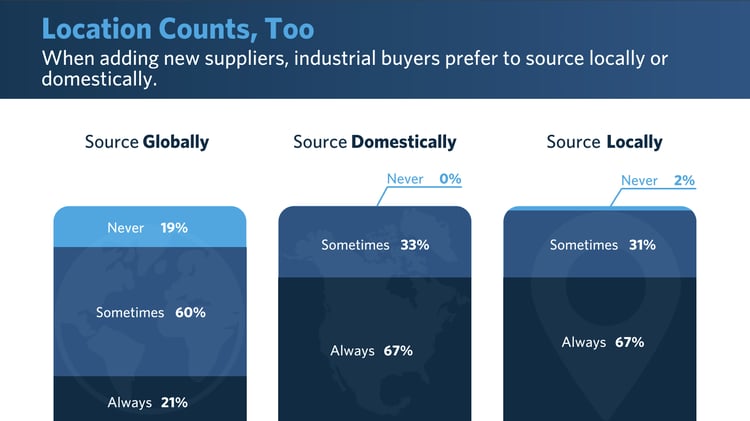
Make Buyers Contact You
Buyers are looking for a unique quality beyond just “what you do.”
You’re a textile manufacturer, but what else are you? Everyone has a different specialty, and yours is your selling point for some buyers out there. Think about what yours is, and make sure prospects know it when they find you.
Take Tex Tech Industries , for example. They use their website to amplify their messaging that they are a global leader in the research, development, and manufacturing of high-performance materials. Growing textile companies see benefits from building content with topics related to woven vs. non-woven products and their materials' processes.
In the example below, Tex Tech supplements their text-based educational information with graphics that detail the quality of their work and how they solve industry-focused challenges.

"Diversified content on our site has really helped us stand out as a leader in the industry," said Eoin Lynch, Executive Director of Sales and Marketing at Tex Tech Industries . "Some aerospace technology can be complex, but our graphics, datasheets, and videos from Thomas Marketing Services break it down for buyers to understand what they need and how we help them."
Do you have comprehensive options for mechanical finishes, treatments, and coatings for customers to customize what they need? Your website content should be very clear about what kinds of projects you’ve done in the past, what your capabilities are, and what you’re willing to take on. Showcase your certifications too. Providing this information will also increase the quality of your leads, making you more productive by spending less time on low-quality queries.
Additional Resources To Help You Get Shortlisted:
- 26 Must-Haves: How To Make The Industrial Buyer's Shortlist
- Content Marketing: A Sample List Of Information To Include On Your Manufacturing Website

Study Business Ethics And Culture
For those companies looking to expand globally, there are many challenges you need to consider and details you need to manage.
While there is trade potential in international partners, there are some risks with exporting goods , and today's businesses are more cautious than ever to ensure their supply chains are not disrupted.
Ensure you (and your internal teams) are educated in the legalities for each market and understand each region's border control and distribution laws. Business ethics, culture, and logistics vary and can often get overlooked when growing your business.
Grow Your Textile Business With These Marketing Basics
Your first point of contact with a buyer can make or break a deal. These days, that means your website and online presence are likely the first things they see. Partnering with industrial experts will ensure your platforms are strong and that each of your initiatives contributes to a real growth strategy.
Not sure where to start? We've compiled the below list of Thomas online solutions and resources that have been helping manufacturers grow and proven to engage B2B buyers, procurement managers, and MROs:
- Download this free Business Plan Template designed to create a snapshot of your manufacturing company, help you focus on the business’ details, outline the risks, and make sure you're on the trajectory toward growth.
- Give a tour of your factory floor with our free video content production services (with the purchase of an advertising program) and connect with more customers creatively online.
- Increase your RFQs with a free Thomasnet.com profile and connect with new customers on the platform where more than a million buyers from textile industries and various geographies sources are sourcing for products and services.
- See the exact companies that are searching for your textiles manufacturing services with a free In-Market Buyer Report .
- To increase your brand awareness to readers specifically by job function who are already interested in industry news, check out our newsletter advertising options .
- It's not rare to see a job shop fail — check out real advice from real job shop owners on the biggest mistakes to avoid.
- Landing a contract from a big company can be life-changing. Read Using Digital Marketing To Win Business From Fortune 1000s to learn more.
- Learn how small manufacturer USTEK used online advertising to grow their business in their case study here .
- See 10 examples from these manufacturers on how they're using online marketing to grow their business.

Did you find this useful?

Business & Industry
Georgia Dome Imploded in Atlanta
Related posts.
![textile factory business plan How To Meet The Needs Of B2B & Industrial Buyers [Updated 2022]](https://blog.thomasnet.com/hubfs/Brainstorm%20meeting%20understanding%20B2B%20buyers.png)
How To Meet The Needs Of B2B & Industrial Buyers [Updated 2022]

Thomasnet.com® Industrial Buying Engine™: Industrial Sourcing Made Easy
Actionable next steps for manufacturers....

Free Missed Opportunity Report
See which buyers are searching Thomasnet.com for the products & services you specialize in.
Get Buyer Report

The Ultimate Guide To Marketing
Learn about all the Digital Marketing Tactics that are Driving Growth for Manufacturers in 2021
Get Found By Buyers & Engineers
Connect with the most active and qualified network of B2B buyers on the world's leading platform for product discovery and supplier selection.
Exit-intent
Maecenas ante purus, laoreet sed venenatis et, dignissim vel erat. Donec nec diam sed turpis tempus luctus sit amet eu ipsum. Nullam libero dolor, rhoncus in mi ut, ullamcorper consequat nulla. Nullam blandit nisi vitae rutrum dapibus. Curabitur nec diam eu mauris fringilla cursus. Nam felis ipsum, sodales sit amet mollis id, adipiscing vitae velit. Maecenas sollicitudin erat eget nisl consectetur varius.
Some of our other free resources:
Product Overview Guide

Download Guide
Basics of Continuous Level Measurement
Download eBook
Get instant access to detailed competitive research, SWOT analysis, buyer personas, growth opportunities and more for any product or business at the push of a button, so that you can focus more on strategy and execution.
Table of contents, textile manufacturing business plan essentials.
- 3 June, 2024

Starting a Textile Manufacturing Business
Before diving into the process of starting a textile manufacturing business, it’s crucial to have a comprehensive understanding of the industry and the importance of market research.
Industry Overview
The textile manufacturing industry plays a vital role in the global economy, encompassing the production of a wide range of textiles and fabrics used in various sectors, including fashion, home furnishings, automotive, and more. This industry involves the transformation of raw materials into finished textile products through processes like spinning, weaving, knitting, dyeing, and finishing.
The textile manufacturing industry is highly competitive and constantly evolving. To thrive in this industry, entrepreneurs need to stay informed about the latest trends, technologies, and consumer demands. Understanding the textile manufacturing industry overview is essential for making informed decisions and developing effective business strategies.
Market Research Importance
Market research is a crucial step in starting a successful textile manufacturing business. It provides valuable insights into the market landscape, consumer preferences, trends, and potential opportunities. Conducting thorough market research enables entrepreneurs to make informed decisions, identify target customers, and develop effective marketing strategies.
Market research can be conducted through primary and secondary research methods. Primary research involves gathering information directly from potential customers and obtaining specific data to identify trends and opportunities. This can be done through surveys, interviews, focus groups, and observations.
On the other hand, secondary research involves gathering data that has been collected by others. This can include industry reports, government publications, trade journals, and online databases. Secondary research provides broader and high-quality data that can save time and provide a broader understanding of the market.
Combining data from both primary and secondary research helps decision-makers analyze and understand the market scenario, identify consumer preferences, and update marketing strategies to meet market demands effectively.
To effectively start a textile manufacturing business, entrepreneurs must have a clear understanding of the industry, its dynamics, and the market they intend to target. By conducting thorough market research, entrepreneurs can gather valuable insights that will guide them in formulating a solid business plan, identifying target customers, and positioning their business for success.
In the next section, we will explore the essential steps to begin a textile manufacturing business, including formulating a business plan, acquiring equipment and machinery, and setting up manufacturing facilities.
Essential Steps to Begin
Starting a textile manufacturing business requires careful planning and execution. Here are the essential steps to consider when embarking on this venture.
Formulating a Business Plan
Before diving into the world of textile manufacturing, it is crucial to formulate a comprehensive business plan. This plan serves as a roadmap for your business, outlining your goals, strategies, and financial projections. It helps you identify potential challenges and opportunities in the textile manufacturing industry.
Your business plan should include:
- Executive Summary: A concise overview of your business, its mission, and key objectives.
- Company Description: Detailed information about your company, including its legal structure, location, and target market.
- Market Analysis: Research and analysis of the textile manufacturing industry, including market trends, competition, and customer demands.
- Product Line: Description of the textile products you plan to manufacture, including their unique selling points and target customers.
- Marketing and Sales Strategy: Strategies for promoting and selling your products, including pricing, distribution channels, and marketing campaigns.
- Operations and Management: Detailed information on manufacturing processes, supply chain management, and key personnel.
- Financial Projections: Financial forecasts, including startup costs, revenue projections, and profit margins.
By formulating a well-structured business plan, you can effectively communicate your vision to potential investors, lenders, and partners. It serves as a crucial document for securing funding and guiding your business decisions.
Acquiring Equipment and Machinery
Acquiring the necessary equipment and machinery is a vital step in setting up your textile manufacturing business. The cost of purchasing manufacturing equipment can vary widely depending on the size and scope of your operation. According to Fin Models Lab , the cost can range from $100,000 to $5 million.
Some of the essential equipment and machinery for textile manufacturing include:
- Weaving and knitting machines
- Cutting and pressing equipment
Sewing machines
- Textile printing machines
It is important to choose reliable and high-quality equipment that aligns with your production needs. Consider factors such as production capacity, efficiency, and maintenance requirements when making equipment purchasing decisions.
Setting Up Manufacturing Facilities
Creating appropriate manufacturing facilities is a critical aspect of starting a textile manufacturing business. The cost of setting up facilities can vary depending on factors such as location, size, and construction materials. According to Fin Models Lab , the average cost of constructing a textile factory is around $20 million.
Key considerations for setting up manufacturing facilities include:
- Space Requirements: Assess the space needed for your manufacturing processes, including production lines, storage areas, and administrative offices.
- Infrastructure: Ensure your facilities have reliable power supply, water, and waste management systems.
- Safety Measures: Implement proper safety protocols to ensure a safe working environment for your employees, including fire safety measures and ergonomic considerations.
- Quality Control: Establish quality control processes and inspection procedures to maintain product standards.
Additionally, consider the layout and workflow of your manufacturing facilities to maximize operational efficiency and productivity.
By following these essential steps of formulating a business plan, acquiring the necessary equipment and machinery, and setting up manufacturing facilities, you can lay a strong foundation for your textile manufacturing business. Remember to conduct thorough research, seek expert advice, and adapt your plans as needed to navigate the complexities of this industry.
Financial Considerations
Starting a textile manufacturing business involves various financial considerations that need to be carefully planned and managed. This section explores three key aspects: initial investment costs, budgeting for operations, and hiring a skilled workforce.
Initial Investment Costs
Launching a textile manufacturing business requires a significant initial investment. The costs involved can vary depending on the size and scope of the operation. Some of the key expenses to consider include:
Equipment and Machinery : The cost of purchasing manufacturing equipment and machinery can range from $100,000 to $5 million, depending on the scale of the business. This includes machines such as weaving and knitting machines, cutting and pressing equipment, sewing machines, and textile printing machines ( Fin Models Lab ).
Facilities : The average cost of constructing a textile factory is around $20 million, while the cost of setting up a warehouse ranges from $10,000 to $100,000, depending on its size and location ( Fin Models Lab ). It’s important to consider expenses related to land acquisition, construction, utilities, and other infrastructure requirements.
Raw Materials : As a textile manufacturer, you’ll need to budget for the procurement of raw materials such as fibers, yarns, dyes, chemicals, and other supplies. The cost of raw materials will depend on the type of textiles you intend to produce and the sourcing strategy you adopt.
Licensing and Compliance : Obtaining the necessary licenses and permits is a crucial step in starting a textile manufacturing business. Factor in the costs associated with obtaining these licenses, complying with regulations, and meeting safety standards.
Budgeting for Operations
To ensure the smooth operation of your textile manufacturing business, it’s essential to develop a comprehensive budget that covers ongoing expenses. This includes:
Operating Costs : Account for expenses such as utilities, maintenance, repairs, insurance, and taxes. It’s important to analyze these costs carefully and make appropriate provisions to maintain profitability.
Raw Materials and Supplies : Estimate the ongoing costs of purchasing raw materials, chemicals, packaging materials, and other supplies necessary for production.
Labor Costs : Hiring a skilled workforce is an integral part of a successful textile manufacturing business. The cost of hiring skilled workers for design, production, and management can range between $40,000 to $150,000 per year per employee ( Fin Models Lab ). Consider the number of employees required and factor in their salaries, benefits, and training costs.
Marketing and Advertising : Allocate a budget for marketing and advertising activities to promote your textile products, build brand awareness, and attract customers. This may include expenses related to online and offline marketing campaigns, trade shows, and promotional materials.
Hiring a Skilled Workforce
A skilled and knowledgeable workforce is crucial for the success of your textile manufacturing business. Hiring the right talent with expertise in textile design, production, quality control, and management is essential. Consider the following aspects:
Job Roles : Identify the roles and responsibilities required for your business, such as textile designers, production supervisors, machine operators, quality control specialists, and administrative staff.
Recruitment : Develop a recruitment strategy to attract qualified candidates. This may involve advertising job openings, conducting interviews, and assessing candidates’ qualifications and skills.
Training and Development : Invest in training programs to enhance the skills of your workforce and keep them updated with the latest industry trends and technologies.
Compensation : Offer competitive salaries and benefits to attract and retain skilled employees. Take into account industry standards and local market conditions when determining compensation packages.
By carefully considering the financial aspects of starting and operating a textile manufacturing business, you can develop a solid foundation for your venture. Conduct thorough research, create a detailed business plan, and ensure you have the necessary resources to support your operations. Keep in mind that costs can vary based on location, scale, and other factors, so it’s essential to tailor your financial planning to your specific business needs.
Marketing Strategies
In the competitive landscape of the textile manufacturing business, effective marketing strategies are essential to attract customers and establish a strong brand presence. This section will explore key marketing strategies, including market analysis, target customer identification, and competitive landscape analysis.
Market Analysis
Before diving into the textile manufacturing business, conducting a thorough market analysis is crucial. Market research plays a significant role in developing a comprehensive business plan by providing valuable insights into the industry, customer preferences, and market trends. Data collected from market research reports contribute to information about competitors, growth plans, target market, and more ( Market Research ).
A market analysis involves evaluating the size, growth potential, and segmentation of the target market. It helps identify opportunities and potential challenges within the industry. By understanding market dynamics, such as customer demands, trends, and purchasing behaviors, textile manufacturers can tailor their products and marketing strategies to meet the needs of their target audience.
Target Customer Identification
Identifying the target customer is a critical step in developing effective marketing strategies for a textile manufacturing business. Understanding the demographics, preferences, and needs of the target audience allows manufacturers to create products that resonate with their customers. Market research aids in developing effective advertising campaigns based on consumer insights ( Market Research ).
For a textile manufacturing business, the target customers may vary depending on the niche or specialization of the business. It could include fashion designers, clothing brands, retail stores, or even individual consumers. By defining the target customer, manufacturers can tailor their marketing messages and distribution channels to effectively reach and engage their intended audience.
Competitive Landscape Analysis
Analyzing the competitive landscape is crucial for understanding the market positioning of a textile manufacturing business. This analysis helps identify direct and indirect competitors, their strengths and weaknesses, and their marketing strategies. By studying competitors, manufacturers can gain insights into industry trends, pricing strategies, and product differentiation.
A competitive landscape analysis involves evaluating factors such as market share, product offerings, pricing, distribution channels, and brand reputation. This information helps manufacturers identify gaps in the market that they can leverage to their advantage. By understanding the competitive landscape, textile manufacturers can develop unique selling propositions and marketing strategies that differentiate their products from others in the market.
By conducting a comprehensive market analysis, identifying target customers, and analyzing the competitive landscape, textile manufacturers can develop effective marketing strategies that drive growth and success in the industry. Market research plays a crucial role in providing the necessary insights and data to make informed decisions, ensuring that the marketing efforts are targeted and aligned with the needs of the customers and the dynamics of the market.
Manufacturing Strategies
To build a successful textile manufacturing business, it’s crucial to develop effective manufacturing strategies. These strategies have evolved over time, adapting to changes in the industry and advancements in technology. In this section, we will explore the historical perspective, industry evolution, and the importance of embracing Industry 4.0.

Historical Perspective
The relationship between process and strategy in manufacturing has existed for hundreds of years. In the past, skilled artisans relied on their craftsmanship and trade secrets to ensure product demand and prevent copying. This approach allowed them to maintain a competitive edge in the market and establish their reputation ( Katana MRP ).
The textile industry played a significant role in the development of manufacturing strategies. During the Industrial Revolution in the 18th century, manufacturing underwent a radical transformation. The introduction of machinery and the concept of mass production revolutionized the textile industry and other sectors such as glassmaking, mining, and agriculture. This shift enabled increased production at a larger scale and reduced costs, leading to the rapid growth of manufacturing industries ( Katana MRP ).
Industry Evolution
Over time, the manufacturing industry continued to evolve. Technological advancements, changing consumer demands, and globalization have shaped the strategies employed by textile manufacturers. From manual labor to automated processes, the industry has seen significant changes in production techniques, supply chain management, and quality control.
In recent years, the focus has shifted towards sustainability and ethical manufacturing practices. Textile manufacturers are increasingly incorporating sustainable materials, reducing waste, and implementing eco-friendly processes to meet consumer expectations and contribute to a greener future.
Embracing Industry 4.0
One of the most significant developments in manufacturing strategies is the concept of Industry 4.0, also known as the Fourth Industrial Revolution. This revolution emphasizes interconnectivity, smart automation, and digital process management to enhance production flow, improve quality, and reduce costs.
In the textile manufacturing industry, embracing Industry 4.0 involves implementing advanced technologies such as the Internet of Things (IoT), artificial intelligence (AI), and data analytics. These technologies enable real-time monitoring of production processes, predictive maintenance, and efficient inventory management. With the aid of smart machines and digital systems, manufacturers can optimize production efficiency, minimize downtime, and respond quickly to market demands.
By embracing Industry 4.0, textile manufacturers can gain a competitive advantage in the market. The integration of digital technologies not only improves operational efficiency but also enables manufacturers to meet the increasing demands for customization and personalization.
Understanding the historical perspective, industry evolution, and the importance of embracing Industry 4.0 is essential for textile manufacturers. By incorporating these strategies into their business plans, manufacturers can navigate the dynamic landscape of the industry, stay ahead of the competition, and position themselves for long-term success.
Case Study: FabriCo
In order to gain insights into the textile manufacturing business, let’s take a closer look at a case study of a successful company in the industry: FabriCo.
Company Overview
FabriCo is a textile manufacturing company that specializes in producing high-quality fabrics for various applications. Established in 2005, FabriCo has quickly become a leading player in the industry, known for its innovative designs, superior craftsmanship, and commitment to sustainability. The company operates a state-of-the-art manufacturing facility equipped with advanced machinery and employs a team of skilled professionals who bring their expertise and creativity to every project.
Target Market and Competitors
FabriCo primarily caters to the high-end fashion industry, supplying fabrics to renowned fashion designers and luxury brands. By focusing on quality, craftsmanship, and innovative designs, FabriCo has successfully positioned itself as a preferred choice for designers seeking unique and premium fabrics.
In addition to the high-end fashion market, FabriCo also serves other sectors such as home decor, upholstery, and technical textiles. The company’s diverse product range allows them to cater to a wide range of customers, expanding their market reach and revenue streams.
In the highly competitive textile manufacturing industry, FabriCo faces competition from both domestic and international players. However, their commitment to quality, attention to detail, and ability to deliver customized solutions set them apart from their competitors. By continuously innovating and staying up-to-date with the latest trends and technologies, FabriCo maintains a competitive edge in the market.
Marketing Strategy Insights
FabriCo’s marketing strategy revolves around building strong relationships with designers, fashion houses, and other industry stakeholders. Their focus on delivering exceptional customer service and developing long-term partnerships has earned them a solid reputation in the industry.
To effectively reach their target market, FabriCo utilizes a multi-channel marketing approach. This includes participating in trade shows and industry events, leveraging digital marketing channels, and collaborating with influencers and fashion publications. By showcasing their unique fabrics and highlighting their commitment to sustainability, FabriCo effectively communicates their brand values and attracts the attention of potential customers.
FabriCo also invests in market research to understand the evolving needs and preferences of their target customers. By staying abreast of the latest fashion trends and consumer demands, they are able to offer innovative designs and materials that resonate with their target market. This proactive approach to market research helps FabriCo stay ahead of the competition and maintain a strong market position.
By analyzing the case study of FabriCo, textile manufacturing businesses can gain valuable insights into successful strategies and best practices in the industry. By focusing on quality, innovation, and building strong relationships with customers, textile manufacturers can enhance their competitive advantage and achieve sustainable growth.
Perform Deep Market Research In Seconds
Automate your competitor analysis and get market insights in moments
Create Your Account To Continue!
Automate your competitor analysis and get deep market insights in moments, stay ahead of your competition. discover new ways to unlock 10x growth., just copy and paste any url to instantly access detailed industry insights, swot analysis, buyer personas, sales prospect profiles, growth opportunities, and more for any product or business..

9 Steps to Starting Your Own Textile Business
By: Nitish Sharma
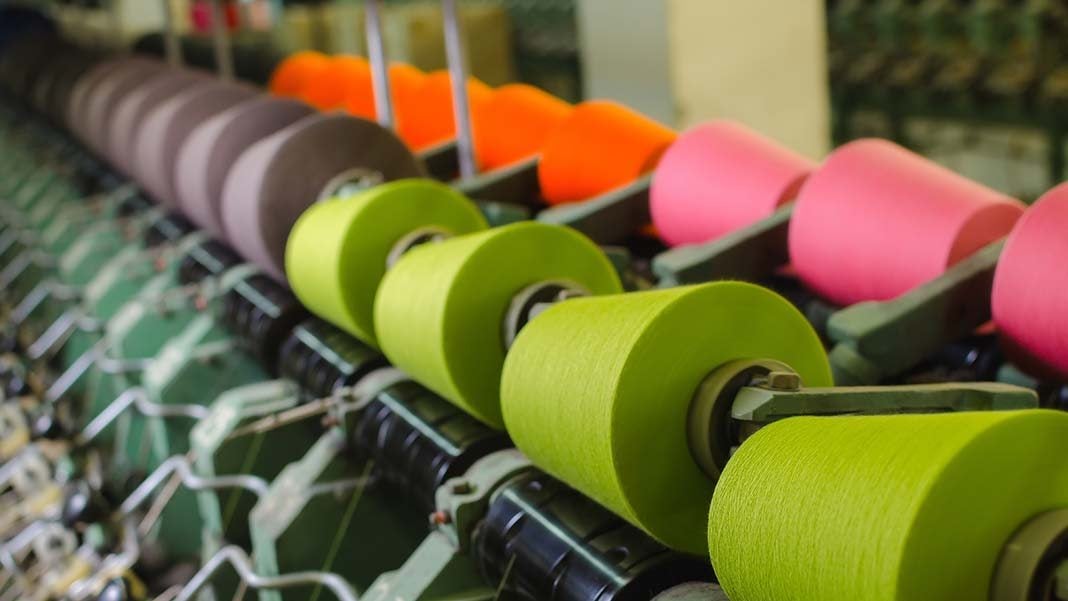
The textile industry can be regarded as one of the most active in recent times. Hopefully it will continue to gain strong ground in times to come, as well. If the idea of opening a textile business has fascinated you, it is time to take some action. Remember, starting you own textile business means lots of planning, research, and networking.
Being in the textile industry means having close connections with the world of fashion and designing since textile businesses supply fabrics to these subsidiary industries. There are two types of textile businesses, one that includes chains of stores selling all sorts of fabrics and the other that includes small stores that sell only a few, particular types of fabrics.
Therefore, if you are planning to make a fortune in the textile business, you must first decide what kind of textile you want to sell. Before you get the idea rolling, make sure you are sure about where you are headed.
Read More on Other Ways to Make or Save Money
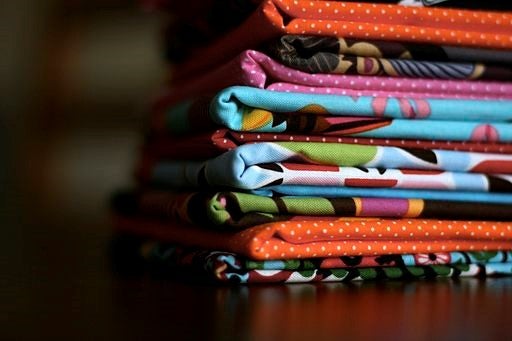
Photo Credit: Wikimedia
1. Know the market
It is always a good idea to take advice from those who are already in the business about the market and the challenges it entails. However, before you take the plunge you must have an idea about the following:
a) Product Demand
It is important to understand the nature of demand for the particular type of fabric you’re planning to sell. Demand may not be same everywhere so you should carry out an area-wise survey to determine it.
b) Competition
If there is another store in the same locality selling similar products that you intend to sell, then try to discover what you can do to outplay them.
c) Pricing
Pricing is an important factor in any kind of business. Try to price your products as competitively as possible.
2. Research
If you want your textile business to be a successful venture, you cannot underplay the importance of good research. You need to understand your customers, what they seek and also what your competitors are doing. There are other considerations to make as well, like the kind of capital you would need to start the textile business, your funding options, steps you need to take to promote your business, the type of licensing your business needs and much more.
3. Connect with vendors for textile printing and production
If you are planning to start a business in textile printing or production you should begin to look for the vendors supplying the raw materials needed for that purpose. Latex products are used by many in the textile markets for digital textile printing.
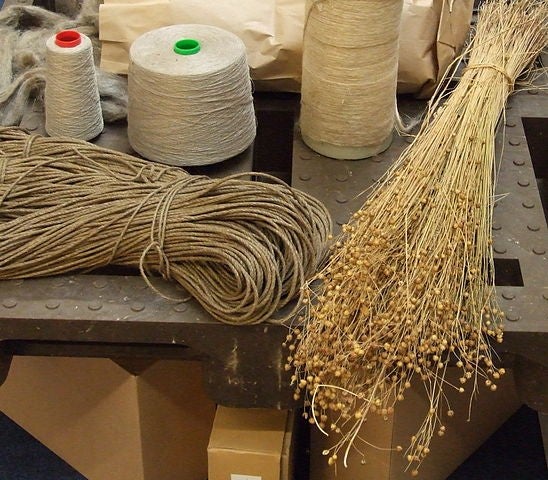
4. Find the fabric
You should start contacting manufacturers and vendors to decide the type of fabric you’d like to carry. You need to maintain caution when purchasing high-quality fabrics or a wide variety of them. If you want you can also check up on some unique fabrics outlets or local artisans specializing in hand dying fabrics or weaving textiles. Such types of fabrics will add value to your regular offerings.
5. Manage the cash flow
Even if you have already arranged for the capital to start your small business , owning a small business credit card would allow you to take care of the recurring charges and make secure online purchases. You might even be entitled to a number of extra benefits like cash back offers on certain purchases. Using the right textile accounting software based on your requirements can help your business to manage the cash flow effortlessly.
6. Location
Whether it’s a shop for selling textile products or a factory that produces textiles, location is a major factor that influences the success and growth of your business. If it is a factory, make sure it is well connected. At the same time it should also have an abundant supply of water and electricity. For shops, it should be located in an area frequented mostly by your target buyers.
7. Time Management
Mastering the art of managing time is crucial to the success of any business. If you are constantly running short of time and in the process missing out on important tasks, it is time you learned effective time management .
8. Transportation
An important consideration in your textile business will be transportation. You must include the cost of transportation in your budget before starting any business venture.
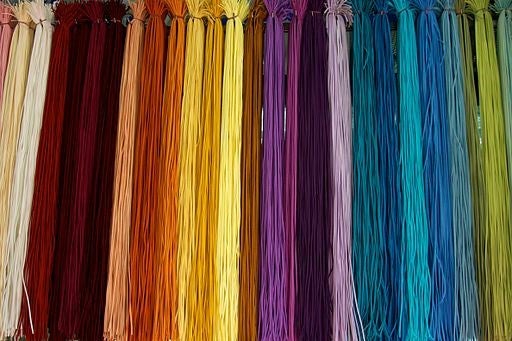
9. Advertise for your business
You need to let people know about the new business you’re going to start or have already started. Spread the word to as many prospective buyers as possible. You can expect a good start to your business if more people are already aware of it beforehand. Social media marketing and online marketing are some of the most powerful tools these days. You can effectively reach out to a large number of target buyers by using these tools. Signing up for Twitter or creating a new page on Facebook can get you started along these lines.
To start a textile business you need to first make sure that you have gathered enough knowledge not only about establishing the business but also about the product you intend to sell. In-depth knowledge of fabric, in this case, such as how it is made or how to produce better quality than your rivals will help you climb the ladder of success.
Trending Articles
How much should you pay your accountant, freedom & capitalism: memorial day and the spirit of small business ownership, 5 myths about being a financial advisor – debunked, trademark 101: how to protect your brand, sparkle your way to success: entrepreneurship and wellness with jacynta harb.

Nitish Sharma
Related articles.

How to Run a Successful Used Car Dealership
Marina Lewis
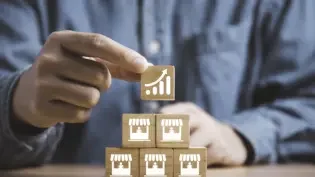
How to Create a Franchise Business Plan
Bill Bradley

Make a Plan That’s Flexible and Can Adapt to Changes
Fran Tarkenton

Building a Business Portfolio
Linus Britt
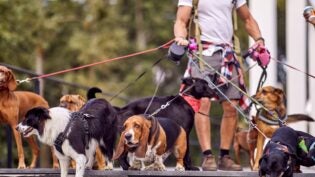
Exploring Side Hustles: Business Ideas For Part-Timers

How Do I Write a Business Plan for A Pet Food Business?
Roman Bogdan

Your Business Plan Needs These 5 Things to Be Effective
Charlotte Sylvester

Are You Ready to Launch Your Small Business?
Justin Weinger

How To Create a Successful Business Model For Your Startup

Projecting Success: How to Approach Your Financial Plan
Cory Williams
- Sample Business Plans
- Manufacturing & Wholesale
Clothing Manufacturer Business Plan

With influencer culture and pop culture on a rise, the fashion industry is growing faster than ever.
From impeccable outfits for social media to wearing outfits inspired by their favorite celebrities, clothes are in demand more than ever before.
And if you have a passion for all things fashion, the clothing manufacturer business can work wonders for you.
Moreover, the fashion industry is growing both in size and scale. So now is the time as good as any to get into it if you want to.
According to various statistics, the US apparel industry stands at a whopping value of 70 billion dollars and is growing at a rapid pace.
Although it was impacted massively by the pandemic, it is experiencing a rapid resurgence now that isn’t slowing down any time soon.
As life returns back to normal, people need new clothes, and want to stay at the top of trends too.
And this isn’t less than brilliant news for the fashion industry. And if you want to be a part of it, you must get started at the earliest. But before that, we have some tips and methods to help you get started and grow in style.
Say goodbye to boring templates
Build your business plan faster and easier with AI
Plans starting from $7/month

Things to Consider Before Writing Your Clothing Manufacturing Business Plan
Find your niche.
Nobody lied when they said that the riches are in the niches.
Though you might be tempted to go all out and manufacture every kind of clothing material that exists, it is always smart to select a niche and become an expert in it.
In a world of constant scrutiny, people pay for perfection. And selecting a niche can help you achieve just that.
Budget and plan your resources
Having a steady flow of resources is central to success in the fashion industry, and that too in a cost-effective way can act as a cherry on the cake.
Hence, planning where you’ll acquire various raw materials for manufacturing clothes and drawing out a budget for the same, can make doing business smooth and easy.
Know your customers and their preferences
All of us know that the trends in the fashion industry change faster than any other business. Hence, to have a thriving business, it is important to stay updated with the changing trends.
Keep an eye out for what your competitors are doing
Everything good attracts a lot of competition, and so does the fashion industry. Thus, it becomes necessary to know what your competitors are doing to stay ahead of them.
Also, more often than not, it gives you an insight as well as foresight into the working of your business.
Write Your Business Plan
If you are planning to start a new clothing manufacturing business, the first thing you will need is a business plan. Use our sample clothing manufacturing business plan to start writing your business plan in no time.
Before you start writing your business plan for your new clothing manufacturing business, spend as much time as you can reading through some examples of clothing and fashion-related business plans.
Reading sample business plans will give you a good idea of what you’re aiming for. It will also show you the different sections that different entrepreneurs include and the language they use to write about themselves and their business plans.
We have created this sample Clothing Manufacturing Business Plan for you to get a good idea about what a perfect clothing manufacturing business plan should look like and what details you will need to include in your stunning business plan.
Clothing Manufacturing Business Plan Outline
This is the standard clothing manufacturing business plan outline which will cover all important sections that you should include in your business plan.
- Mission Statement
- Vision Statement
- Keys To Success
- 3 Year profit forecast
- Financial needs
Past Performance
- Business Structure
- Startup cost
- Products and Services
- Market Trends
Target Market
- SWOT Analysis
- Advertising Strategy
- Pricing Strategy
- Milestones & Metrics
- Important Assumptions
- Brake-even Analysis
- Profit Yearly
- Gross Margin Yearly
- Projected Cash Flow
- Business Ratios
After getting started with upmetrics , you can copy this sample business plan into your business plan and modify the required information and download your clothing manufacturer business plan pdf or doc file.
It’s the fastest and easiest way to start writing your business plan .
The Quickest Way to turn a Business Idea into a Business Plan
Fill-in-the-blanks and automatic financials make it easy.
Download a sample clothing manufacturer business plan
Need help writing your business plan from scratch? Here you go; download our free clothing manufacturer business plan pdf to start.
It’s a modern business plan template specifically designed for your clothing manufacturer business. Use the example business plan as a guide for writing your own.
Related Posts
Embroidery Business Plan Template
Wholesale Business Plan
Business Plan Examples Free
Table of Content for Business Plan
About the Author
Upmetrics Team
Upmetrics is the #1 business planning software that helps entrepreneurs and business owners create investment-ready business plans using AI. We regularly share business planning insights on our blog. Check out the Upmetrics blog for such interesting reads. Read more
Plan your business in the shortest time possible
No Risk – Cancel at Any Time – 15 Day Money Back Guarantee

Create a great Business Plan with great price.
- 400+ Business plan templates & examples
- AI Assistance & step by step guidance
- 4.8 Star rating on Trustpilot
Streamline your business planning process with Upmetrics .

Textile manufacturing Strategy Template

What is a Textile manufacturing Strategy?
A Textile Manufacturing Strategy is a comprehensive plan that outlines how a textile manufacturing company will achieve its business goals related to production, quality, efficiency, and profitability. The strategy encompasses a range of activities, including product design, sourcing, manufacturing, marketing, and sales, and is designed to help the company compete effectively in the global textile industry.
What's included in this Textile manufacturing Strategy template?
- 3 focus areas
- 6 objectives
Each focus area has its own objectives, projects, and KPIs to ensure that the strategy is comprehensive and effective.
Who is the Textile manufacturing Strategy template for?
This textile manufacturing strategy template is designed for teams and organizations in the textile manufacturing industry of all sizes. It provides a framework to help teams create a plan that aligns their goals with their resources and capabilities. This template guides users through the process of creating and implementing a strategy, including how to define focus areas, set objectives and KPIs, and develop projects and processes to reach their goals.
1. Define clear examples of your focus areas
A focus area is a broad area of improvement that your organization wants to focus on. Each focus area will require its own set of objectives, KPIs, and projects. Examples of strategic focus areas that could fall under a Textile manufacturing Strategy could be: Improve operational efficiency , Increase customer satisfaction, and Enhance product quality.
2. Think about the objectives that could fall under that focus area
Objectives are the desired outcomes that your organization wants to achieve within a focus area. Objectives should be specific and measurable. Examples of some objectives for the focus area of Improve operational efficiency could be: Reduce shipping wait time, and Reduce inventory costs.
3. Set measurable targets (KPIs) to tackle the objective
KPIs, or key performance indicators, are measurable targets that are used to track progress toward an objective. Examples of KPIs in a textile manufacturing strategy might include decreasing inventory costs by a certain percentage or decreasing customer service response time. KPIs should be clearly defined, with an initial and target value, and a unit of measurement. An example of a KPI for the focus area of Improve operational efficiency could be: Decrease avg shipping wait time from 2.2 days to 1.5 days.
4. Implement related projects to achieve the KPIs
Projects are the actions that need to be taken to reach the objectives and KPIs. Examples of projects in a textile manufacturing strategy might include increasing automation of order processing or implementing a customer loyalty rewards program. Projects should be tailored to the needs of the organization.
5. Utilize Cascade Strategy Execution Platform to see faster results from your strategy
The Cascade Strategy Execution Platform is a powerful tool for helping organizations achieve their strategic goals. It provides a comprehensive view of the organization's performance, including goals, objectives, KPIs, and projects. It also enables users to track progress and identify areas of improvement. With Cascade, teams can create strategies quickly and efficiently, and see faster results from their efforts.
- HR & Payroll

Complete Guide to Textile Manufacturing

In 2021, the global textile market size was valued at USD 993.6 billion. This is anticipated to grow further at a compound annual growth rate (CAGR) of 4.0% from 2022 to 2030. This highlights how important the textile manufacturing industry is for all countries globally.
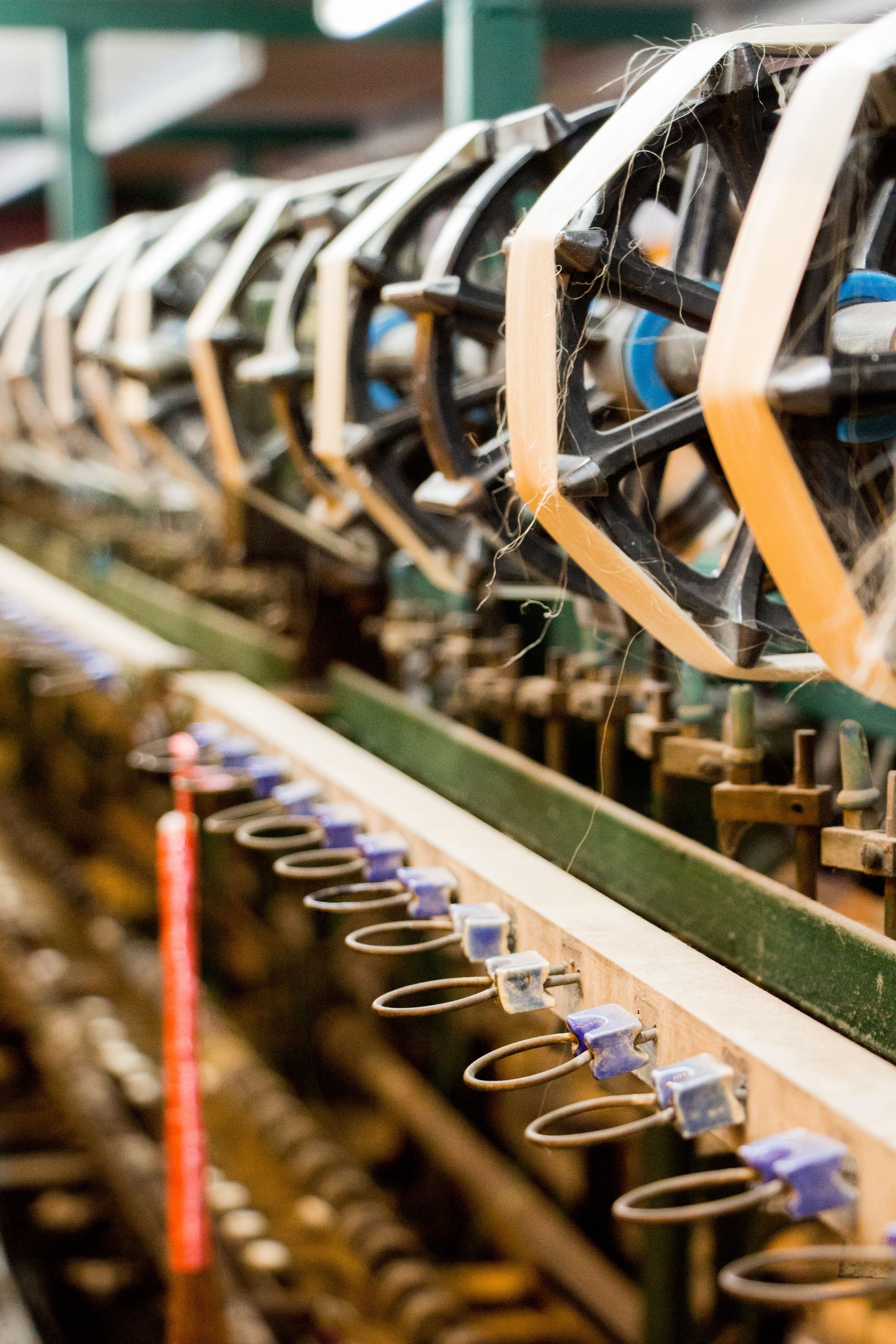
Textile manufacturing is a major industry. It is largely based on the conversion of fiber into yarn, then yarn into fabric. The fabric is then dyed or printed and fabricated into cloth which is then converted into useful goods like household items, clothing, upholstery, and various industrial products.
The ever-expanding nature of this industry has brought with it the need to implement systems that will make textile manufacturing a more productive and profitable business. But, to better understand why you need such a system and how it can help you, let us first understand textile manufacturing.
This article will cover the following topics:
What is Textile Manufacturing?
Historical and modern textile manufacturing, what is the process of textile manufacturing, different types of textile production, tips for crushing textile manufacturing, smart manufacturing software for textile manufacturing, how can deskera help you with textile manufacturing, key takeaways, related articles.
Textile manufacturing is an old but massively important industry. It is a huge and diverse industry that is basically involved with the conversion of fiber into yarn and then yarn into fabric. These fabrics are then printed, dyed, or fabricated into clothes, household products, upholstery, and various industrial products.
Whether it is the clothes we wear, the art we appreciate, or the carpets we walk on, all of these stem from the same manufacturing processes. They can either provide comfort or are essential for survival. In fact, textiles are an important staple to culture all around the world and to existence in general.
In textile manufacturing, different types of fibers are used to produce yarn, but cotton is the most important natural fiber among them all. What needs to be noted here is that textiles are classified according to their component fibers into:
They can also be classified according to their component synthetic fibers like:
There are also some inorganic fibers, based on which your textiles can be classified. These are:
- Cloth of gold
- Glass fiber
- Asbestos cloth
Additionally, your textiles are classified further based on their:
- Structure or weave
- The manner in which weft and warp cross each other in the loom
The factors that will determine the value and quality of your textiles are:
- Quality of raw materials used.
- The character of the yarn spun from the fibers like clean, fine, smooth, and coarse. It also includes whether they are soft, hard, or medium twisted.
- Density of weave
- Finishing processes
One of the modified forms of plain cloth weaving is a tapestry, which is sometimes classed as embroidery. In fact, the weaving of rugs and carpets is a special branch of the textile industry.
Other specially prepared fabrics that are not woven are felt and bark (or tapa) cloth. These are beaten or matted together. However, in some cases, like in crochet and netting work and various laces, a single thread is looped or plaited.
Nowadays, most textiles are produced in factories with the use of highly specialized power looms. There are, however, certain exceptions to this, like many of the finest brocades, velvets, and table linens that are still made by hand.
Thus, textile production is a long and complex process that produces tons of different finished products. These textile production processes can be, but are not limited to:
While the term textile comes from the Latin word “textilis” and the french “exere,” which translates to “to weave,” it was used to refer to only woven fabrics. But today, as the methods and processes have evolved over time, textiles have come to include many different fabrics and materials.
The earliest textile manufacturing process was undertaken using a piece of thread (regardless of material), from which loops were created in a repeated movement to design basketry and nets. The oldest known evidence of people using this method of textile manufacturing is during the Neolithic period.
The Silk Road (207 BCE - 220 CE) was an ancient trade network. This network saw goods like ivory, iron, pottery, horses, and the most coveted of all silk pass through. In fact, silk is one of the most influential commodities ever produced. This is because it led to the first steps of globalization.
Jumping forward to the industrial revolution and the periods beyond it, large-scale textile manufacturing processes were being implemented. These used machines, equipment, and software that automated the process, including the designing and production of fabrics. With the help of automation, these processes were completed in an incredibly short amount of time, improving a company’s cash flow , and increasing its gross profit .
Today, the companies in this industry are struggling to stay profitable, increase their productivity, and create products that are not only different from others but also of better quality. It is because of these reasons that implementing an MRP system like Deskera MRP has become vital.
Such a system will help you find and manage your competitive edge while ensuring that your customers are satisfied, you are creating positive brand awareness , and your revenue and net profit ratios are increasing.
Understanding the whole process of textile manufacturing is the key to understanding as well as optimizing your business. This section of the article will take you through the textile manufacturing process. This process is as follows:
Source Fiber
The process of textile manufacturing begins with the cultivation of natural textile fibers. This means that the first step in the production of textiles is harvesting raw fiber and sourcing it.
Fibers are extracted from:
- Mineral sources
They are then processed into a continuous strand known as yarn.
There are many types of fibers like:
And so on. Additionally, today, man-made or synthetic fibers are also used in textile manufacturing. These include but are not limited to the following:
Spinning or Yarn Manufacturing
Yarn manufacturing is the textile process of turning raw materials into yarn. To create the final yarn of thread, raw materials are sorted, cleaned, and then mixed together. This is used in weaving, knitting, or crocheting. Yarn can also be called a thread when it is used for sewing purposes.
Yarn manufacturing is known as the mother of the textile manufacturing process. Mainly, yarn is done by spinning together fibers such as cotton fiber, wool, or synthetic fibers. While originally, the yarn used to be made from animal hair, today, the same is not the case.
In fact, the market has many different types of yarn today. This is because textile manufacturers have found ways to make them out of other things like hemp, basalt, or bamboo. Yarn can also be made from recycled materials like plastic and polyethylene. In the case of synthetic yarn production, it is turned into petroleum-based products like rayon and polyesters.
While yarn manufacturing is a complex textile manufacturing process that takes place in different factories based on the type of yarn being created, the main theme of textile processing will always stay similar.
The first step in yarn manufacturing is raw material preparation. For this, raw materials must be sorted, cleaned, and mixed together to create the final textile product.
For example, if the raw material is wool or cotton, then you will have to ensure that any debris that might contaminate a batch is removed. If, however, your raw material is bamboo, then you will need to strip away its outer layer before spinning it into sewing thread for knitting projects.
After the raw materials are prepared, they are spun into yarn through a process called spinning. Spinning is done using machines with steel bobbins that have been wound with fiber or spinning material, known as roving. This can come from natural sources such as wool or cotton.
The machine winds the roving around a bobbin and then pulls it between two rollers that turn at different speeds to create the yarn. Here, some machines can also “twist” in order to add strength and elasticity to the final product.
Fabric Manufacturing Process
Also known as weaving, the fabric manufacturing process is the next step in textile production. Here, yarn is taken from one machine and transferred to another machine in order to create a length of fabric.
This process is completed using machines that turn yarn into lengths, which are then fed onto a loom with different types of colors or threads on specific sections called harnesses.
The warp (lengths) must be fitted precisely between the two sides of the heddles before the loom is turned on and the weaving process begins. Once a length of textile fabric has been created, it is removed from the looms and then sewn together to create a finished product.
There are four types of fabrics that are produced in the garments industry. These are:
- Woven fabric
- Knit fabric
- Nonwoven fabric
- Braided fabric
Fabric Wet Processing
This is a process used to dye and finish textiles. The dyeing process involves the application of colorants to fabric in order for it to become colored. The wet preparatory processes are:
- Fabric inspection
Textile finishing may involve adding additional properties such as soil release, anti-pill, or flame retardant treatments with different textile auxiliaries. This is applied chemically before packaging and shipping. What needs to be noted here is that there are several types of textile finishing that can be done by hand or machine.
Textile printing includes the use of inkjet printing on fabrics like sweatshirts, aprons, children’s clothes, t-shirts, etc. It also includes screen printing on various types of clothing, including hats, shirts, etc. Some of the types of textile printing are:
- Digital textile printing uses computers/plotters to print onto fabric
- Flexography which prints onto plastic film
- Gravure printing which prints with engraved cylinders onto paper
- Dye sublimation printing, where heat-activated chemicals are transferred onto a carrier medium from an inkjet printer
Garment Manufacturing Process
Garment manufacturing is the heart of yarn manufacturing. The steps involved in the garment manufacturing process are:
- Garments design- This could be provided by the buyer, or you will need textile design in the designing section. When garments are received from the buyer, their design starts with a technical sheet. This step can either be done manually, or it can be automated.
- Pattern making- Based on the garments' design, technical sheet, and artwork, the pattern master makes the pattern for all garments. Today, however, this can be done with an automated machine. Patterns are drawn, keeping in mind the different components of apparel by standard body measurements. They are often known as basic blocks or block patterns.
- Sample making- After the perfect pattern has been made, a complete apparel sample is made to ensure that it meets the requirements of your buyers. Once this sample is approved by the buyer as per their required specifications, it is known as an approved sample.
This will help in ensuring that the pattern adheres to the instructions issued for complete apparel production. This will help in saving your expenses while also keeping your customers satisfied.
- Production pattern making- The approved sample is followed by the counter sample, which is made for bulk production. Here, an additional extra measurement with exact or actual measurement is taken. This is known as an allowance, which is crucial for bulk production. Allowance can either be added manually or using the computer and is often known as a working pattern.
- Grading- Grading is the stepwise decrease or increase of the block or master pattern to produce different patterns and sizes. In bulk garments, production grading is important to maintain the production's size ratio. It is graded according to the buyer’s instructions.
- Marker making- A marker is a thin paper containing every apparel part. Marker-making helps to produce the cutting process smoothly. This step can be done manually as well as by using automation.
- Fabric spreading- This is one of the crucial parts of the garment production process. This is also known as fabric lying. This process is undertaken after a process named fabric relaxing is undertaken.
The main objective of fabric relaxation is to relax and contract the fabrics. This makes the fabric ready for the garment production process.
The benefit of this process is that it not only helps in preventing fabric strain at several stages but also helps in reducing fabric shrinkage. Post this, the fabric is spread on a long table so that it can be cut properly.
Currently, fabric spreading is done using automation. However, it still requires skilled manpower to spread the fabric properly. Thus, it is during the fabric spreading process that any fabric fault from the production line is detected.
- Fabric cutting- The fabrics need to be cut according to the marker. To do so, the process starts with fabric lying, marking, and then cutting. This is one of the most essential steps, as once the fabric is cut, there is no going back.
Hence, this can negatively affect your sewing process if not undertaken properly. This process can be done manually with a straight and sharp knife or through a computerized cutting system.
- Cutting parts sorting and bundling- After the errorless cutting, all the parts are sorted out according to the bundle tag. The bundle tag represents the fabric component bundle to identify the component. It is required to maximize production and maintain it. However, this step is not required in cases of single-garment production.
- Sewing- Here, all the cutting components of fabric are sewn together to make the garment or part of the garment as required. This is done manually and depends on the skills of the workers.
- Garments inspection- Final garment inspection is an important part of quality control. Higher the quality of your garment, the better your factory is represented. This step is undertaken manually.
Often, garment factories set a commodity standard to measure production output. Quality control is the most complicated section where the quality of your garments will be defined based on the inspection.
- Spot removing, ironing, and finishing- This step happens after the production defects are identified in the quality control, and marked with a sticker. The garments are now taken to the spot cleaning area. Here, your apparels will be cleaned with the help of hot water, steam, or chemical stain remover. Then it goes for manual ironing and finishing.
- Final inspection- A final quality control check is done to ensure that your buyer’s requirements are met. Sometimes this is also done by the agents of your buyer. This step is always carried out manually.
- Garments packing- Once all the above-mentioned steps are completed, your garments will be packed. The packing is carried out by using the buyer’s instructed poly bag. This step can be done either manually or it can be automated.
- Cartooning and shipment- Once your garments are packed, they are cartooned to reduce the damage of the garments. This is done in accordance with the buyer’s instructions. Post cartooning, shipment starts.
Textile production is the process of interweaving fibers to form a more complex pattern or object. Currently, there are at least six forms of textile production. These include:
In these crafts, hundreds of separate materials are used. These are categorized into the following four main groups:
- Anima; textiles
- Plant textiles
- Mineral textiles
- Synthetic textiles
This is a textile manufacturing method that interlaces long strands of cloth in both horizontal and vertical patterns. For this textile production, a device called a loom is incorporated. With the loom, hundreds of different patterns are made possible.
The several examples of woven items range from bed sheets to bulletproof vests and thousands of creations in between.
Traditionally, knitting is a type of textile production that is completed by hand with a needle or a crochet hook. Today though, industries have incorporated large knitting machines.
Crocheting is another type of textile manufacturing that would fall under this category. In fact, there are several types of clothing that are produced from knitting, using a variety of materials.
This is a form of textile production in which two similar fabrics are taken and then twisted into knots by using a predefined pattern.
Normally, a braided material has a much greater overall strength if made correctly. This is why numerous types of ropes are created this way.
Knotting is a similar process that falls under the same category of textile manufacturing. In knotting, though, the shapes that are created are often not uniform.
This is a type of textile production that varies vastly from other processes discussed above. In this method, nothing is being interlaced together physically.
Instead, various components are forced together under large amounts of pressure. They are then twisted together so that they become entangled.
To prevent them from tearing or breaking during the process, these fibers are normally treated with some type of lubricant, like a detergent.
This is a term that is almost exclusively applicable to synthetic materials like polyester or nylon. It is that type of textile production where these synthetic components are connected by means of pressure, heat, or adhesive.
This method of textile production is similar to weaving. This is because, in this method, small, lightweight components are made into a tape and then woven together with similar pieces.
Textile manufacturing is an industry with high competition, risk of increasing operational costs and manufacturing overheads, easy duplication of products and their quality, and loss of customer loyalty and USPs of businesses.
Thus, to establish your business amongst the other textile manufacturing companies more, or to become more competitive, you should implement some strategies. Some of the tips and strategies that will help you in crushing textile manufacturing are:
Sell Original Artwork
The tricky part of textile manufacturing companies is deciding how to advertise and sell your work. Some of the ways for the same are:
- Get art gallery representation
- Attend open studios, trade and craft fairs, art exhibitions
- Look at art marketing sites
- Build your own website
- Online marketplaces such as Etsy
- Sell across social media channels
The channel you choose should align the most with your business objectives, products, and buyer personas. This perfect combination will help you in increasing sales and net revenue .
It is, however, recommended that you opt for a multi-channel selling strategy so that you are able to mitigate your challenges while maximizing your opportunities.
Checking out textile manufacturing forums might help you in choosing the best approach for you. You should even research the market in your area to see which approaches your competitors choose and what is trending right now.
These insights will help you choose the best approach for your business, leading to an increase in your net profit and improving customer retention .
Art Licensing
Art licensing is a contract between manufacturers or retailers and artists that allows sellers to use their artwork to sell their products. Essentially, this means that you are allowing another business to use your copyrighted products.
For example, VIDA is a manufacturer that teams up with artists to secure the rights to use their designs and sells them on the artists’ behalf.
This method is thus a great collaboration opportunity for someone who wants to get into textile manufacturing but lacks the resources or tools to do so.
A similar but slightly different approach to the same is one where you team up with a contract manufacturer to get your foot in the door of large-scale textile manufacturing.
Become an Industry Leader
One of the best ways to succeed in this industry is by becoming an industry leader. This means that you are the go-to person for anyone who is looking for tips and tricks when it comes to textile manufacturing. You can do this through blogs, podcasts, vlogs, newspaper publications, magazine publications, etc.
Through this, you would be engaging in YouTube marketing , social media marketing , content marketing , and digital marketing that will end up driving traffic to your store.
While this is a long-term strategy that will require a lot of work to be put in, in order to be successful, the benefits that you will gain from the same will be worth all the efforts.
Teach Workshops
This will become your boots-on-the-ground approach to monetizing your efforts in textile manufacturing. When you are organizing and running workshops, you will be able to establish yourself as an industry expert, at least locally.
If you are taking your workshops online or traveling far for them, you will be able to establish yourself as an industry expert in larger areas. This thus becomes one of the most effective ways of undertaking brand marketing that will result in a positive brand image and encourage returning customers .
The various formats of workshops that you can choose from are:
- In-person groups
- One-on-one coaching sessions
- Teaching online courses
Remember, if you decide to hold workshops at a location that requires you to travel, it is essential for you to have a system in place that will allow for easy raw material inventory management .
This is because your own material will be in transit, and if all of your material is not used, it will head back to your warehouse.
Thus, without an inventory management system in place, it will become very easy for materials to become lost or for you to order more/fewer materials than are needed.
Sell Patterns and Kits
Considering that textile manufacturing is a popular hobby, you could design blueprints of your designs and create a starter pack for other aspiring artists through kitting. You could sell kits as:
- Personalized products
- Subscription boxes
- Seasonal promotions
In fact, you can even choose to do a promotional giveaway, which will become a quick and easy way to generate buzz around your textile manufacturing brand, and in the long run, increase the ratio of operating income to operating expenses .
Commissions
Commissions are where you will be reaching out to corporations, individuals, and public and state organizations to make products through bespoke manufacturing (i.e., customized manufacturing).
Irrespective of the fact that customized products have longer manufacturing lead time, they will interest your customers more and result in increasing your revenue.
This is because, nowadays, customers tend to prefer products that tell a story and are ethically sourced. This thus is an amazing opportunity for you to succeed in the textile manufacturing industry.
Design Fabrics
Like art licensing, designing and selling designs via a 3rd party printer will allow you to sell your prints via these textile manufacturers. For example, Spoonflower will take your designs and sell them as wallpaper, fabrics, and home décor.
Implementing smart manufacturing software for textile manufacturing will support your business and automate several of its processes.
This software will be useful to all the businesses in the textile manufacturing industry, whether it is a small workshop scaling their embroidery business or an industrial factory that produces the fabric, and every scale textile manufacturing business in between.
This software will support your businesses by giving you a birds-eye view of your entire business and the tools to help achieve efficiency in them. These tools include but are not limited to:
- Workflow management
- Inventory management
- Order fulfillment management
Thus, adopting smart manufacturing software into your business will help in relieving pressure by scraping your inefficient excel spreadsheets and other software that you might have implemented to automate your processes. This will be replaced by an MRP system that comes with easy-to-read visual dashboards and predictive analytics functionality.
Other functionalities that such a system should come with are:
An Unparalleled Auto-Booking System
An auto-booking system will help you in removing all the hassle of manual inventory management. It will make it very easy for you to track your finished goods and raw materials inventory.
Now, if your customer purchases something or you create a manufacturing order, the software automatically takes available material and allocates it to those open orders.
This will therefore enable you to not only know your stock levels and order deadlines in real time but also help you with just-in-time inventory management methods if that is what you have opted for. Thus, you would have total order fulfillment control at the tip of your fingertips.
Such a system will also automatically calculate your manufacturing costs, giving you a chance to prepare for your expenses.
Production Management Tools
Regardless of whether you are following the make-to-order or make-to-stock business model, this software will allow you to track your production progress on the factory floor or at a team member level. This information and insights will help you with resource capacity planning and shop floor scheduling .
In fact, while these systems and their predictive analytics feature will prioritize orders based on their due dates and complexities, they will also have the option where they will let you reprioritize your workflow.
For example, you get an emergency VIP order with a close due date but easier complexities, but you need to complete it first. This feature will let you automatically redistribute your allocated raw materials to complete the new workflow.
Software Integrations
Only if the system you choose integrates with other software will you be able to export information from them to this software. Additionally, it will also make it possible to integrate with your favorite eCommerce platforms like Shopify or WooCommerce, as well as with your bank.
This functionality will help your company to create synergy from sales to manufacturing to financing. It also ensures that your entire business is centralized onto one dashboard and that once you have integrated your other accounts, you can synchronize and streamline all of your data. This means that any changes to inventory, customers, sales, and finances will update live across all accounts.
As a business owner, it is crucial that you stay on top of your manufacturing processes and resource management.
You must manage production cycles, resource allocations, and much more to achieve this.
Deskera MRP is the one tool that lets you do all of the above. With Deskera, you can:
- Track raw materials and finished goods inventory
- Manage production plans and routings
- Maintain bill of materials
- Optimize resource allocations
- Generate detailed reports
- Create custom dashboards
And a lot more.
It is also possible to export information and data on Deskera MRP from other systems. Additionally, Deskera MRP will give you analytics and insights to help you make decisions.
So go ahead and book a demo for Deskera MRP today!
Textile manufacturing is a series of processes that are involved in the conversion of fiber into yarn and then yarn into fabric. The fabrics are then printed or dyed, or fabricated into cloth which is converted into useful goods like household items, cloths, upholstery, armor, and various industrial products.
The textile manufacturing industry is facing challenges in terms of increasing competition and duplication, rising costs of raw materials, increasing demands, and constantly changing preferences of consumers. Being able to have a productive, profitable, and successful business has thus become a challenge.
Considering these challenges and how the current advancement in technology can solve them, as well as save resources by automating several processes involved in textile manufacturing, implementing smart textile manufacturing systems has become crucial.
This implementation will help in workflow management, inventory management, and order fulfillment management. Deskera MRP is one of the best systems for the same.
What is Material Requirements Planning (MRP)?

What is Manufacturing: The Ultimate Guide of 2024

How Plastics Manufacturing Can Innovate and Collaborate to Thrive
Hey! Try Deskera Now!
Everything to Run Your Business
Get Accounting, CRM & Payroll in one integrated package with Deskera All-in-One .

Textile Shop Business Plan [Sample Template]
By: Author Tony Martins Ajaero
Home » Business Plans » Fashion & Style
Are you about starting a textile shop? If YES, here is a complete sample textile shop business plan template & feasibility report you can use for FREE .
Okay, so we have considered all the requirements for starting a textile shop. We also took it further by analyzing and drafting a sample textile shop marketing plan template backed up by actionable guerrilla marketing ideas for textile shops. So let’s proceed to the business planning section .
It has been proven over and over again that businesses that are worth going for are businesses that people need their services or products from time to time.
Suggested for You
- Online Jewelry Store Business Plan [Sample Template]
- Garment Manufacturing Business Plan [Sample Template]
- Sunglasses Line Business Plan [Sample Template]
- Fashion Consultant Business Plan [Sample Template]
- Fashion Stylist Business Plan [Sample Template]
A business like textile shop falls into this category; you can be certain that there would be ceremonies at least once in a week in your city or town and people will always shop for textiles. So, if you are looking for a business to start as an aspiring entrepreneur who has interest in selling stuffs, then one of your options is to open a textile shop in your city.
One good thing about this type of business is that you don’t need to enroll in a conventional school to learn how to start and run the business; it is a business that requires basic business skills such as customer service, accounting, bargaining, networking and of course overall business management skills.
If you have decided to start a textile shop business, then you should ensure that you carry out feasibility studies and also market survey. Business plan is yet another very important business document that you should not take for granted when launching the business.
Below is a sample textile shop business plan template that can help you to successfully write your own with little or no difficulty.
A Sample Textile Shop Business Plan Template
1. industry overview.
Textile shops fall under the Fabric, Craft and Sewing Supplies Stores industry and players in this industry basically retail sewing and craft supplies, fabrics, patterns, yarns, needlework accessories, seasonal decorations and related stuffs.
A study conducted by IBISWORLD reported that fabrics are expected to account for the majority of the industry revenue in 2017, representing roughly 60.3 percent of total sales. This segment includes fabrics, such as cotton, satin, silk and corduroy, that are used for apparel construction, home decor and quilting projects.
This segment has experienced a moderate rise in its share of revenue over the past five years. Driven by the do-it-yourself (DIY) fashion, a growing number of Americans have started creating their own clothes and household decor items.
As a result, demand for fabric materials has increased. Sewing and craft supplies account for 37.0 percent of the revenue generated in the industry. The Fabric, Craft and Sewing Supplies industry is a thriving and profitable business venture in most countries of the world.
Statistics have it that in the united states alone, the Fabric, Craft and Sewing Supplies Stores industry generates over $4 billion annually from more than 23,437 fabrics, craft and sewing supplies outlets scattered all around the United States of America.
The industry is responsible for the direct employment of well over 46,156 people. Experts project the fabrics, crafts and sewing supplies shop industry to grow at a -1.3 percent annual rate between 2012 and 2017. Hobby Lobby Stores Inc., Jo-Ann Stores and Michaels Stores have a lion market share of the industry.
The Fabric, Craft and Sewing Supplies Stores industry has minimal barriers to entry, with low startup capital and no specific licensing requirements.
The majority of textile shops operate as a one-outlet business and the capital costs of establishing textile retail outlets are not substantial relative to many other retail industries such as department stores with chains of outlets all over the country.
On the other hand, the high level of competition and market saturation in a declining industry can prove challenging to aspiring entrepreneurs who want to start their own textile business. Most players in the Fabric, Craft and Sewing Supplies industry are small to medium size establishments that cater to the local community.
The Fabric, Craft and Sewing Supplies business is a profitable industry and it is open for any aspiring entrepreneur to come in and establish his or her business; you can choose to start on a small scale in a street corner like the average mom and pop business or you can choose to start on a large scale with several outlets in key cities all across the United States of America.
2. Executive Summary
Quincey Couture™ Textile Shop, LLC is a standard textile shop business that will be located in one of the busiest market districts in Baton Rouge – Louisiana.
We have been able to lease a shop that is large enough to fit into the design of the kind of textile shop we intend launching and the shop is located in a corner piece property directly opposite the largest shopping mall in Baton Rouge – Louisiana.
Quincey Couture™ Textile Shop, LLC will be involved in retailing a wide variety of textiles, sewing supplies and accessories such as fabric, patterns, upholstery materials, yarns, needlecraft supplies, sewing machines and seasonal decorations et al.
We are aware that there are several large and small textile shops all around Baton Rouge – Louisiana, which is why we spent time and resources to conduct thorough feasibility studies and market survey so as to offer much more than our competitors will be offering.
We have delivery service options for our customers, and our outlet is well secured with the various payment options. Our customer care will be second to none in the whole of Baton Rouge – Louisiana. We know that our customers are the reason why we are in business which is why we will go the extra mile to get them satisfied when they visit our textile shop.
Quincey Couture™ Textile Shop, LLC will at all times demonstrate her commitment to sustainability, both individually and as a firm, by actively participating in our communities and integrating sustainable business practices wherever possible.
We will ensure that we hold ourselves accountable to the highest standards by meeting our client’s needs precisely and completely.
Our plan is to position Quincey Couture™ Textile Shop, LLC to become a leading brand in the textile shop line of business in the whole of Louisiana, and also to be amongst the top 10 textile shops in whole of the United States of America within the first 10 years of opening our first textile shop.
This might look too tall a dream but we are optimistic that this will surely come to pass because we have done our research and feasibility studies and we are confident that Baton Rouge – Louisiana is the right place to launch our textile shop business before spreading to other parts of the United States.
Quincey Couture™ Textile Shop, LLC is a family business that is owned by Quincey Maxwell and her immediate family members. She has robust experience, qualifications and skills that will help her grow the business from startup to profitability within the shortest time possible.
Although the business is launching out with just one outlet in Baton Rouge – Louisiana, but there are plans to open other outlets around key cities in the United States of America.
3. Our Products and Services
Quincey Couture™ Textile Shop, LLC is in the fabrics, crafts and sewing supplies industry to make profit and we will ensure we go all the way to make available a wide range of textiles, sewing accessories and other related merchandise to our clients. Our product offerings are listed below;
- Retailing textiles (fabric)
- Retailing patterns
- Retailing sewing supplies
- Retailing upholstery materials
- Retailing yarns
- Retailing sewing machines
- Retailing seasonal decorations
4. Our Mission and Vision Statement
- Our vision is to become the leading textile brand in the whole of Louisiana and also to be amongst the top 10 textile shop brands in the United States of America.
- Our mission is to establish a textile business that will make available a wide range of textiles and sewing accessories at affordable prices to the residents of Baton Rouge – Louisiana and other cities in the United States where we intend opening of chains of textile shops.
Our Business Structure
Quincey Couture™ Textile Shop, LLC is a textile shop that intends to start small in Baton Rouge – Louisiana, but looks to grow big in order to compete favorably with leading textile shops in the United States.
We are aware of the importance of building a solid business structure that can support the picture of the kind of world class textile shop business we want to own. This is why we are committed to only hiring the best hands within our area of operation.
At Quincey Couture™ Textile Shop, LLC, we will ensure that we hire people that are qualified, hardworking, creative, customer centric and are ready to work to help us build a prosperous business that will benefit all our stakeholders.
As a matter of fact, profit-sharing arrangement will be made available to all our senior management staff and it will be based on their performance for a period of five years or more. In view of the above, we have decided to hire qualified and competent hands to occupy the following positions in our organization;
- Chief Executive Officer (Owner)
- Shop Manager
Merchandize Manager
Sales and Marketing Manager
- Accountants/Cashiers
- Customer Services Executive
5. Job Roles and Responsibilities
Chief Executive Officer – CEO (Owner):
- Increases management’s effectiveness by recruiting, selecting, orienting, training, coaching, counseling, and disciplining managers; communicating values, strategies, and objectives; assigning accountabilities; planning, monitoring, and appraising job results; developing incentives; developing a climate for offering information and opinions; providing educational opportunities.
- Creating, communicating, and implementing the organization’s vision, mission, and overall direction – i.e. leading the development and implementation of the overall organization’s strategy.
- Responsible for fixing prices and signing business deals
- Responsible for providing direction for the business
- Creating, communicating, and implementing the organization’s vision, mission, and overall direction – i.e. leading the development and implementation of the overall organization’s strategy
- Responsible for signing checks and documents on behalf of the company
- Evaluates the success of the organization
Shop Manager:
- Responsible for managing the daily activities in the store
- Responsible for overseeing the smooth running of HR
- Maintains office supplies by checking stocks; placing and expediting orders; evaluating new products
- Ensures that proper records of goods are kept and our racks and warehouse does not run out of products
- Ensure that the store facility is in tip top shape and goods are properly arranged and easy to locate
- Control goods distribution and supply inventory
- Supervise the workforce
- Manage vendor relations, market visits, and the ongoing education and development of the organizations’ buying teams
- Help to ensure quality textiles and sewing accessories are available in our shop
- Responsible for the purchase of stocks for the organizations
- Responsible for planning sales, monitoring inventory, selecting the merchandise, and writing and pricing orders for vendors
- Ensures that the organization operates within stipulated budget
- Manage external research and coordinates all the internal sources of information to retain the organizations’ best customers and attract new ones
- Model demographic information and analyze the volume of transactional data generated by customer purchases
- Identify, prioritize, and reach out to new partners, and business opportunities et al
- Identifies development opportunities; follow up on development leads and contacts; participates in the structuring and financing of projects; assures the completion of development projects
- Responsible for supervising implementation, advocate for the customer’s needs, and communicate with clients
- Develop, execute and evaluate new plans for expanding sales
- Document all customer contact and information
- Help increase sales and growth for the company
Accountant/Cashier:
- Responsible for preparing financial reports, budgets, and financial statements for the organization
- Provides financial analyses, development budgets, and accounting reports; analyzes financial feasibility for the most complex proposed projects; conducts market research to forecast trends and business conditions.
- Responsible for financial forecasting and risk analysis
- Performs cash management, general ledger accounting, and financial reporting
- Responsible for developing and managing financial systems and policies
- Responsible for administering payrolls
- Ensuring compliance with taxation legislation
- Handles all financial transactions for the organization
- Serves as internal auditor for the organization
Client Service Executive
- Ensures that all contacts with clients (e-mail, walk-In center, SMS or phone) provides the client with a personalized customer service experience of the highest level
- Through interaction with customers on the phone, uses every opportunity to build client’s interest in the company’s products and services
- Consistently stays abreast of any new information on the organizations’ products, promotional campaigns etc. to ensure accurate and helpful information is supplied to customers when they make inquiries
- Find out the customer’s needs, recommend, select and help locate the right merchandise, describe a product’s features and benefits
- make suggestions and encourage purchase of products
- Bag or package purchases and gift wrap merchandise
- Responsible for cleaning the shop facility at all times
- Ensure that toiletries and supplies don’t run out of stock
- Handle any other duty as assigned by the shop manager
6. SWOT Analysis
Our intention of starting just one outlet of our textile shop in Baton Rouge – Louisiana is to test run the business for a period of 2 to 5 years to know if we will invest more money, expand the business and then open other outlets all across the United States of America.
We are quite aware that there are several textile shops all over Baton Rouge – Louisiana and even in the same location where we intend locating ours, which is why we are following the due process of establishing the business.
We know that if a proper SWOT analysis is conducted for our business, we will be able to position our business to maximize our strength, leverage on the opportunities that will be available to us, mitigate our risks and be equipped to confront our threats.
Quincey Couture™ Textile Shop, LLC employed the services of an expert HR and Business Analyst with bias in retailing to help us conduct a thorough SWOT analysis and to help us create a Business model that will help us achieve our business goals and objectives. This is the summary of the SWOT analysis that was conducted for Quincey Couture™ Textile Shop, LLC;
Our location, the business model we will be operating on (brick and mortar shop and online store), varieties of payment options, wide range of textiles and sewing related accessories and our excellent customer service culture will definitely count as a strong strength for Quincey Couture™ Textile Shop, LLC. So also, our management team has what it takes to grow a business from startup to profitability with a record time.
A major weakness that may count against us is the fact that we are a new textile retail store outlet in Baton Rouge – Louisiana and we don’t have the financial capacity to compete with multi – million dollars fabric, craft and sewing supply outlets like Hobby Lobby Stores Inc. Jo-Ann Stores and Michaels Stores when it comes to retailing at rock bottom prices.
- Opportunities:
The fact that we are going to be operating our textile shop in one of the busiest streets in Baton Rouge – Louisiana provides us with unlimited opportunities to sell our merchandise to a large number of people.
We have been able to conduct thorough feasibility studies and market survey and we know what our potential clients will be looking for when they visit our textile shop; we are well positioned to take on the opportunities that will come our way.
Just like any other business, one of the major threats we are likely going to face is economic downturn. It is a fact that economic downturn affects purchasing/spending power. Another threat that may likely confront us is the arrival of a new textile shop in same location where ours is located. We are not ruling out the fact that unfavorable government policy can also pose a threat to our business.
7. MARKET ANALYSIS
In this era where the online community is growing rapidly, you would do your business a favor if you create your own online presence. One of the easiest ways to get people to see you as an expert in your line of business is to Instagram and blog constantly about fabrics and fashion styles.
You may also want to leverage on social media platforms like Instagram, Facebook, and Twitter, and others to publicize your textile business.
One smart thing you may do for your business is to prepare a comprehensive catalogue that contains all form of textiles and sewing accessories. Your catalog should be your number one marketing tool so you must ensure that it is well designed and of high quality. You should be ready to always update your catalog when you have new fabrics..
Another key factor that could help you grow your business fast is to leverage on existing platforms. You can join a textile shop owners’ association in your area.
8. Our Target Market
When it comes to selling items that are found in textile stores, there is indeed a wide range of available customers. Our target market won’t be restricted to just a group of people, but all those who reside in the locations where we intend opening our textile shop.
One thing is certain, we will ensure that we only retail quality and affordable textiles and sewing accessories in our shop. In view of that, we have positioned our textile shop to service the residents of Baton Rouge – Louisiana and every other location where our textile shops will be located all over the United States of America.
We have conducted our market research and we have ideas of what our target market would be expecting from us. We are in business to retail our supplies to the following groups of people;
- Fashion Designers
- Every adult that resides within our textile shop location
Our Competitive Advantage
A close study of the fabrics, crafts, and sewing accessories shops industry reveals that the market has become much more intensely competitive over the last decade. As a matter of fact, you have to be highly creative, customer centric and proactive if you must survive in this industry.
We are aware of the stiff competition and we are well prepared to compete favorably with other textile shops in Baton Rouge – Louisiana.
Quincey Couture™ Textile Shop, LLC is located in a corner piece property on a busy road directly opposite one of the largest residential estates in Baton Rouge – Louisiana. We have enough parking spaces that can accommodate well over 20 cars per time.
Our location, the business model we will be operating on, varieties of payment options, wide range of textiles and related accessories and our excellent customer service culture will definitely count as a competitive advantage for Quincey Couture™ Textile Shop, LLC.
Lastly, our employees will be well taken care of, and their welfare package will be among the best within our category in the florist industry, meaning that they will be more than willing to build the business with us and help deliver our set goals and achieve all our aims and objectives. We will also give good working conditions and commissions to freelance sales agents that we will recruit from time to time.
9. SALES AND MARKETING STRATEGY
Sources of Income
Quincey Couture™ Textile Shop, LLC is in business to retail a wide range of textiles, sewing accessories and related products. We are in the fabric, craft and sewing accessories industry to maximize profits and we are going to go all the way out to ensure that we achieve or business goals and objectives.
Our source of income will be from;
- Retailing textiles
- Retailing sewing craft supplies
10. Sales Forecast
One thing is certain when it comes to the textile shop business, if your shop is well stocked and centrally positioned, you will always attract customers cum sales and that will translate to increase in revenue generation for the business.
We are well positioned to take on the available market in Baton Rouge – Louisiana and we are quite optimistic that we will meet our set target of generating enough profits from the first six months of operation and grow the business and our clientele base.
We have been able to critically examine the fabrics, crafts and sewing accessories industry, we have analyzed our chances in the industry and we have been able to come up with the following sales forecast.
- First Fiscal Year: $120,000
- Second Fiscal Year: $350,000
- Third Fiscal Year: $750,000
N.B : This projection was done based on what is obtainable in the industry and with the assumption that there won’t be any major economic meltdown, and there won’t be any major competitor offering same products and customer care services as we do within same location. Please note that the above projection might be lower and at the same time it might be higher.
- Marketing Strategy and Sales Strategy
Before choosing a location for Quincey Couture™ Textile Shop, LLC, we conducted a thorough market survey and feasibility studies in order for us to be able to penetrate the available market and become the preferred choice for residents of Baton Rouge – Louisiana.
We have detailed information and data that we were able to utilize to structure our business to attract the number of customers we want to attract per time.
We hired experts who have good understanding of the fabrics, crafts and sewing accessories industry to help us develop marketing strategies that will help us achieve our business goal of winning a larger percentage of the available market in Baton Rouge – Louisiana.
In other to continue to be in business and grow, we must continue to sell the stocks that are available in our shop which is why we will go all out to empower or sales and marketing team to deliver. In summary, Quincey Couture™ Textile Shop, LLC will adopt the following sales and marketing approach to win customers over;
- Open our textile shop in a grand style with a party for all
- Introduce our textile shop business by sending introductory letters alongside our brochure to tailors and fashion designers, households and key stakeholders in and around Baton Rouge – Louisiana
- Ensure that we have a wide range of textile (fabrics), sewing accessories and other related merchandise in our shop at all times.
- Make use of attractive hand bills to create awareness and also to give direction to our textile shop
- Position our signage/flexi banners at strategic places around Louisiana
- Position our greeters to welcome and direct potential customers
- Create a loyalty plan that will enable us reward our regular customers
- Engage on roadshows within our neighborhood to create awareness for our textile shop
11. Publicity and Advertising Strategy
Despite the fact that our textile shop is well located, we will still go ahead to intensify publicity for the business. We are going to explore all available means to promote Quincey Couture™ Textile Shop, LLC.
Quincey Couture™ Textile Shop, LLC has a long – term plan of opening outlets in various locations all around the United States of America which is why we will deliberately build our brand to be well accepted in Baton Rouge – Louisiana before venturing out.
As a matter of fact, our publicity and advertising strategy is not solely for winning customers over but to effectively communicate our brand. Here are the platforms we intend leveraging on to promote and advertise Quincey Couture™ Textile Shop, LLC;
- Place adverts on community based newspapers, fashion magazines, radio and TV stations
- Encourage the use of word of mouth publicity from our loyal customers
- Leverage on the internet and social media platforms like YouTube, Instagram, Facebook, Twitter, Snapchat and other platforms to promote our business.
- Ensure that our we position our banners and billboards in strategic positions all around Baton Rouge – Louisiana
- Distribute our fliers and handbills in target areas in and around our neighborhood
- Advertise Quincey Couture™ Textile Shop, LLC business in our official website and employ strategies that will help us pull traffic to the site
- Brand all our official cars and vans and ensure that all our staff members wear our branded shirt or cap at regular intervals
12. Our Pricing Strategy
Pricing is one of the key factors that gives leverage to retailers, it is normal for consumers to go to places where they can get quality fabrics, sewing accessories and related merchandise at affordable price which is why big players in the industry will continue to attract loads of consumers.
We know we don’t have the capacity to compete with bigger and well – established textile shops, but we will ensure that the prices of all the products in our textile shop are competitive.
- Payment Options
The payment policy adopted by Quincey Couture™ Textile Shop, LLC is all inclusive because we are quite aware that different customers prefer different payment options, but at the same time, we will ensure that we abide by the financial rules and regulation of the United States of America.
Here are the payment options that Quincey Couture™ Textile Shop, LLC will make available to her clients;
- Payment via bank transfer
- Payment with cash
- Payment via credit cards/Point of Sale Machines
- Payment via online bank transfer
- Payment via check
- Payment via mobile money transfer
- Payment via bank draft
In view of the above, we have chosen banking platforms that will enable our client make payment for stocks purchased without any stress on their part. Our bank account numbers will be made available on our website and promotional materials.
13. Startup Expenditure (Budget)
In setting up any business, the amount or cost will depend on the approach and scale you want to undertake. If you intend to go big by renting a place, then you would need a good amount of capital as you would need to ensure that your employees are well taken care of, and that your facility is conducive enough for workers to be creative and productive.
This means that the start-up can either be low or high depending on your goals, vision and aspirations for your business. The tools and equipment that will be used are nearly the same cost everywhere, and any difference in prices would be minimal and can be overlooked.
As for the detailed cost analysis for starting a textile shop business; it might differ in other countries due to the value of their money. These are the key areas where we will spend our startup capital;
- The total fee for registering the business in the United States of America – $750
- Legal expenses for obtaining licenses and permits as well as the accounting services (software, P.O.S machines and other software) – $3,300
- Marketing promotion expenses for the grand opening of Quincey Couture™ Textile Shop, LLC in the amount of $3,500 and as well as flyer printing (2,000 flyers at $0.04 per copy) for the total amount of $3,580.
- The total cost for hiring business consultant – $2,500
- The total cost for the purchase of insurance (general liability, workers’ compensation and property casualty) coverage at a total premium – $2,400
- The cost for payment of rent for 12 months at $1.76 per square feet in the total amount of $105,600
- The cost for shop remodeling – $20,000
- Other start-up expenses including stationery ($500) and phone and utility deposits ( $2,500 )
- Operational cost for the first 3 months (salaries of employees, payments of bills et al) – $60,000
- The cost for start-up inventory (stocking a wide range of fabrics, sewing accessories and other related merchandise) – $100,000
- The cost for store equipment (cash register, security, ventilation, signage) – $13,750
- The cost of purchase and installation of CCTVs – $5,000
- The cost for the purchase of furniture and gadgets (Computers, Printers, Telephone, TVs, Sound System, tables and chairs et al) – $4,000
- The cost of launching a website – $600
- The cost for our opening party – $5,000
- Miscellaneous – $5,000
We would need an estimate of $350,000 to successfully set up our textile shop in Baton Rouge – Louisiana.
Generating Startup Capital for Quincey Couture™ Textile Shop, LLC
Quincey Couture™ Textile Shop, LLC is a private business that is solely owned and financed by Quincey Maxwell. They do not intend to welcome any external business partner which is why he has decided to restrict the sourcing of the startup capital to 3 major sources.
These are the areas we intend generating our startup capital;
- Generate part of the startup capital from personal savings
- Source for soft loans from family members and friends
- Apply for loan from my Bank
N.B: We have been able to generate about $100,000 ( Personal savings $70,000 and soft loan from family members $30,000 ) and we are at the final stages of obtaining a loan facility of $250,000 from our bank. All the papers and documents have been signed and submitted, the loan has been approved and any moment from now our account will be credited with the amount.
14. Sustainability and Expansion Strategy
The future of a business lies in the number of loyal customers they have, the capacity and competence of the employees, their investment strategy and their business structure. If all of these factors are missing from a business, then it won’t be too long before the business closes shop.
One of our major goals of starting Quincey Couture™ Textile Shop, LLC is to build a business that will survive off its own cash flow without the need for injecting finance from external sources once the business is officially running.
We know that one of the ways of gaining approval and winning customers over is to retail our textile, sewing accessories and other related merchandise a little bit cheaper than what is obtainable in the market and we are well prepared to survive on lower profit margin for a while.
Quincey Couture™ Textile Shop, LLC will make sure that the right foundation, structures and processes are put in place to ensure that our staff welfare are well taken of. Our company’s corporate culture is designed to drive our business to greater heights and training and retraining of our workforce is at the top burner.
We know that if that is put in place, we will be able to successfully hire and retain the best hands we can get in the industry; they will be more committed to help us build the business of our dreams.
Check List/Milestone
- Business Name Availability Check: Completed
- Business Registration: Completed
- Opening of Corporate Bank Accounts: Completed
- Securing Point of Sales (POS) Machines: Completed
- Opening Mobile Money Accounts: Completed
- Opening Online Payment Platforms: Completed
- Application and Obtaining Tax Payer’s ID: In Progress
- Application for business license and permit: Completed
- Purchase of Insurance for the Business: Completed
- Leasing of facility and remodeling the shop: In Progress
- Conducting Feasibility Studies: Completed
- Generating capital from family members: Completed
- Applications for Loan from the bank: In Progress
- Writing of Business Plan: Completed
- Drafting of Employee’s Handbook: Completed
- Drafting of Contract Documents and other relevant Legal Documents: In Progress
- Design of The Company’s Logo: Completed
- Graphic Designs and Printing of Promotional Materials: In Progress
- Recruitment of employees: In Progress
- Purchase of the needed furniture, racks, shelves, computers, electronic appliances, office appliances and CCTV: In progress
- Creating Official Website for the Company: In Progress
- Creating Awareness for the business both online and around the community: In Progress
- Health and Safety and Fire Safety Arrangement (License): Secured
- Opening party/launching party planning: In Progress
- Compilation of our list of products that will be available in our shop: Completed
- Establishing business relationship with vendors – suppliers of textile, sewing accessories and related merchandise, wedding planners and other stake holders: In Progress
Don't bother with copy and paste.
Get this complete sample business plan as a free text document.
Start your own clothing manufacturer business plan
New Look, Inc.
Executive summary executive summary is a brief introduction to your business plan. it describes your business, the problem that it solves, your target market, and financial highlights.">, opportunity.
New Look intends to lever up its position as an established retail men’s clothing business now to become a manufacturer of an upscale clothing line targeted at males between the ages of 20 and 40. New Look not only develops the clothing line, but supports it with advertising and promotion campaigns. The company plans to strengthen its partnership with retailers by developing brand awareness. New Look intends to market its line as an alternative to existing clothing lines, and differentiate itself by marketing strategies, exclusiveness, and high brand awareness.
The key message associated with the New Look line is classy, upscale, versatile, and expensive clothing. The company’s promotional plan is diverse and includes a range of marketing communications. In the future, the company hopes to develop lines of accessories for men, women, and children. These accessories will include cologne/perfume, jewelry, eyewear, watches, etc.
New Look not only develops the clothing line, but supports it with advertising and promotion campaigns. The company plans to strengthen its partnership with retailers by developing brand awareness
Our customers are males between the ages of 20 and 40 with a disposable household income. Within this group, there are no color barriers, and customers have diverse backgrounds. The New Look customer is a versatile man who can fit into any environment and is willing to pay a high price for quality clothing.
Competition
Companies are restructuring to create leaner organizations and adopt new technologies. Consolidation has been prevalent in this industry in the past few years, as larger companies gain leverage in market position and cost cutting. In the apparel industry, companies can operate as retailers or manufacturers (wholesalers) or both. For instance, Gap, Inc., a vertical retailer, manufactures and markets their own apparel and accessories. A company like VG Corporation is a manufacturer and sells solely to retail channels. A company like Tommy Hilfiger does both, selling its products to both retailers and consumers (through retail outlets).
We are an alternative to existing clothing lines. We make our own lines which offers exclusivity, your coworkers or other fashion forward friends won’t be wearing the same thing. We are also highly aware of trends and brands, you will be the envy of all your friends because you found us first.
Expectations
The company’s goal is to expand from retail into online, with its own branding, to be sold by the end of the period in other retail stores as well as online.
Financial Highlights by Year
Financing needed.
We are looking to expand our design line so our owner will put in $65,000. Further we are looking for a $115,000 business loan. Both will be paid back by our second year with our already established customer base and relationships
Problem and Solution
Problem worth solving.
The New Look strategy is to expand and grow our existing retail clothing business by aggressively developing and marketing a full range collection of its own brand. It intends to market its line as an alternative to existing clothing lines and differentiate itself through its marketing strategies, exclusiveness, and brand awareness. New Look intends to build on its core portfolio of products and overcome any obstacles by using the company’s expertise in the clothing industry.
The company’s goal over the long term is to make an overwhelming impact on the fashion industry and create a large consumer demand for the product. The company’s goal in the next 2-5 years is to venture into women’s and children’s clothing. It plans to also license a line of cologne and perfume, bedding, underwear, small leather goods, jewelry, and eyewear. According to Standard & Poor’s (S&P’s), women’s apparel accounted for 52% of total apparel sales in 2015.
Nashville Connection
The company has strategic alliances with Music Records and the Entertainment Group. These alliances are valuable to New Look because they provide the needed exposure for its line and the association of its products with celebrities. Celebrities are valuable assets because they receive free clothing for interviews, concerts, and music videos.
Our Solution
New Look clothing line is classy, upscale, versatile, and expensive clothing. Our current customers are males between the ages of 20 and 40. New Look not only develops the clothing line, but supports it with advertising and promotion campaigns. Our customers are the envy of their fashion forward friends. Our prices are in the mid range to upper level in the market, there are more expensive clothes on the market. Our clothes are top notch. This allows our customers to believe they are incredibly smart fashion forward shoppers.
Market size & segments.
[note: information here is for illustration purposes only, to serve as a sample business plan. It is not accurate and should not be reused]
The company plans to target males between the ages of 20 and 40 with a combined household income of more than $40,000. Within this group, there are no color barriers, and customers have diverse backgrounds. The New Look customer is a versatile man who can fit into any environment and is willing to pay a high price for quality clothing.
The company’s target group is seen as having enough disposable income to spend on high priced quality clothing. From 2000 to 2007, for example, disposable personal income grew at a healthy average annual of 7.0%. Apparel and footwear expenditures increased at a strong .2% annual rate during the same period. After 2008, however, growth in personal income slowed somewhat and so did apparel expenditures. From 2008 to 2016 disposable personal income rose at an average annual rate of 4.7%, while apparel and footwear expenditures grew 4.5% per year.
According to S&P’s, in the men’s apparel segment, much of the growth in spending is being driven by consumers with annual household incomes of more than $60,000. Spending in this segment increased by approximately 13% in 2010. Apparel purchases by men from households with incomes between $40,000 and $59,999 grew by 7% in 2010. Men’s apparel sales at department stores and off-price retailers grew at double-digit rates in 2010.
As growth slows in the mature U.S. apparel and footwear markets, companies are increasingly looking overseas for growth opportunities. American brands translate well internationally, and many expanding economies overseas are interested in buying U.S. products. International business has therefore become a focus of some U.S. companies.
Many apparel and footwear manufacturers see Europe, with a population of 350 million, as an attractive market. Tommy Hilfiger and Polo Ralph Lauren recently opened flagship stores in London in an effort to build up their brands in Europe. Expansion in Asia, however, has been sidelined by economic troubles. In other parts of the world, footwear company Payless ShoeSource Inc., has been performing well in Canada and South America.
Distribution

As companies in these mature industries continually look for ways to compete effectively, U.S. apparel and footwear manufacturers have increasingly moved their production facilities to lower-cost locations outside of the United States. Although some manufacturers have moved operations completely offshore, others are retaining a few production facilities in the United States to manufacture products requiring a quick turnaround time.
While manufacturing in Asia remains substantial, the growth of apparel manufacturing in Mexico and the Caribbean has been significant due to the North American Free Trade Agreement (NAFTA) and the lowering of tariffs. Apparel assembled in Mexico and the Caribbean nations from fabric formed and cut in the United States accounted for 27% of all apparel imports in 1998, up from 9% in 1990.
With an improved economic outlook, Asian currencies have strengthened against the U.S. dollar over the past year. For example, the Thai bhat and Korean won appreciated 13% and 20%, respectively, from June 2013 to June 2014. While this has benefited U.S. exports somewhat, it has put pricing pressures on imported Asian goods. For the vast amount of goods manufactured in China, however, no such benefit is currently expected, as this country’s currency has remained fixed in value versus the U.S. dollar.
Leaner inventories, but continued pricing pressures
After several years of inventory build-ups, the apparel industry’s inventory-to-sales ratio declined steeply in 2008, and through 2010 it remained near its lowest levels in 16 years. According to the U.S. Department of Commerce, the inventory-to-sales ratio was 1.49 as of May 2016, significantly below the 1.74 of a year earlier.
After several difficult years and many bankruptcies in the early 2010s, the apparel industry is relatively healthier overall, and its lower inventory levels are a sign of that. Despite the lean inventories, however, prices of women’s apparel declined in the first 6 months of 2015, compared with year-earlier levels, after rising slightly in 1998. S&P’s still expects some degree of apparel pricing pressure to persist in the near future. Intensifying competition doesn’t bode well for apparel manufacturers’ ability to raise prices. Companies are continually searching around the globe for cheaper sourcing and are looking for ways to cut operating costs. Consumers are also very value conscious-they want quality merchandise at the lowest possible price. This trend is evident in the successful growth of off-price retail stores.
Modest growth in ’16
As with most mature industries, the apparel and footwear industries are experiencing intense competition and pricing pressures, while facing the need for constant product innovation. However, these industries are enjoying a great economic cycle, with low interest rates, low unemployment, strong consumer confidence, and a low savings rate. Consumers are continuing to spend at a healthy clip. As a result, S&Ps expects sales for the apparel industry to rise about 4% in 2016. We believe that maker’s with strong brand recognition and those that are closely in tune with consumers’ needs will enjoy average growth. The footwear industry faces a tougher environment, however, considering the still-high inventory levels and low-margin price points.
Apparel outlook still positive
Although S&P’s doesn’t expect the economy and consumer spending to sustain growth forever, we expect the overall apparel industry to continue to post-modest gains through 2016. Among apparel makers, we expect the best performances to come from companies with strong brand recognition, such as Tommy Hilfiger Inc., Gap, Abercrombie & Fitch, and Jones Apparel Group Inc. As more and more companies have adopted casual attire in the workplace, the trend toward casual dressing continues. This has sustained the need for men and women to establish new wardrobes or alter their existing ones. S&P’s believes this has had more of an effect in the men’s segment, as evidenced by the higher growth rate in sales of that segment in the past year. Eventually, the casual trend will slow to a level of demand that satisfies basic replenishment needs, but for now we expect heightened consumer confidence to encourage spending beyond basic needs. Current career offerings have less structured looks, and consumers have favorably received these.
S&P’s expects the branded apparel companies that sell to the department store channel of distribution to grow somewhat faster than the overall industry. In addition to favorable demographic trends, this segment is benefiting from its strength in design and marketing, which has led to a high consumer awareness of and demand for branded apparel. Nonetheless, because there’s little pent-up demand for apparel, the need for freshness is still a vital part of keeping customers interested.
In response to a challenging and saturated domestic market with slower growth prospects, S&P’s expects that companies with strong brands will increasingly turn to international markets for growth. Companies are hoping that the international consumer’s interest in the U.S. lifestyle will translate into sales of brands that represent that lifestyle. Many companies as a significant growth area see Europe, and Asia appears to be recovering from the economic turmoil experienced in the past couple of years.
Apparel companies have been quick to recognize the importance of the youth market and have started to establish product lines to target this group. Generation Y–those individuals between four and 21 years of age–is a large demographic group with considerable spending power. This group is also significant in setting styles and trends that influence the styles for older consumers.
The current environment of abundant supply, consolidation, and intense competition has forced companies to maximize profits, not only for growth but for survival as well. Companies are constantly searching for ways to maximize efficiencies, cut costs, and increase sales. S&P’s believes this improved condition of apparel companies has positioned the successful ones for a greater degree of growth and should serve to develop a healthier industry.
Buy now, wear now
In the past, consumers purchased apparel and footwear for the upcoming season when retail stores decided it was best to carry the merchandise, usually months in advance. Times are changing, however, consumers are buying apparel and footwear closer to or during the season. The industry has had to adjust to this trend, or risk losing sales and carrying unwanted inventory. Companies have had to shorten design, development, production, and distribution cycles.
In order to stay in tune with consumer needs and trends and to aid in product planning, companies have established internal teams or have hired firms to gather feedback from relevant consumer groups. For example, Tommy Hilfiger recently established what it calls Quick Response Capsules (QRC), teams of designers and production staff to work in collaboration with retail stores to bring out fresh, new fashions within a month. When Nike recently reorganized its apparel division, it created a strategic response division to monitor consumer trends. Other companies are doing this as well.
At the moment, a few apparel companies are using domestic plants to fulfill small orders for fresh products. Although indications now are that most merchandise will continue to be sources offshore, some seasonal/special items may need to be produced domestically. If such demand increases, there may be some benefit to the rapidly shrinking domestic production industry. This buy now, wear now trend is a manifestation of the power that consumers now have in the mature apparel and footwear industries. Consumers dictate price, location, styles, and time of purchase more, something we don’t see changing anytime soon.
What’s in a name?
In a market where consumers are barraged by advertising and marketing campaigns delivering an onslaught of lifestyle and fashion messages, a brand name is a powerful weapon. Brands have become an increasingly significant factor in apparel and footwear. Many consumers have less time to shop an are spending their disposable income more carefully. Established brand names, with their quality image, make the shopping experience easier and faster for many consumers. For manufacturers, brands build consumer loyalty, which translates into repeat business.
Many established brand manufacturers, such as Tommy Hilfiger, Polo Ralph Lauren Corp., Jones Apparel, Liz Claiborne Inc., and Nautica Enterprises Inc., are leveraging their existing brand names by adding various accessory lines, such as sunglasses, watches, fragrances, wallets, and footwear. Jones Apparel’s recent acquisition of shoe retailer Nine West Group Inc. was a strategic move aimed at broadening the company’s product lines and creating opportunities to cross-sell products between the two brands. However, most companies choose to extend their product lines through licensing. Most recently, Tommy Hilfiger announced new licensing deals to market jewelry, hosiery and, most notably, watches through Movado.
A company with an impressive brand name must exercise caution when entering into licensing agreements. If a new product line doesn’t live up to the quality standards that consumers have come to expect from the brand name, the brand’s image can be tarnished. It remains to be seen how consumers will react to this onslaught of new brand name product introductions. To date consumers have embraced the extended product lines.
The Apparel Industry
The U.S. apparel industry is large, mature, and highly fragmented. Apparel sold in the United States is produced both domestically and in foreign locations. According to estimates from the American Apparel Manufacturers Association (AAMA), an industry trade group based in Arlington, Virginia, the dollar value of domestic apparel production was $39 billion at the wholesale level in 2014 (latest available), which was less than the $46 billion (U.S. wholesale value) of goods imported into the United States. In addition, $15 billion of goods were produced in both the United States and other countries.
The U.S. apparel market can be divided into two tiers: national brands and other apparel. National brands are produced by approximately 20 sizable companies and currently account for some 30% of all U.S. wholesale apparel sales. The second tier, accounting for 70% of all apparel distributed, comprises small brands and store (or private-label) goods.
Apparel is sold at a variety of retail outlets. Based on data from NPD Group, discount stores, off-price retailers, and factory outlets accounted for 30% of 2015 apparel sales, while specialty stores and department stores accounted for 22% and 18%, respectively. Another 17% were sold at major chains, and direct mail/catalogs accounted for 6%. The remaining 7% of apparel sales occurred through other means of distribution.
Current Alternatives
Although the apparel industry is mature and slow growing, it exists in a dynamic and competitive environment. In order to improve profitability, many companies are restructuring to create leaner organizations and adopt new technologies. Consolidation has been prevalent in this industry in the past few years, as larger companies gain leverage in market position and cost cutting. In the apparel industry, companies can operate as retailers or manufacturers (wholesalers) or both. For instance, Gap, Inc., a vertical retailer, manufactures and markets their own apparel and accessories. A company like VG Corporation is a manufacturer and sells solely to retail channels. A company like Tommy Hilfiger does both, selling its products to both retailers and consumers (through retail outlets).
Our Advantages
In a market where consumers are barraged by advertising and marketing campaigns delivering an onslaught of lifestyle and fashion messages, a brand name is a powerful weapon. Brands have become an increasingly significant factor in apparel and footwear. Many consumers have less time to shop an are spending their disposable income more carefully. Established brand names, with their quality image, make the shopping experience easier and faster for many consumers. For manufacturers, brands build consumer loyalty, which translates into repeat business.
The company’s name, New Look, is a competitive advantage in itself. The name is not attached to any particular group of customers and it allows entry into different segments of the industry. Another competitive advantage is the company’s marketing strategy. Through the use of celebrities, advertising, promotion, and giveaways, the company is able to develop its presence in the market. Although the company uses retailers to sell its line, most of the marketing and advertising is done in-house.
Keys to Success
Keys to succeses.
It’s about fashion, and style. We live or die with the look.
Distribution will be critical. Although we start online, to grow we need to get the resonance of appearing in retail.
- Department stores
- Apparel specialty stores
- Internet store
Marketing & Sales
Marketing plan.
The companies marketing plan is:
- Public relations. Press releases are issued to both technical trade journals and major business publications such as DNR Magazine.
- Trade shows. Company representatives will attend and participate in several trade shows such as Magic in Las Vegas.
- Print advertising. The company’s print advertising program includes advertisements in magazines such as Code, and Rap Pages.
- Website. New Look plans to establish a presence on the Internet by developing a website. Plans are underway to develop a professional and effective site that will be interactive and from which sales will be generated worldwide. When up and running the customers who choose will be able to purchase our clothes from the comfort of their own home. We will even offer free expedited shipping to our reglars.
- Social Media – We will use Facebook, Twitter, Instagram and YouTube. Celebrities will be seen wearing our clothes on Facebook and Instagram. We will also run sales and promotions online. We will speak with our customers as well as have them speak back on Twitter. Youtube will be used as a way of promoting our clothing line designers. They will answer questions about fashion "dos and don’ts" and the best way to pick their color palate.
- The company also plans to use various other channels including billboards, radio and television commercials, and a street team.
New Look intends to build a sales team that will be tasked with generating sales leads on a regional and national basis. They will also be responsible for establishing connections with retail outlets.
Several large retail chains-particularly in the athletic footwear sector-have developed formats called superstores, which have more square footage dedicated to a particular product category.
Differences exist in the distribution mix for men’s, women’s, and children’s items. For example, more women’s apparel is purchased in specialty and department stores than is the case for men’s apparel. Men’s apparel is more prevalent in discount stores and general merchandise chains. In the children’s segment, a considerably higher portion of apparel is purchased in discount stores.
Catalogs are another important method of distribution. Consumers have less time to shop, and for some, catalog shopping offers a more convenient and pleasant alternative.
The distribution channel that has received the most attention recently is the Internet. Although it now represents only a small portion of apparel sales, this distribution channel has the most potential for growth. Consumers like the convenience of being able to shop from anywhere and at anytime they wish. Manufacturers with Internet sites use them for marketing and informational purposes. With expected technological advances in hardware, software, and data pipelines in the future, shopping for apparel and footwear should gain popularity.
Milestones & Metrics
Milestones table.
| Milestone | Due Date | Who’s Responsible | |
|---|---|---|---|
| Jan 26, 2020 | CEO | ||
| Feb 23, 2020 | management team | ||
| Mar 14, 2020 | marketing manager | ||
| Mar 23, 2020 | management team | ||
| Apr 27, 2020 | management team | ||
| May 15, 2020 | marketing manager | ||
| May 25, 2020 | management team | ||
| June 22, 2020 | management team | ||
| Aug 15, 2020 | marketing manager |
Key Metrics
Key Metrics are:
1 – Keeping track of the customers that mention the print publications. We want about 10 to 15 percent of our people to mention the add, use a code or a referral. We will be taking surveys and each cash register attendant is set to ask two questions, did any one help you, where did you hear about us?
2 – Trade shows – Connect with designers and make manufacturing deals at trade shows. We will keep very good records of the cost of the trade show and the profit from going there. We must cover our costs and make 1 or 2 percent of sales or it is not worth it.
3 – Public Relations – Keep the cost low and measure by overall sales. These are hard to see and measure directly. They fall under branding and will be seen in sales and Twitter and Facebook. We need to be on people’s minds, have them speaking about us.
4 – Website. These are measured by page views and links and sharing and our sales on our site. We want 80 percent of the people who search for us and view our clothes to turn into online sales. Technology allows us to keep track of if they drop out and what point in the process. We will have sales people on chat standing by to help.
Ownership & Structure
New Look was founded as a Tennessee C-Corporation with principal offices located in Memphis, TN. All operations, from administration to marketing strategies, take place at this leased office location of approximately 500 square feet.
We brought our sales up to $3 million last year, with a 25% gross margin, but no profits. That gross margin was way below industry averages for good reasons as we ramped up, and we project an industry-standard gross of 50% for the future.
New Look products will be priced at the high end to reflect the quality and exclusiveness associated with the brand. The company will use high-end materials such as cashmere, a wool blend, and high gauge denim. When a mark up is placed on New Look products, customers are willing to pay the premium because of the perceived value and quality guarantee that comes with all products. The New Look line is targeted at males between the ages of 20 and 40.
The company’s management philosophy is based on responsibility and mutual respect. New Look has an environment and structure that encourages productivity and respect for customers and fellow employees.
Personnel Table
| 2020 | 2021 | 2022 | |
|---|---|---|---|
| Marketing Manager | $72,000 | $74,880 | $77,875 |
| Marketing team (2.83) | $72,000 | $149,760 | $207,668 |
| Store Manager | $43,200 | $44,928 | $46,725 |
| Assistant Store Manager | $38,400 | $39,936 | $41,533 |
| Designer (2) | $81,600 | $84,864 | $88,258 |
| Merchandiser | $36,000 | $37,440 | $38,938 |
| Buyer | $36,000 | $37,440 | $38,938 |
| Retail clerks, cashiers, etc. (3) | $48,000 | $74,880 | $103,832 |
| Accountant | $33,600 | $34,944 | $36,342 |
| Admin team (1.14) | $11,000 | $27,456 | $57,108 |
| Totals | $471,800 | $606,528 | $737,217 |
Financial Plan investor-ready personnel plan .">
Key assumptions.
Key Assumptions:
– There are fashion forward men in the area
– These men have money they could spend on luxuries if they choose
– These men are looking for high quality and unique clothes. They appreciate brands over everything else.
Revenue by Month
Expenses by month, net profit (or loss) by year, use of funds.
The New Look strategy is to aggressively develop and market a full range collection to consumers. The company intends to market its line as an alternative to existing clothing lines and differentiate itself through its marketing strategies, exclusiveness, and brand awareness. New Look intends to build on its core portfolio of products and overcome any obstacles by using the company’s expertise in the clothing industry.
Sources of Funds
We believe we will be able to finance our growth through careful management of existing streams of income and working capital generated by the business.
Projected Profit & Loss
| 2020 | 2021 | 2022 | |
|---|---|---|---|
| Revenue | $4,016,900 | $5,300,000 | $6,500,000 |
| Direct Costs | $1,948,870 | $2,450,000 | $2,950,000 |
| Gross Margin | $2,068,030 | $2,850,000 | $3,550,000 |
| Gross Margin % | 51% | 54% | 55% |
| Operating Expenses | |||
| Salaries & Wages | $471,800 | $606,528 | $737,217 |
| Employee Related Expenses | $94,360 | $121,306 | $147,443 |
| Marketing Expense | $803,380 | $1,060,000 | $1,300,000 |
| Communications | $26,400 | $26,400 | $26,400 |
| Client Relations | $24,000 | $24,000 | $24,000 |
| Rent | $12,000 | $12,000 | $12,000 |
| Utilities | $8,400 | $8,400 | $8,400 |
| Other G&A expense | $120,507 | $159,000 | $195,000 |
| Amortization of Other Current Assets | $0 | $0 | $0 |
| Total Operating Expenses | $1,560,847 | $2,017,634 | $2,450,460 |
| Operating Income | $507,183 | $832,366 | $1,099,540 |
| Interest Incurred | $52,076 | $36,078 | $32,602 |
| Depreciation and Amortization | $81,095 | $100,040 | $105,852 |
| Gain or Loss from Sale of Assets | |||
| Income Taxes | $93,503 | $174,062 | $240,271 |
| Total Expenses | $3,736,391 | $4,777,813 | $5,779,186 |
| Net Profit | $280,509 | $522,187 | $720,814 |
| Net Profit/Sales | 7% | 10% | 11% |
| Starting Balances | 2020 | 2021 | 2022 | |
|---|---|---|---|---|
| Cash | $445,000 | $223,231 | $691,135 | $1,414,701 |
| Accounts Receivable | $69,031 | $192,521 | $214,650 | $263,250 |
| Inventory | $545,000 | $612,500 | $737,500 | $737,501 |
| Other Current Assets | $105,000 | $105,000 | $105,000 | $105,000 |
| Total Current Assets | $1,164,031 | $1,133,252 | $1,748,285 | $2,520,451 |
| Long-Term Assets | $525,000 | $862,600 | $912,600 | $977,600 |
| Accumulated Depreciation | ($80,000) | ($161,095) | ($261,135) | ($366,987) |
| Total Long-Term Assets | $445,000 | $701,505 | $651,465 | $610,613 |
| Total Assets | $1,609,031 | $1,834,757 | $2,399,751 | $3,131,064 |
| Accounts Payable | $312,023 | $545,687 | $635,970 | $677,370 |
| Income Taxes Payable | $5,045 | $33,944 | $43,478 | $59,991 |
| Sales Taxes Payable | $9,835 | $95,072 | $106,000 | $130,000 |
| Short-Term Debt | $888,271 | $578,475 | $608,070 | $613,065 |
| Prepaid Revenue | ||||
| Total Current Liabilities | $1,215,174 | $1,253,177 | $1,393,518 | $1,480,427 |
| Long-Term Debt | $266,729 | $173,943 | $76,409 | $0 |
| Long-Term Liabilities | $266,729 | $173,943 | $76,409 | $0 |
| Total Liabilities | $1,481,903 | $1,427,120 | $1,469,927 | $1,480,427 |
| Paid-In Capital | $70,000 | $70,000 | $70,000 | $70,000 |
| Retained Earnings | $57,128 | $57,128 | $337,637 | $859,824 |
| Earnings | $280,509 | $522,187 | $720,814 | |
| Total Owner’s Equity | $127,128 | $407,637 | $929,824 | $1,650,638 |
| Total Liabilities & Equity | $1,609,031 | $1,834,757 | $2,399,751 | $3,131,064 |
| 2020 | 2021 | 2022 | |
|---|---|---|---|
| Net Cash Flow from Operations | |||
| Net Profit | $280,509 | $522,187 | $720,814 |
| Depreciation & Amortization | $81,095 | $100,040 | $105,852 |
| Change in Accounts Receivable | ($123,490) | ($22,129) | ($48,600) |
| Change in Inventory | ($67,500) | ($125,000) | ($1) |
| Change in Accounts Payable | $233,664 | $90,283 | $41,400 |
| Change in Income Tax Payable | $28,899 | $9,534 | $16,513 |
| Change in Sales Tax Payable | $85,237 | $10,928 | $24,000 |
| Change in Prepaid Revenue | |||
| Net Cash Flow from Operations | $518,414 | $585,842 | $859,979 |
| Investing & Financing | |||
| Assets Purchased or Sold | ($337,600) | ($50,000) | ($65,000) |
| Net Cash from Investing | ($337,600) | ($50,000) | ($65,000) |
| Investments Received | |||
| Dividends & Distributions | |||
| Change in Short-Term Debt | ($309,796) | $29,596 | $4,995 |
| Change in Long-Term Debt | ($92,787) | ($97,534) | ($76,409) |
| Net Cash from Financing | ($402,583) | ($67,938) | ($71,414) |
| Cash at Beginning of Period | $445,000 | $223,231 | $691,135 |
| Net Change in Cash | ($221,769) | $467,904 | $723,565 |
| Cash at End of Period | $223,231 | $691,135 | $1,414,701 |

The quickest way to turn a business idea into a business plan
No thanks, I prefer writing 40-page documents.

Discover the world’s #1 plan building software
7 Most Important Things You Need to do to Start A Textile Business
India is among the largest exporter of textiles and apparel in the world making it the most lucrative business to invest into. It is the largest exporter of cotton and jute in the world along with silk and handwoven fabrics being the second highest. The industry contributes 12 percent to the total exports of the country. It has strengths across the entire value chain from fiber, yarn, fabric to apparel. The industry has a great potential for both manufacturers and retailers thinking to get into the textile business. In this article, you will know everything about starting a textile business from scratch.
How to start the textile business ?
Depending on the investment and interest of business required in manufacturing and selling textiles, choose whether you want to be a manufacturer or a retailer that will buy from the manufacturer and sell to the customer.
1. Research the existing market & analyze the right demand to supply
First of all, you need to know everything about the demand in the existing market of textile business. You need to find the right market for best selling fabrics and textiles. Research on which textile and fabrics are popular in demand. Analyze which fabric is more profitable to sell as per the manufacturing cost and market price. Study what existing niche competitors are doing to sell those profitable fabrics in the market. Checking on your competitors gives you a good lead to make your business profitable.
2. Get a place to sell
You need to rent or buy a place to store and sell the fabrics you will buy from the manufacturers. Or if you are planning to step into manufacturing, either way you would need to rent or buy land for a factory. An ideal place is essential to your business. It places you within the reach of customers and suppliers. It also reduces transportation costs and ensures convenience to your potential customers.
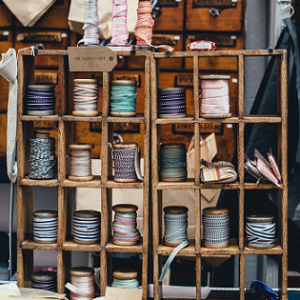
3. Gather capital and funds
The textile business will require a decent amount of investment. The operating cost of manufacturing factory for textile production apart from the rent/cost of the land. The cost of equipment like knitting machines to knit yarn, weaving machines to weave thread, cloth cutting machines to cut cloth, etc. For retailers, again the cost of acquiring land for shops. The funds required to start the inventory and maintain stock for uninterrupted selling.
4. Decide over a name for your textile business and apply for mandatory licenses
After deciding a decent name for your textile business, you would need to acquire following mandatory licenses to legalize your business,
– GSTIN and PAN number
– Trade License
– Shop Establishment License
– Trademark Registration
– Pollution & Factory License, for manufacturers
For textile business name ideas, you can read our blog: Best Textile Shop Names
5. Contact the suppliers
Now once you’re registered and ready with mandatory licenses, you are ready for the next step. In the case of retail textile business, you can now arrange a list of manufacturers and contact them one by one. Detail down the cost they would charge for your initial stock. Choose the manufacturer depending on the transportation cost and select accordingly. Similarly in the case of manufacturing business, arrange a list of suppliers of raw materials. Contact them one by one. Select the supplier that is ready to give you at minimum cost.
6. Prepare a business plan with a good profit margin
In the case of retail, once you’re done with arranging your initial stock to sell. Calculate the total input cost including the rent and electricity of your shop and other labour costs if any. Accordingly estimate a selling cost that gives you maximum profit margin. Keep in mind the cost charged by your competitors. As a retail textile business, your motive is to prepare a business plan that gives you maximum profit margin. Similarly, in the case of manufacturing, calculate the total cost of investment. It includes cost of raw materials, cost of machinery, cost of labour, cost of electricity and rent of the place or any other operational cost. Try to minimize the overall input investment. Accordingly, select a profitable price to sell for your potential buyers.

7. Advertise and market your business
For every business, it’s important to market your product or service to be able to sell to more clients and gain profits, accordingly. Be it manufacturing or retail textile business, you can showcase your product/service in the best presentable way to attract and convert a larger section of potential customers.
Fab3D is one such app which can help textile business owners get new clients/orders with 3X speed, by instantly sharing model draped images of your textile to your potential customers. You don’t need to travel to different locations to sell your fabrics anymore. You can even decide how you fabric will look on a garment, even before manufacturing it and take feedback from your clients, hence getting orders in advance even before manufacturing the garment. Currently there are 100s of textile business owners using Fab3D App to increase the sales of their business and get repeat orders from their customers. Some premium clients include Donear, KGF Fabrics, Siyarams, etc… Try the Fab3D App yourself and get new clients faster than ever before!.
Investment needed to start a textile business in India
There are certain cost you need to keep in mind to estimate the investment needed in Indian textile industry :
1. Cost of Location – For textile manufacturing, you would need a place for the factory for production and inventory to store fabrics. In case of retail business, you would require an investment to buy or rent a shop for selling fabrics.
2. Cost of Manufacturing – In case you’re planning to start as a textile manufacturer, the manufacturing cost includes the cost or rent of purchasing the equipment, cost of setting up the equipment and the additional operational cost which includes cost of maintenance, rent, etc.
3. Cost of Labour – This cost includes the salary of labourers and other employees that would be responsible for the operation of production in case of manufacturing and for selling in case of retail.
4. Cost of Transportation – The transportation cost would include the cost required for transferring fabrics or textiles from the manufacturer to your shop. You can reduce this cost in case you’re planning to get into manufacturing by setting up the factory in the vicinity of your potential buyers.
5. Cost of Marketing/Advertising – This cost includes the cost incurred in the marketing campaigns for your textile business. The cost is obviously more in the case of retail compared to that for manufacturing business.
Subscribe to know more such exciting news and updates on textile business
Textile business opportunities in india.
Considering the spending power and increasing domestic demand for textiles and apparels, there’s a plethora of opportunities to invest in the Indian textile industry. From domestic market to International markets, textiles industry in India has shown a significant positive growth in the last decade. India has an extensive structure of textile and apparel manufacturing with infrastructure spread across the country in numerous clusters. There is an immense scope of investment opportunities in retail businesses looking to start textile and fabric businesses.
The Government of India has been providing a lot of support under the Make In India initiative to encourage companies and businesses to develop , manufacture and assemble products made in India. The objective is to incentivize dedicated investments for manufacturing in the country.
Especially for the textiles and garments Industry, the government is providing several schemes and subsidies for ease of manufacturing and operations for both retailers and manufacturers.
So, decide whether you want to invest in retail or manufacturing depending upon the amount of investment you wish to invest. The manufacturing takes more investment than retail as it includes different operational costs that include cost of manufacturing, cost of labor, etc. Research the market of textiles and fabrics for customer demand, customer paying ability, and market size of different textiles.
Depending on the research, analyze which textile or fabric would be the best profitable investment to put your money into. Register your business and acquire related mandatory licenses. Contact a number of suppliers and choose the supplier that gives you at minimum cost for your initial stock. Calculate the total cost of investment and accordingly, prepare a business plan that gives you maximum profit. Take use of fabric visualization technology, to visualize your fabric onto a model. Therefore, selling your fabrics faster increases your sales significantly.
More Resources:
How to Start a Home Textile Business? – OkCredit
How to start Textile Manufacturing & Export Business in India – Bajaj Finserv
9 Steps to Starting Your Own Textile Business | SmallBizClub
2 Responses
Very useful tips
Thanks for the information I really hope to start my own textile industry in my country.
Leave A Comment Cancel reply
Eager to try.

Digital Draping Software
© 2024 Tri3d.in | All Rights Reserved.
- Term And Conditions
- Privacy Policy

Popular Posts

- What is Manufacturing Technology?

- Total Productive Maintenance for Optimal Performance

- Understanding the Manufacturing Industry

- The 5 Core Principles of Lean Manufacturing: A Comprehensive Guide

- Top Manufacturing Analytics Softwares and How to choose best for you
Top 17 Profitable Textile Business Ideas In India
Gaurav Singh Rawat
- May 8, 2023
- 16 Min Read
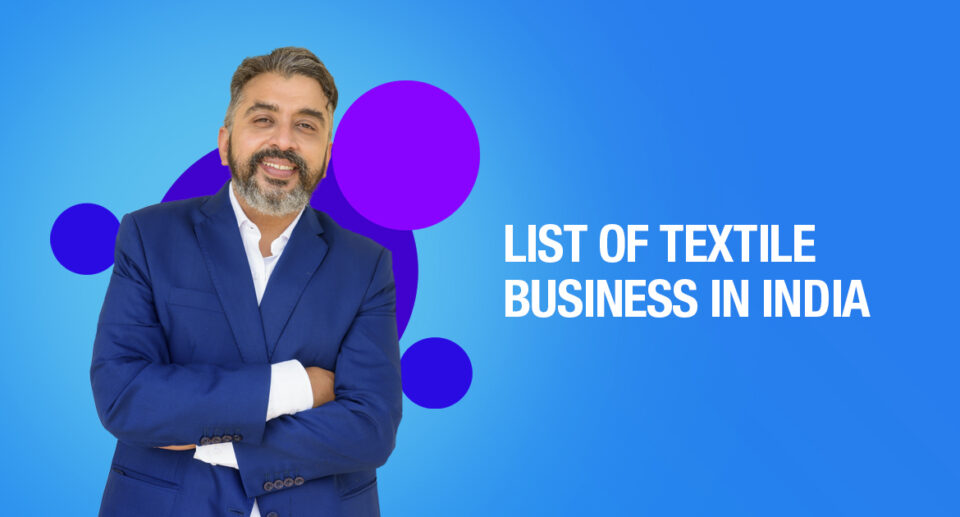
Are you planning to start a textile business but want to know your options for it? read along to know all about the textile business ideas in India and how Lio can smoothen the management process for you.
The textile industry in India is one of the country’s oldest, stretching back several centuries. Even now, with around 13% of overall exports, the textile sector remains one of the most important contributors to India’s exports.
Here’s the magic you need for your textile business. Click the blue button below and get a fully customizable textile category & 20+ readymade textile business templates for free.
Textiles are also a labor-intensive sector and one of the top employers. The textile industry is divided into two categories.
First, there is the unorganized sector, which includes handloom, handicrafts, and sericulture, all of which are small-scale and use traditional tools and methods. The organized industry, which includes the spinning, clothing, and garments segments, employs modern technology and practices such as economies of scale.
Textile business management made easy
Explore Customizable readymade templates in the Textile category. Create Delivery Challans, invoices, & more on the Lio app.
FREE OF COST
In terms of direct and indirect employment generation and net foreign exchange profits, the textile sector has made a significant contribution to the national economy. The industry accounts for around 14% of industrial production, 4% of GDP, and 27% of the country’s foreign exchange outflows. Over 45 million people are directly employed as a result of it.
After agriculture, the textile industry is the second largest employer. As a result, the expansion and overall development of this business have a direct impact on the betterment of India’s economy. The textile sector directly employs 45 million people and indirectly employs another 20 million.
Key facts related to the Indian Textile Industry
- The textile sector in India cover’s everything from garments to fiber and is the second-largest employment-generating industry.
- India’s textile industry provides employment to millions of people in India. Other than this they also provide and promote traditional skills, heritage, and a carrier of heritage.
- The textile business in India is one of the oldest industries in the Indian economy.
- With approximately 11 percent of total exports, the textile sector is one of the largest contributors to India’s export.
- There are two broad segments in the Indian textile industry- The organized and Unorganised sectors. The organized sector has the apparel, spinning, and garments segment which uses modern techniques and machinery like economies of scale.
- The unorganized sector consists of handicrafts, handloom, and sericulture, which are done on a small scale and through traditional methods and tools.

Benefits of Having a Textile Home Business in India
- It is a full-time opportunity to grow the business along with enjoying consistency in revenue generation in the textile business.
- The smallest textile business in India expands globally as a brand at a faster pace.
- The smallest expenditure generates higher and more profitable business returns.
- It is simpler to build up a reputable customer base
- It is easier to remain active on social media platforms, especially for small textile business owners.
- This is a never-ending business.
- making a connection with suppliers and wholesalers is also easier.
Process To Start A Textile Business In India
To start a textile business in India, the following steps should be followed:
- Identify the market gap : Research and identify the gap in the market for a specific type of textile product.
- Plan the business : Prepare a detailed business plan including target market, competition, capital requirement, and marketing strategies.
- Register the business : Register the business as a sole proprietorship, partnership, limited liability partnership, or private limited company as per your preference.
- Obtain licenses and permits : Obtain licenses such as Udyog Aadhaar, GST registration, FSSAI, and others as required by the textile industry.
- Secure funding : Raise capital either through personal savings, loans, or investors.
- Establish the supply chain : Establish relationships with raw material suppliers, manufacturers, and distributors.
- Choose the location : Choose a suitable location for the business, taking into account factors such as accessibility, cost, and proximity to suppliers.
- Set up the production unit : Set up the production unit with the necessary machinery, equipment, and workforce.
- Market the business : Develop a marketing strategy to reach out to the target audience and promote the products.
- Continuously evaluate and improve : Continuously evaluate the business performance and make improvements to stay competitive in the market.
It is important to note that these steps may vary depending on the specific type of textile business and the local regulations in India.
Some Profitable Small and Medium Scale Textile Business Ideas in India
Let us look at some popular textile business ideas in India that you can try.
Sewing Thread Reels
Sewing thread is a typical household item that is used to put things together. Sewing thread balls and reels are in high demand both in India and abroad.
Furthermore, the production process is quite straightforward. Cotton reels and balls are in high demand on the market. Silk, viscose rayon, and polyester cotton reels and balls are also available, however, these are only in demand during certain seasons.
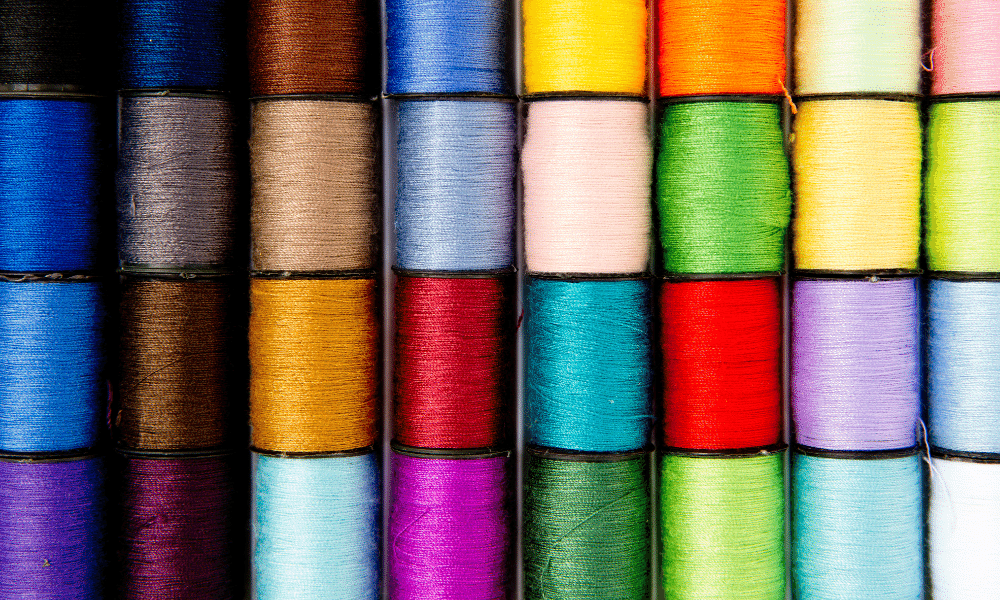
Surgical Cotton
Because of its great fluid absorbency, it is mostly utilized in hospitals, nursing homes, dispensaries, and at home (for first aid), among other places. It is more commonly referred to as absorbent cotton by the general public.
Absorbent cotton, often known as surgical cotton, is utilized at all levels, from medical to corporate to personal. It’s not just utilized as a dressing material; it’s also used as padding for garments, comforters, and other products.
Your textile business manager
Lio app is one app for your textile business management. Record and manage all your data easily in one place.
Surgical cotton is in high demand in hospitals, clinics, nursing homes, and other healthcare facilities. Even small towns are contributing to the expansion of the absorbent cotton business by increasing government health amenities and opening new hospitals and healthcare centers in the private sector.
Surgical cotton is most commonly used in government hospitals and nursing homes. The surgical cotton business has seen a steady expansion in recent years, thanks to the development of medical facilities and increased awareness of personal cleanliness. It is now keeping up with the improvement in education and the upward economic growth of towns and villages.
The need for surgical cotton is expected to rise in the next years, providing enough opportunity for new entrepreneurs to enter the market.

Jute Twine (Jute Rope) & Raw Jute Gunny Bag
Hessian, sacking cloths, bags, ropes, cords, handicrafts, and various textiles are made mostly from jute fiber. India is the world’s largest jute producer. In reality, India and Bangladesh together produce 90 percent of the world’s jute.
Jute bags are mostly used for storing and transporting bulk commodities such as cement, fertilizers, sugar, agricultural products, and other similar items. Jute items are in high demand, and new businesses that open will be successful.
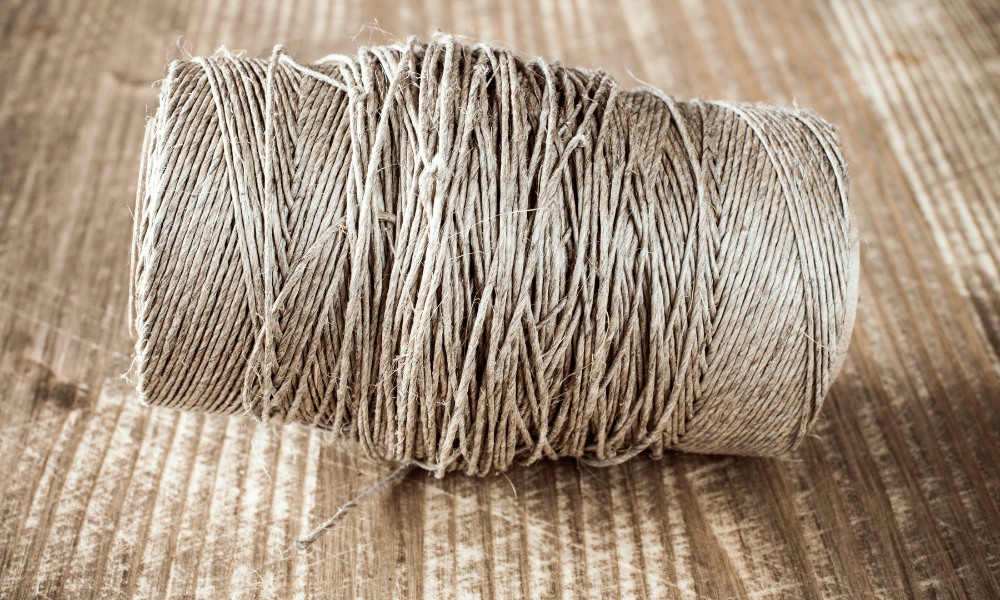
Leather Garments
India produces a significant amount of leather for garments. It’s utilized in footwear, gloves, handbags, and clothing, among other things. Sheep (Lamb) leather is used to make the majority of Indian leather clothing.
The few manufacturers that have emerged in this sector are of very high grade. Bangalore produces around half of the leather garments shipped worldwide, and it has quickly established itself as a major provider of leather garments.
Indian exporters now have a decent understanding of what the western market requires. A handful of existing units have been properly outfitted.
Because of their manufacturing capability in this sector, it is expected that the Indian leather garment industry will have a large part of the global leather garment market in the not-too-distant future.
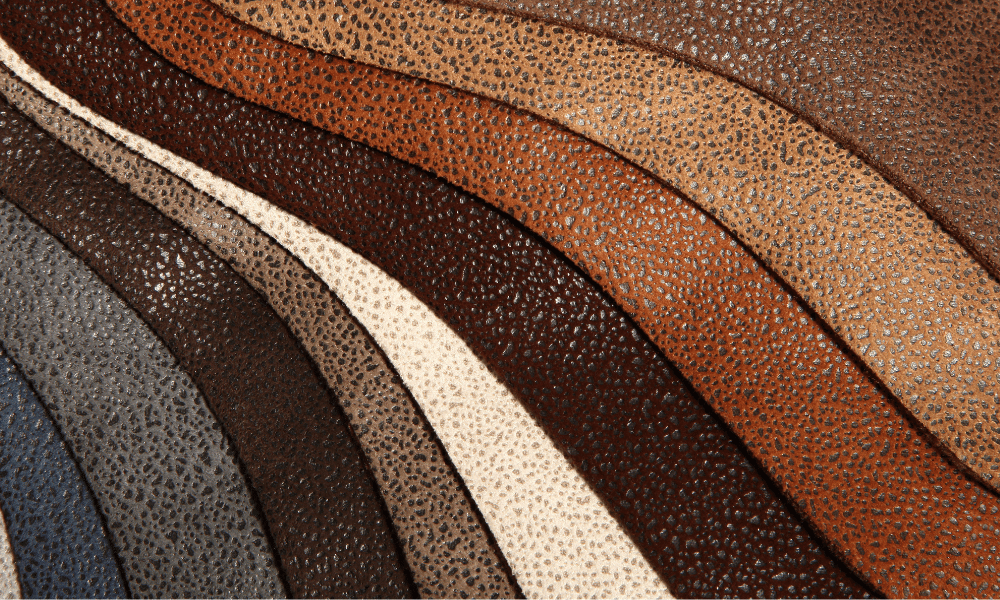
Men’s and Women’s Undergarments
India is one of the members of the BRIC group of countries. India is now ranked second in the world in terms of potential consumption volume.
This country’s large population makes it a viable sales market as well as a substantial human resource reserve for the global economy. Indian clothing has a strong home and export market.
Your business. Your language.
Manage your textile business in your own language. Explore 10 Indian languages Hindi, English, Bangla, Gujarati, Malayalam, etc.
Jute garments.
Jute garments have been increasingly popular in recent years, with many new and unique designs flooding the market, and their demand is skyrocketing.
Every year, the nation exports roughly 5,00,000 tonnes of jute items. As the need for jute garments grows, new entrepreneurs have many opportunities to enter this area.
India is a significant jute-producing country, accounting for more than 40% of global production. Jute fibre is a type of natural fibre. It’s widely used in jute mills to make a wide range of goods, including jute bags, jute carpets, jute blankets, jute fiber foundation woolen blankets, and so on.
It is in high demand both in our domestic market and in international markets. Out of overall commerce, the Indian textile sector caters mostly to the vast domestic market.

Acrylic Blanket for Warming Human Coverage Purpose
The acrylic blanket is a type of synthetic blanket produced from acrylic fabric. It’s a strong, stable fiber with a lot of elongation. It can be kept for a very long period. Good machinery is accessible in India and may also be purchased in Europe.
Acrylic fiber may be found in India. Blankets, both synthetic and non-synthetic, have a sizable market. Acrylic fiber-based goods have a ten percent annual growth rate.
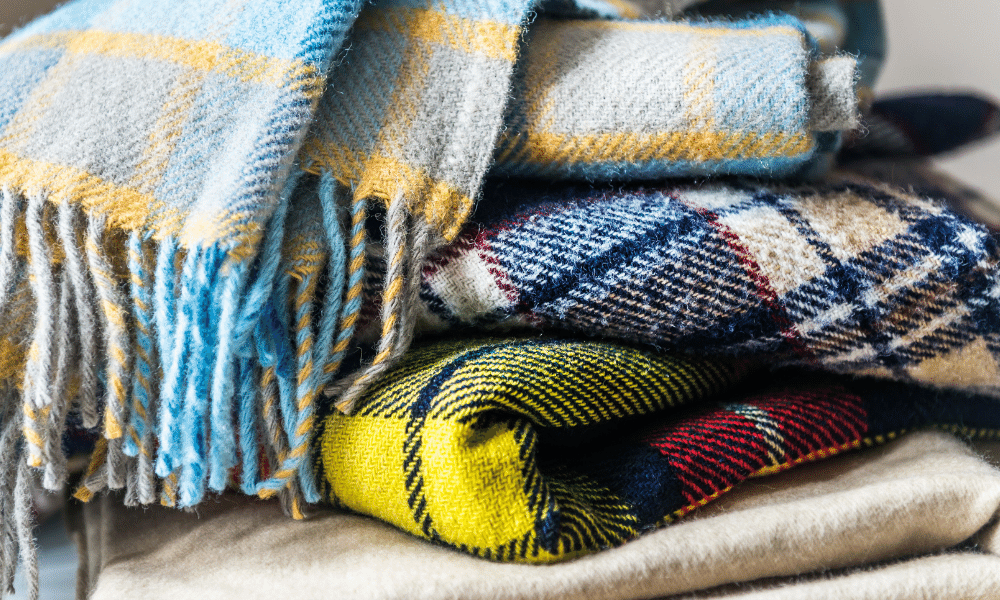
Shirts, Jeans, and Cotton Casuals
Jeans and cotton are regularly worn by people of all socioeconomic backgrounds. Cotton and jeans are used to make casuals and shirts nowadays.
Cotton and jeans-based items are becoming more popular across the world than synthetic fiber-based ones. Because raw materials are readily available in the United States, this product has a large local and international market. This is a field where a newcomer may thrive.
Make decisions instantly.
With Lio app, you can record your data and create dashboards so that you can see everything together and decide better.
Denim garment market.
Denim clothes, often known as jeans casuals, are quite popular among men, women, children, and the elderly.
Denim clothes cover many items, including jeans, trousers, shirts, jackets, ladies’ skirts, and several forms of children’s casuals. Denim purses of various styles are also highly popular.

Designer Saree Making
In India, designer sarees are the most popular. Designer sarees are also a well-known and successful cottage business in India .
You can sell your designer sarees from your own online store or art fairs in addition to supplying boutique owners or merchants.
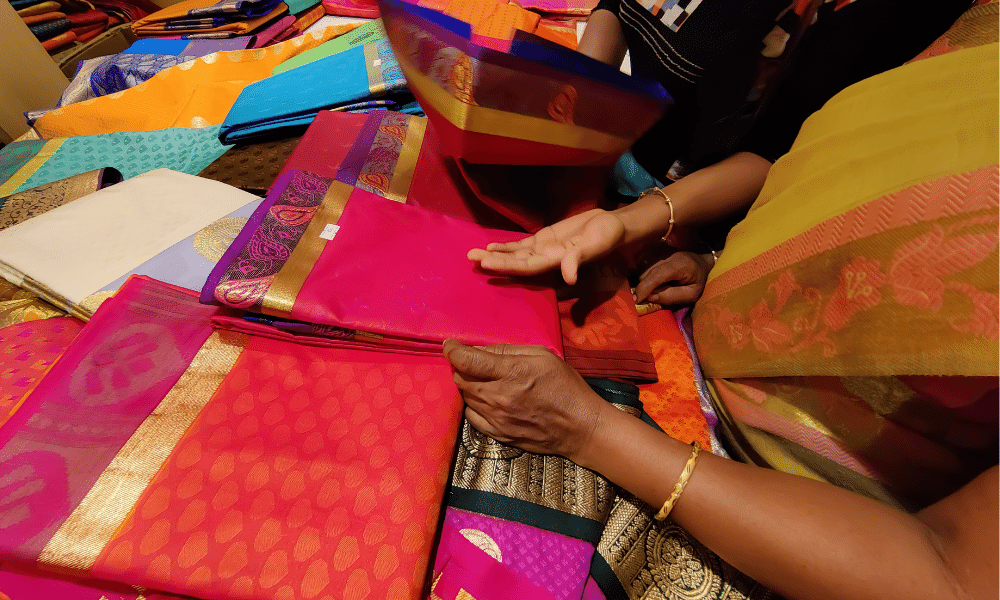
Embroidery Uni t
The financial potential of a computerized or digital embroidery enterprise is enormous. This business may be started by anyone with a little amount of initial cash. Embroidery services are required for everything from standard design to promotional clothes.
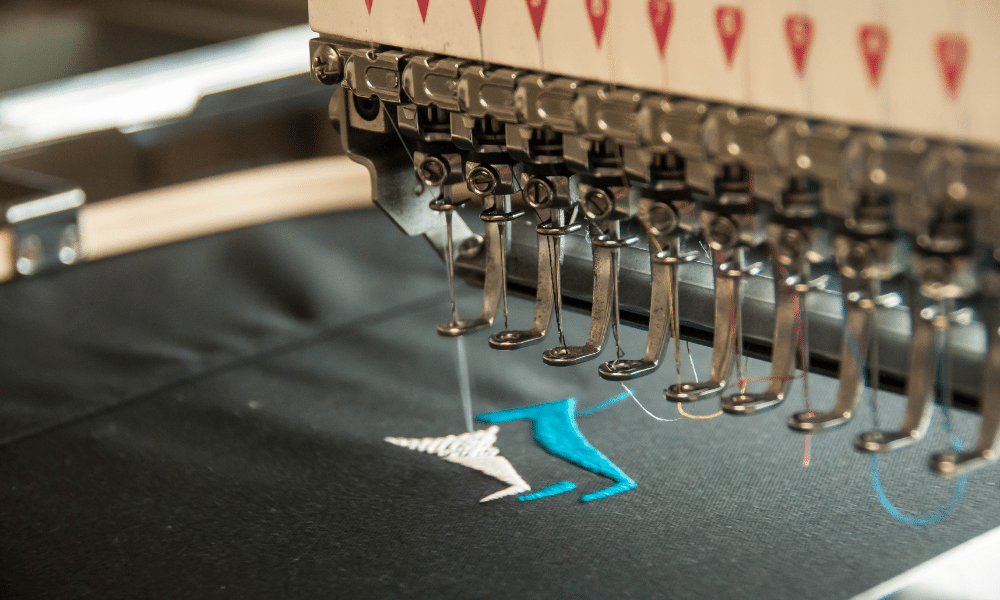
Knitting Garments
The garment knitting company might be as simple as offering a service to large manufacturers or as complex as starting your own clothing line.
You may also supply garment knitting services to well-known companies in this company. You may start your business on a modest scale and then scale it up as your company expands.

Garment Wholesaling
If you have a lot of money to invest, garment wholesaling may be a lucrative business in the apparel sector.
In this form of business, one needs often to invest funds in large-scale purchases. The major emphasis area of marketing in this firm is establishing the appropriate distribution channel.
Work Together.
Work with your Textile team in real time. create documents together and share the same on Whatsapp, Gmail, etc.
Manufacturing of leggings.
Women’s leggings are one of the most popular bottoms. And it’s becoming increasingly popular. With a minimal start-up capital investment, you may establish a leggings manufacturing firm.
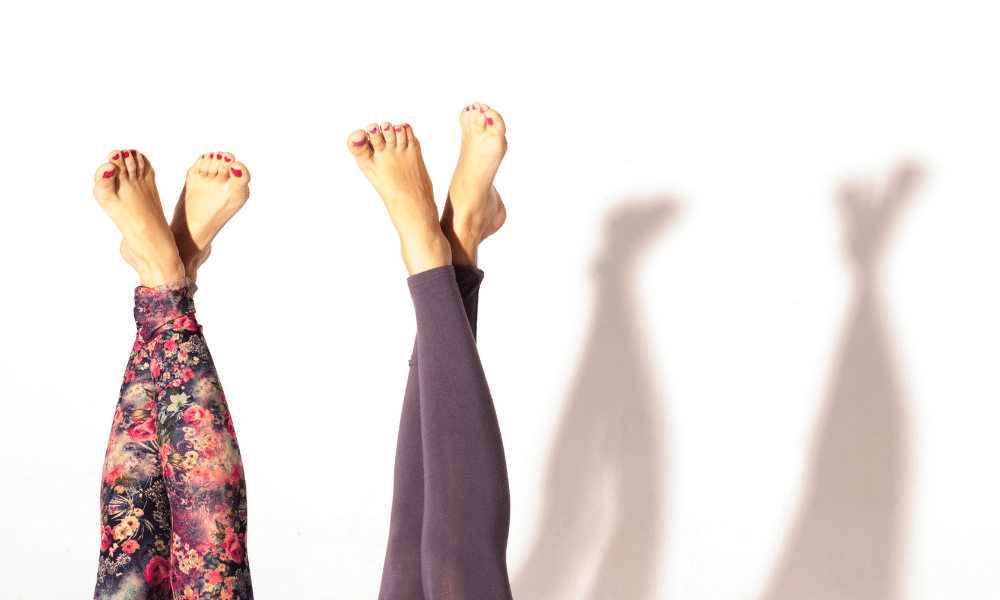
Textile Retails Store
On a modest scale, any individual can open a retail textile store. For suburbia and small towns, this is one of the most successful business ideas in the clothes sector.
Localize your marketing efforts. The most important component in this business is choosing the correct retail location.
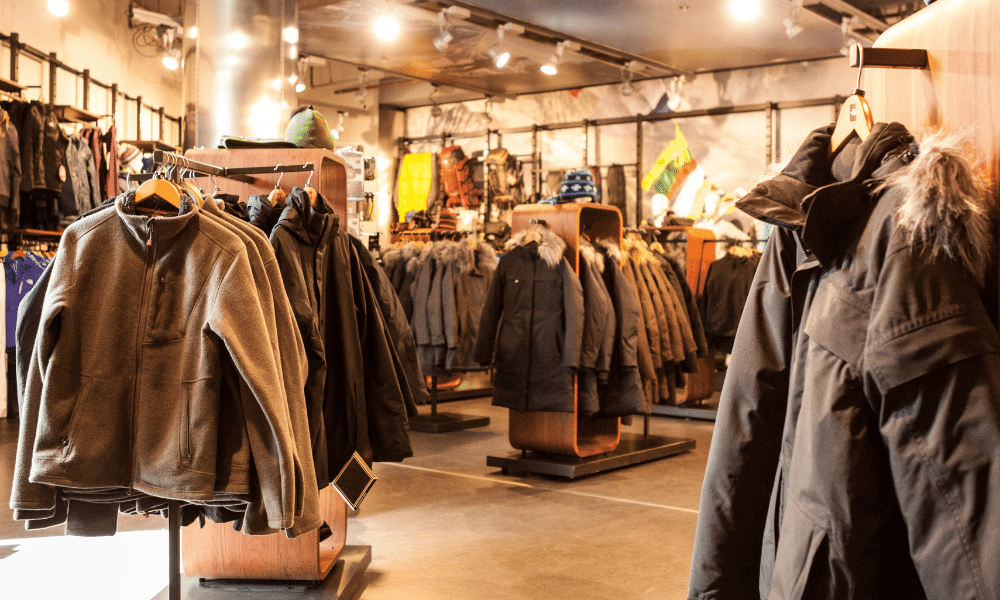
Textile Screen Printing
The method of adding color to cloth in defined patterns or designs is known as textile screen printing. The color binds with the fiber’s incorrectly printed textiles, making them resistant to washing and abrasion. It refers to the creation of designs of any sort that could not be created using traditional weaving/knitting procedures on textile textiles.
Textile screen printing may be used to increase the attractiveness and marketability of completed textiles, curtains, clothing, ladies’ dress materials, bed sheets, bed coverings, fabric for children’s outfits, and gents’ shirts.
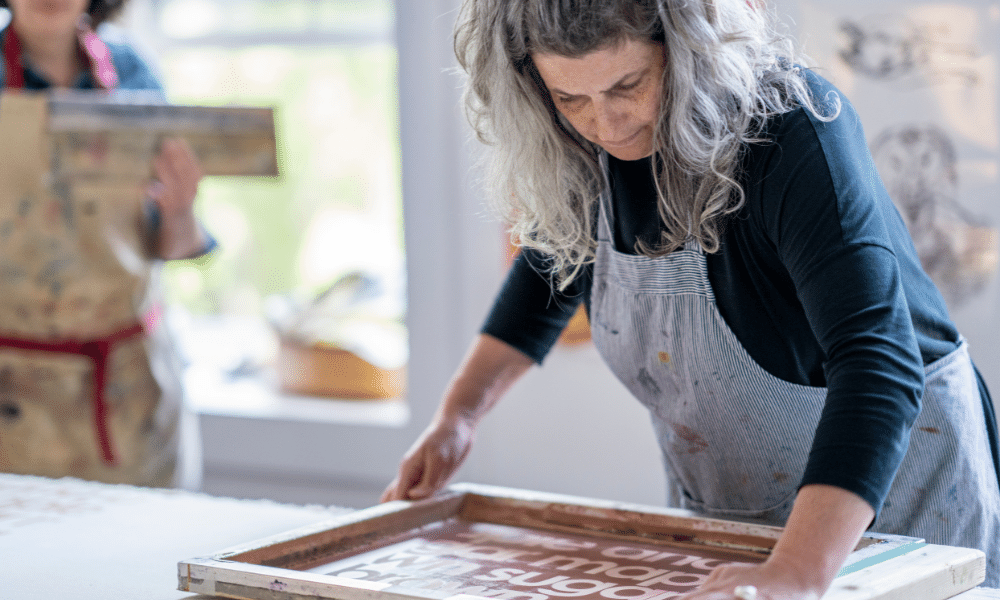
Carpet and Rugs Making
Carpet and rug making is an excellent company to start with a modest investment. Carpets and rugs of all varieties are in high demand all around the world. The devices may be used not only at home but also in the workplace.

How Can Lio assist You With your Textile business?
Lio brings all of your records together in one place, allowing you to access them from your phone at any time and from any location. The most obvious benefit of adopting Lio to manage data within a company is that it saves time and money.
Maximize Your Online Business Potential for just ₹79/month on Lio. Annual plans start at just ₹799 .
A good master will spend less time correcting mistakes, hunting for information, and cleaning up. It provides directors with a detailed picture of the organization’s structure, duties, and assets, which aids them in making decisions.
Lio may be used by business visionaries to examine a collection of data, such as specialist data, news, and company notes.
Lio aids with identifying current actual aspects and removing the uproar in a business’ information portfolio, which is an essential action motivator in any issue impacting the affiliation. Step 1: Select the Language you want to work on | Lio on Android

Step 2: Create your account using your Phone Number or Email Id.

Verify the OTP and you are good to go.
Step 3 : Select a template in which you want to add your data.

Add your Data with our Free Cloud Storage.
Step 4: All Done? Share and Collaborate with your contacts.

How Lio Automation Can Help You Business Process
Business automation is used by not just big businesses but all entrepreneurs and start-ups. It is something that has really helped companies run a smoother process and learn from their mistakes. Companies who have adopted automation have really made a mark and have from 10X faster with the best possible results.
Lio Automation gives you many amazing features that make your work super simple and effective. There are very many features that will help you and your business in various aspects. From connecting and staying in touch with your customers, to working together as a team, and everything in between, Lio Automation will truly make your business run smoothly and make it reach new heights of success.
If you are using Lio Automation for your business processes consider all your data safe and secure all the time. Not only is the data saved in the cloud, but it also offers a data versioning feature in which you can actually see the many changes the document or file has gone through and who has made those changes. You can save the version of the file as required by you.
You can create dashboards for each file which would give you clear details of your company’s operations, marketing campaigns, sales, and other analytics. This is one useful feature that would truly make a difference to your business and help your see all the processes clearly so that you can make well-informed decisions.
Lio Automation also makes working in teams very easy with their Task feature . you can not just assign tasks to your team efficiently. You can set the priority of each task along with the due date. Your team will get a notification about the task automatically, even on Whatsapp, they can see their assigned tasks in the app, mark them complete, and you will get a notification on Whatsapp!
Not just this, Team management and work allocation are made super easy with Lio Automation. You can also work with teams in real time and see all the changes happening.
You can share invoices and receipts with your customers while also sharing the payment links with them to make the whole transaction process smoother and absolutely hassle-free for everyone.
Since customers are a big part of any business and staying in touch with them is a crucial job, Lio automation gives you the ability to automate Whatsapp communications . Automating WhatsApp communication is another popular trend that businesses can benefit from. With the help of this, you would be able to save a lot of time, boost your customer retention and renewals, save a lot of money, lower operating costs, and much more.
There are several other amazing Lio automation features that are made so that you and your business can benefit from them. Excited to know more about it? Start with your Lio automation process for your brand and start your journey to success.
The Indian textiles sector appears to have a bright future, driven by strong local and foreign demand.
With rising consumerism and disposable money, the retail industry has seen considerable expansion in the last decade, with numerous multinational businesses entering the market.
Increased discretionary income has resulted from strong economic development. As an outcome, product demand has increased, resulting in a massive domestic market.
I hope this article helps you in starting the right business of yours in India.
Frequently Asked Questions (FAQs)
How lucrative is the textile industry.
The Indian textile industry provides around 2% of India’s GDP, 10% of manufacturing production, and 14% of the total Index of Industrial Production (IIP).
What Issues Does the Textile Industry Face?
Textiles have a number of challenges, including a scarcity of raw materials. • A rise in the price of basic materials. • The need to adhere to strict social and environmental standards. • Bottlenecks in the infrastructure • Regional growth that is uneven. • Inefficiency as a result of physical labor. • The weaving industry is disorganized.
Is Textile Manufacturing a Profitable Business?
The textile industry is primarily concerned with the design, manufacture, distribution, and marketing of yarn, fabrics, and ready-to-wear clothes.
In the textile sector, there are several business prospects. For new and prospective entrepreneurs, this industry is considered profitable.
What is the Textile Industry’s Profit Margin?
The textile business, according to Rahul Mehta, President of the Clothing Manufacturers Association of India (CMAI), operates on razor-thin margins of 2-3%.
What City is Well-Known For its Textile Industry?
Thousands of people worked in textile mills around the state, and the cotton clothing produced was sold all over the world.
The city’s economy was based on the success of the industry. The city is known as the “Manchester of India.” As a result, Ahmedabad is now known for its cotton textiles.

17 Small Business Ideas in Kolkata [High Return]

17+ Small Village Business Ideas in Karnataka With Low Investment
Hey there, how much investment will I need to start my shirt and jeans retailing business?
Hey Vivaan, For starting your shirt and jeans retail business, you will require initial investment of 5 to 10 lakh. It will include your inventory, cost of business license, location, and staff salary.
This is a very well-researched article. Got to learn a lot about textile businesses.
Hello Tarun, Thank you for sharing your feedback. Will share more articles like these, keep supporting us.
Could you please let me know how much money the carpet-making business will require in investment?
Hello Pious,
The scope of operations and output will have a big impact on how much it will cost to launch a carpet manufacturing company. However, starting a modest carpet manufacturing company will cost between Rs. 10 Lacs and Rs. 25 Lacs. Kindly research well before proceeding.
03 - 05 September 2024 г. Moscow
TEXTILE COLLECTION
MOSCOW AUTUMN
- Apparel sourcing
Clothing fabrics
Equipment for wet-heat treatment
Finished goods (clothes)
| Book a booth |
| Get a free ticket |
WHO VISIT THE EVENT?
MANAGERS & DIRECTORS
TECHNOLOGISTS & SPECIALISTS
CHAIN STORES & DEPARTMENT STORES
CLOTHING & FOOTWEAR MANUFACTURES
BUYERS, DISTRIBUTORS & RETAILERS
SELLERS & MARKETPLACE MANAGERS
TRADE COMPANIES
SEWING ENTERPRISES & FACTORIES
CLOTHING DESIGNERS & ATELIERS
Finishing and fittings
Fibers and yarn
Programs and technologies for digital
printing on fabric
Fashionable accessories
Materials for clothing packaging and labeling
WHY VISIT THE EVENT
Specialists
Official support of the event
Information partners
Mezhdunarodnaya str. 18, Krasnogorsk, Krasnogorsk area, Moscow region.
Access by public transport:
Myakinino metro station – exits to Pavilion 2 or to Crocus City territory.
Access by car*:
Outer side of Moscow City Motor Ring (66 km) – exit to Crocus City territory after Volokolamskoe shosse, direction sign “Crocus City”.
Internal Moscow City Motor Ring (66 km) – exit under the bridge before Volokolamskoe shosse, direction sign “Crocus City”.
*Parking in Crocus Expo is free.
J. V. Stalin
The Tasks of Business Executives
Speech delivered at the first all-union conference of leading personnel of socialist industry 1 february 4, 1931.
Source : Works, Vol. 13, 1930 - January 1934 Publisher : Foreign Languages Publishing House, Moscow, 1954 Transcription/HTML Markup : Salil Sen for MIA, 2008 Public Domain : Marxists Internet Archive (2008). You may freely copy, distribute, display and perform this work; as well as make derivative and commercial works. Please credit "Marxists Internet Archive" as your source.
Comrades, the deliberations of your conference are drawing to a close. You are now about to adopt resolutions. I have no doubt that they will be adopted unanimously. In these resolutions — I am somewhat familiar with them — you approve the control figures of industry for 1931 and pledge yourselves to fulfil them.
A Bolshevik's word is his bond. Bolsheviks are in the habit of fulfilling promises made by them. But what does the pledge to fulfil the control figures for 1931 mean? It means ensuring a total increase of industrial output by 45 per cent. And that is a very big task. More than that. Such a pledge means that you not only pledge yourselves to fulfil our five-year plan in four years — that matter has already been settled, and no more resolutions on it are needed — it means that you promise to fulfil it in three years in all the basic, decisive branches of industry.
It is good that the conference gives a promise to fulfil the plan for 1931, to fulfil the five-year plan in three years. But we have been taught by "bitter experience." We know that promises are not always kept. In the beginning of 1930, too, a promise was given to fulfil the plan for the year. At that time it was necessary to increase the output of our industries by 31 to 32 per cent. But that promise was not kept to the full. Actually, the increase in industrial output during 1930 amounted to 25 per cent. We must ask: Will not the same thing occur again this year? The managers and leading personnel of our industries now promise to increase industrial output in 1931 by 45 per cent. But what guarantee is there that this promise will be kept?
What is needed in order to fulfil the control figures, to achieve a 45 per cent increase in output, to secure the fulfilment of the five-year plan not in four, but, as regards the basic and decisive branches of industry, in three years?
Two fundamental conditions are needed for this.
Firstly, real or, as we term it, "objective" possibilities.
Secondly, the willingness and ability to direct our enterprises in such a way as to realise these possibilities.
Did we have the "objective" possibilities last year for completely fulfilling the plan? Yes, we had. Incontestable facts testify to this. These facts show that in March and April of last year industry achieved an increase of 31 per cent in output compared with the previous year. Why then, it will be asked, did we fail to fulfil the plan for the whole year? What prevented it? What was lacking? The ability to make use of the existing possibilities was lacking. The ability to manage the factories, mills and mines properly was lacking.
We had the first condition: the "objective" possibilities for fulfilling the plan. But we did not have in sufficient degree the second condition: the ability to manage production. And precisely because we lacked the ability to manage the factories, the plan was not fulfilled. Instead of a 31-32 per cent increase we had one of only 25 per cent.
Of course, a 25 per cent increase is a big thing. Not a single capitalist country increased its production in 1930, or is increasing production now. In all capitalist countries without exception a sharp decline in production is taking place. Under such circumstances a 25 per cent increase is a big step forward. But we could have achieved more. We had all the necessary "objective" conditions for this.
And so, what guarantee is there that what happened last year will not be repeated this year, that the plan will be fulfilled, that we shall use the existing possibilities in the way that they should be used, that your promise will not to some extent remain a promise on paper?
In the history of states and countries, in the history of armies, there have been cases when there was every possibility for success and victory, but these possibilities were wasted because the leaders failed to notice them, did not know how to take advantage of them, and the armies suffered defeat.
Have we all the possibilities that are needed to fulfil the control figures for 1931?
Yes, we have such possibilities.
What are these possibilities? What is needed in order that these possibilities should really exist?
First of all, adequate natural resources in the country: iron ore, coal, oil, grain, cotton. Have we these resources? Yes, we have. We have them in larger quantities than any other country. Take the Urals, for example, which provide a combination of resources not to be found in any other country. Ore, coal, oil, grain — what is there not in the Urals? We have everything in our country, except, perhaps, rubber. But within a year or two we shall have our own rubber as well As far as natural resources are concerned we are fully provided. We have even more than necessary. What else is needed?
A government desirous and capable of utilising these immense natural resources for the benefit of the people. Have we such a government? We have. True, our work in utilising natural resources does not always proceed without friction among our leading personnel. For instance, last year the Soviet Government had to conduct a certain amount of struggle over the question of creating a second coal and metallurgical base, without which we cannot develop further. But we have already overcome these obstacles and shall soon have this base.
What else is needed?
That this government should enjoy the support of the vast masses of workers and peasants. Does our government enjoy such support? Yes, it does. You will find no other government in the world that enjoys such support from the workers and peasants as does the Soviet government. There is no need for me to refer to the growth of socialist emulation, the spread of shock-brigade work, the campaign and struggle for counter-plans. All these facts, which vividly demonstrate the support that the vast masses give the Soviet Government, are well known.
What else is needed in order to fulfil and overfulfil the control figures for 1931?
A system that is free from the incurable diseases of capitalism and has great advantages over capitalism. Crises, unemployment, waste, destitution among the masses — such are the incurable diseases of capitalism. Our system does not suffer from these diseases because power is in our hands, in the hands of the working class; because we are conducting a planned economy, systematically accumulating resources and properly distributing them among the different branches of the national economy. We are free from the incurable diseases of capitalism. That is what distinguishes us from capitalism; that is what constitutes our decisive superiority over capitalism.
Notice the way in which the capitalists are trying to escape from the economic crisis. They are reducing the workers' wages as much as possible. They are reducing the prices of raw materials as much as possible. But they do not want to reduce the prices of food and industrial commodities for mass consumption to any important extent. This means that they want to escape from the crisis at the expense of the principal consumers, at the expense of the workers and peasants, at the expense of the working people. The capitalists are cutting the ground from under their own feet. And instead of overcoming the crisis they are aggravating it; new conditions are accumulating which lead to a new, even more severe crisis.
Our superiority lies in the fact that we have no crises of overproduction, we have not and never will have millions of unemployed, we have no anarchy in production, for we are conducting a planned economy. But that is not all. We are a land of the most concentrated industry. This means that we can build our industry on the basis of the best technique and thereby secure an unprecedented productivity of labour, an unprecedented rate of accumulation. Our weakness in the past was that this industry was based upon scattered and small peasant farming. That was so in the past; it is no longer so now. Soon, perhaps within a year, we shall become the country of the largest-scale agriculture in the world. This year, the state farms and collective farms — and these are forms of large-scale farming — have already supplied half of all our marketable grain. And that means that our system, the Soviet system, affords us opportunities of rapid progress of which not a single bourgeois country can dream.
What else is needed in order to advance with giant strides?
A party sufficiently solid and united to direct the efforts of all the best members of the working class to one point, and sufficiently experienced to be unafraid of difficulties and to pursue systematically a correct, revolutionary, Bolshevik policy. Have we such a party? Yes, we have. Is its policy correct? Yes, it is, for it is yielding important successes. This is now admitted not only by the friends but also by the enemies of the working class. See how all the well-known "honourable" gentlemen, Fish in America, Churchill in Britain, Poincare in France, fume and rave against our Party. Why do they fume and rave? Because the policy of our Party is correct, because it is yielding success after success.
There, comrades, you have all those objective possibilities which assist us in realising the control figures for 1931, which help us to fulfil the five-year plan in four years, and in the key industries even in three years.
Thus we have the first condition for fulfilment of the plan — the "objective" possibilities.
Have we the second condition, the ability to use these possibilities?
In other words, are our factories, mills and mines properly managed? Is everything in order in this respect?
Unfortunately, not everything is in order here. And, as Bolsheviks, we must say this plainly and frankly.
What does management of production mean? There are people among us who do not always have a Bolshevik approach to the question of the management of our factories. There are many people among us who think that management is synonymous with signing papers and orders. This is sad, but true. At times one cannot help recalling Shchedrin's Pompadours. Do you remember how Madame Pompadour taught the young Pompadour: "Don't bother your head with science, don't go into matters, let others do that, it is not your business — your business is to sign papers." It must be admitted to our shame that even among us Bolsheviks there are not a few who carry out management by signing papers. But as for going into matters, mastering technique, becoming master of the business — why, that is out of the question.
How is it that we Bolsheviks, who have made three revolutions, who emerged victorious from the bitter civil war, who have solved the tremendous task of building a modern industry, who have swung the peasantry on to the path of socialism — how is it that in the matter of the management of production we bow to a slip of paper?
The reason is that it is easier to sign papers than to manage production. And so, many economic executives are taking this line of least resistance. We, too, in the centre, are also to blame. About ten years ago a slogan was issued: "Since Communists do not yet properly understand the technique of production, since they have yet to learn the art of management, let the old technicians and engineers — the experts — carry on production, and you, Communists, do not interfere with the technique of the business; but, while not interfering, study technique, study the art of management tirelessly, in order later on, together with the experts who are loyal to us, to become true managers of production, true masters of the business." Such was the slogan. But what actually happened? The second part of this formula was cast aside, for it is harder to study than to sign papers; and the first part of the formula was vulgarised: non-interference was interpreted to mean refraining from studying the technique of production. The result has been nonsense, harmful and dangerous nonsense, which the sooner we discard the better.
Life itself has more than once warned us that all was not well in this field. The Shakhty affair 2 was the first grave warning. The Shakhty affair showed that the Party organisations and the trade unions lacked revolutionary vigilance. It showed that our economic executives were disgracefully backward in technical knowledge; that some of the old engineers and technicians, working without supervision, rather easily go over to wrecking activities, especially as they are constantly being besieged by "offers" from our enemies abroad.
The second warning was the "Industrial Party" trial 3 .
Of course, the underlying cause of wrecking activities is the class struggle. Of course, the class enemy furiously resists the socialist offensive. This alone, however, is not an adequate explanation for the luxuriant growth of wrecking activities.
How is it that wrecking activities assumed such wide dimensions? Who is to blame for this? We are to blame. Had we handled the business of managing production differently, had we started much earlier to learn the technique of the business, to master technique, had we more frequently and efficiently intervened in the management of production, the wreckers would not have succeeded in doing so much damage.
We must ourselves become experts, masters of the business; we must turn to technical science — such was the lesson life itself was teaching us. But neither the first warning nor even the second brought about the necessary change. It is time, high time that we turned towards technique. It is time to discard the old slogan, the obsolete slogan of non-interference in technique, and ourselves become specialists, experts, complete masters of our economic affairs.
It is frequently asked: Why have we not one-man management? We do not have it and we shall not get it until we have mastered technique. Until there are among us Bolsheviks a sufficient number of people thoroughly familiar with technique, economy and finance, we shall not have real one-man management. You can write as many resolutions as you please, take as many vows as you please, but, unless you master the technique, economy and finance of the mill, factory or mine, nothing will come of it, there will be no one-man management.
Hence, the task is for us to master technique ourselves, to become masters of the business ourselves. This is the sole guarantee that our plans will be carried out in full, and that one-man management will be established.
This, of course, is no easy matter; but it can certainly be accomplished. Science, technical experience, knowledge, are all things that can be acquired. We may not have them today, but tomorrow we shall. The main thing is to have the passionate Bolshevik desire to master technique, to master the science of production. Everything can be achieved, everything can be overcome, if there is a passionate desire for it.
It is sometimes asked whether it is not possible to slow down the tempo somewhat, to put a check on the movement. No, comrades, it is not possible! The tempo must not be reduced! On the contrary, we must increase it as much as is within our powers and possibilities. This is dictated to us by our obligations to the workers and peasants of the U.S.S.R. This is dictated to us by our obligations to the working class of the whole world.
To slacken the tempo would mean falling behind. And those who fall behind get beaten. But we do not want to be beaten. No, we refuse to be beaten! One feature of the history of old Russia was the continual beatings she suffered because of her backwardness. She was beaten by the Mongol khans. She was beaten by the Turkish beys. She was beaten by the Swedish feudal lords. She was beaten by the Polish and Lithuanian gentry. She was beaten by the British and French capitalists. She was beaten by the Japanese barons. All beat her — because of her backwardness, because of her military backwardness, cultural backwardness, political backwardness, industrial backwardness, agricultural backwardness. They beat her because it was profitable and could be done with impunity. You remember the words of the pre-revolutionary poet: "You are poor and abundant, mighty and impotent, Mother Russia." 4 Those gentlemen were quite familiar with the verses of the old poet. They beat her, saying: "You are abundant," so one can enrich oneself at your expense. They beat her, saying: "You are poor and impotent," so you can be beaten and plundered with impunity. Such is the law of the exploiters — to beat the backward and the weak. It is the jungle law of capitalism. You are backward, you are weak — therefore you are wrong; hence you can be beaten and enslaved. You are mighty — therefore you are right; hence we must be wary of you.
That is why we must no longer lag behind.
In the past we had no fatherland, nor could we have had one. But now that we have overthrown capitalism and power is in our hands, in the hands of the people, we have a fatherland, and we will uphold its independence. Do you want our socialist fatherland to be beaten and to lose its independence? If you do not want this, you must put an end to its backwardness in the shortest possible time and develop a genuine Bolshevik tempo in building up its socialist economy. There is no other way. That is why Lenin said on the eve of the October Revolution: "Either perish, or overtake and outstrip the advanced capitalist countries."
We are fifty or a hundred years behind the advanced countries. We must make good this distance in ten years. Either we do it, or we shall go under.
That is what our obligations to the workers and peasants of the U.S.S.R. dictate to us.
But we have yet other, more serious and more important, obligations. They are our obligations to the world proletariat. They coincide with our obligations to the workers and peasants of the U.S.S.R. But we place them higher. The working class of the U.S.S.R. is part of the world working class. We achieved victory not solely through the efforts of the working class of the U.S.S.R., but also thanks to the support of the working class of the world. Without this support we would have been torn to pieces long ago. It is said that our country is the shock brigade of the proletariat of all countries. That is well said. But is imposes very serious obligations upon us. Why does the international proletariat support us? How did we merit this support? By the fact that we were the first to hurl ourselves into the battle against capitalism, we were the first to establish working-class state power, we were the first to begin building socialism. By the fact that we were engaged on a cause which, if successful, will transform the whole world and free the entire working class. But what is needed for success? The elimination of our backwardness, the development of a high Bolshevik tempo of construction. We must march forward in such a way that the working class of the whole world, looking at us, may say: There you have my advanced detachment, my shock brigade, my working-class state power, my fatherland; they are engaged on their cause, our cause, and they are working well; let us support them against the capitalists and promote the cause of the world revolution. Must we not justify the hopes of the world's working class, must we not fulfil our obligations to them? Yes, we must if we do not want to utterly disgrace ourselves.
Such are our obligations, internal and international. As you see, they dictate to us a Bolshevik tempo of development.
I will not say that we have accomplished nothing in regard to management of production during these years. In fact, we have accomplished a good deal. We have doubled our industrial output compared with the pre-war level. We have created the largest-scale agricultural production in the world. But we could have accomplished still more if we had tried during this period really to master production, the technique of production, the financial and economic side of it.
In ten years at most we must make good the distance that separates us from the advanced capitalist countries. We have all the "objective" possibilities for this. The only thing lacking is the ability to make proper use of these possibilities. And that depends on us. Only on us! It is time we learned to make use of these possibilities. It is time to put an end to the rotten line of non-interference in production. It is time to adopt a new line, one corresponding to the present period — the line of interfering in everything. If you are a factory manager — interfere in all the affairs of the factory, look into everything, let nothing escape you, learn and learn again. Bolsheviks must master technique. It is time Bolsheviks themselves became experts. In the period of reconstruction, technique decides everything. And an economic executive who does not want to study technique, who does not want to master technique, is a joke and not an executive.
It is said that it is hard to master technique. That is not true! There are no fortresses that Bolsheviks cannot capture. We have solved a number of most difficult problems. We have overthrown capitalism. We have assumed power. We have built up a huge socialist industry. We have transferred the middle peasants on to the path of socialism. We have already accomplished what is most important from the point of view of construction. What remains to be done is not so much: to study technique, to master science. And when we have done that we shall develop a tempo of which we dare not even dream at present.
And we shall do it if we really want to.
Pravda, No. 35, February 5, 1931
Collected Works Index | Volume 13 Index Works by Decade | J. V. Stalin Archive
Advertisement
Supported by
latest in US News

Dem VP candidate Tim Walz spoke for 1/4 of Kamala Harris' first...

Incredible pics show four historic homes being wheeled through...

Iranian regime funneling money into anti-Israel groups and campus...

Stranded astronauts could face further delays returning to Earth...

NHL star, brother struck and killed by car in NJ while riding...

Mark Zuckerberg ripped for claiming he didn't realize $400M in...

Boeing execs fought NASA in heated arguments about stranded...

NYC football coach accused of smashing student's head into wall...
Missing nyc lawyer shared haunting final post before vanishing on bayesian yacht with jewelry designer wife.
A top New York City lawyer who has been missing ever since the Bayesian yacht sank off the coast of Italy on Monday morning had eerily written about his family living “happily ever after” in one of his final social media posts before vanishing with his wife in the shipwreck.
Christopher Morvillo, a 59-year-old lawyer who helped British tech tycoon Mike Lynch — the owner of the capsized luxury boat and one of the six people missing — win his fraud trial , thanked the legal team who helped their success in his penultimate LinkedIn post before the tragedy.
At the end of the eerie post , he wrote: “And, finally, a huge thank you to my patient and incredible wife, Neda Morvillo, and my two strong, brilliant, and beautiful daughters, Sabrina Morvillo and Sophia Morvillo.”

“None of this would have been possible without your love and support. I am so glad to be home. And they all lived happily ever after….”
Morvillo is a partner at white-collar law firm Clifford Chance, which has an office on Fifth Avenue in Manhattan. He is a former federal prosecutor who worked on the criminal investigation of the Sept. 11 terror attacks, according to his online bio. He specializes in cases involving insider trading and corporate fraud.
Clifford Chance celebrated Lynch’s acquittal in a June 6 press release on its site. Lynch was accused of fraud related to Hewlett Packard’s acquisition of his company, Autonomy.
“The acquittal ends a 13-year legal battle, regarded as one of Silicon Valley’s biggest-ever fraud cases,” the firm said.

Morvillo and his co-counsel added, “This verdict closes the book on a relentless 13-year effort to pin HP’s well-documented ineptitude on Dr. Lynch. Thankfully, the truth has finally prevailed. We thank Dr. Lynch for his trust throughout this ordeal and hope that he can now return home to England to resume his life and continue innovating.”
What to know after a tornado sank the yacht Bayesian off the coast of Sicily:
- A superyacht capsized off the coast of Sicily after a tornado hit the area early Monday, killing seven passengers.
- British tech tycoon Mike Lynch was identified as one of the bodies pulled from the wreckage. His teenage daughter, Hannah, was the final one to be recovered.
- Lynch — known as “Britain’s Bill Gates” — had invited guests from Clifford Chance, a legal firm that represented him, and Invoke Capital, his own company, on the voyage, according to the Telegraph .
- Security camera footage shot from 650 feet from where the Bayesian sank Monday shows it disappearing.
- A rare and unexpected “black swan” weather event may have led to the Bayesian’s speedy demise , maritime experts say.

The press release ends with a statement from Lynch, saying, ” I am looking forward to returning to the UK and getting back to what I love most: my family and innovating in my field.”
Morvillo’s wife, Neda, a jewelry designer, is also one of the six passengers still missing, officials said.
The 160-foot luxury sailboat with 22 people aboard sank off the port of Porticello when a violent storm struck at sunrise Monday, the Italian coast guard said.

Police divers resumed their search for the missing passengers Tuesday, attempting to reach the ship’s hull some 164 feet underwater, where officials believe people may be trapped.
The search for those missing has been slow because the Bayesian now sits 50 meters below the surface, where divers can only stay for up to 12 minutes, fire rescue officials said in a statement Tuesday.
Fifteen of the ship’s passengers and crew have survived, including a mother who was holding her 1-year-old daughter above her head to keep her from drowning.

One body has been recovered and identified as the on-board chef, officials said.
Fire officials have said the six people unaccounted for will be referred to as “missing” until they are located in the wreckage.
In addition to the Morvillos and Lynch, the missing include Lynch’s 18-year-old daughter, Hannah, as well as Jonathan Bloomer, a chairman at Morgan Stanley International, and Bloomer’s wife, Judy.

Morvillo, who has residences in New York City and South Kent, Connecticut, hails from a family of lawyers.
In an interview with the American Lawyer in 2018, he described working alongside his late father and three brothers at the firm, Morvillo Abramowitz.
“I learned more during those years than at any other point in my career, largely from just watching my father skillfully navigate clients through some of the most complex challenges that this job can throw at you,” he said. “He was the best mentor I’ve ever had.”
With Post wires

Advertisement
Please use a modern browser to view this website. Some elements might not work as expected when using Internet Explorer.
- Landing Page
- Luxury Yacht Vacation Types
- Corporate Yacht Charter
- Tailor Made Vacations
- Luxury Exploration Vacations
- View All 3699
- Motor Yachts
- Sailing Yachts
- Classic Yachts
- Catamaran Yachts
- Filter By Destination
- More Filters
- Latest Reviews
- Charter Special Offers
- Destination Guides
- Inspiration & Features
- Mediterranean Charter Yachts
- France Charter Yachts
- Italy Charter Yachts
- Croatia Charter Yachts
- Greece Charter Yachts
- Turkey Charter Yachts
- Bahamas Charter Yachts
- Caribbean Charter Yachts
- Australia Charter Yachts
- Thailand Charter Yachts
- Dubai Charter Yachts
- Destination News
- New To Fleet
- Charter Fleet Updates
- Special Offers
- Industry News
- Yacht Shows
- Corporate Charter
- Finding a Yacht Broker
- Charter Preferences
- Questions & Answers
- Add my yacht
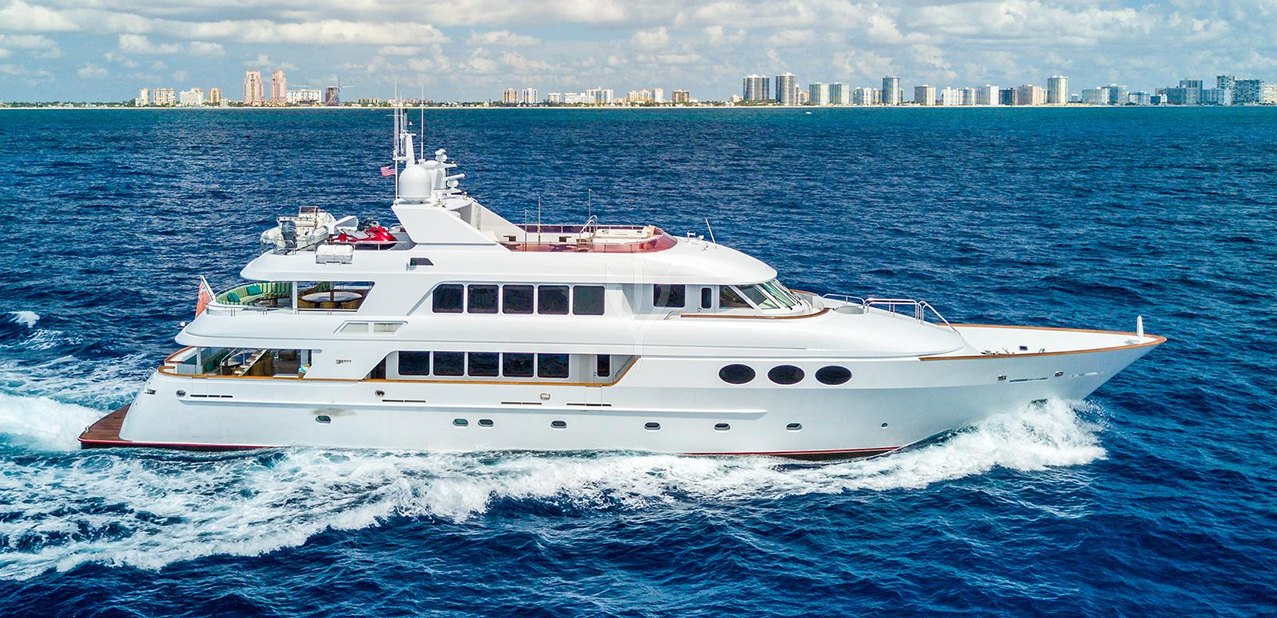
View More Photos
- Luxury Charter Yachts
- Motor Yachts for Charter
- Amenities & Toys
- Rates & Regions
- + Shortlist
RELENTLESS YACHT CHARTER
44.2m / 145' trinity yachts 2001.
- Previous Yacht
Cabin Configuration
Special Features:
- Impressive 5,000nm range
- Sleeps 10 guests
- 8.84m/29' Intrepid Sports Tender
- Shallow draft and fast speeds for reef exploration
Superyacht Relentless is a thrilling yacht charter vessel for those looking to cruise the open seas in large numbers in the utmost comfort
The 43.28m/142' 'Relentless' motor yacht built by the American shipyard Trinity Yachts is available for charter for up to 10 guests in 5 cabins. This yacht features interior styling by Dee Robinson Interiors.
Built in 2001, Relentless offers beautifully proportioned decks for exquisite indoor/outdoor living during a luxury yacht charter .
Guest Accommodation
Relentless offers guest accommodation for up to 10 guests in 5 suites comprising a master suite, three double cabins and one twin cabin. There are 6 beds in total, including 3 king, 1 queen and 2 singles. She is also capable of carrying up to 9 crew onboard to ensure a relaxed luxury yacht charter experience.
Onboard Comfort & Entertainment
On your charter, you'll find plenty to keep you busy and entertained, notably a gym with all the latest equipment to maintain your fitness routine. Retreat to the deck jacuzzi and soak up the scenery.
Relentless benefits from some excellent features to improve your charter, notably Wi-Fi connectivity, allowing you to stay connected at all times, should you wish. Guests will experience complete comfort while chartering thanks to air conditioning.
Performance & Range
Built with a aluminium hull and aluminium superstructure, she benefits from a semi-displacement hull to provide exceptional seakeeping and impressive speeds. Powered by twin MTU engines, she comfortably cruises at 15 knots, reaches a maximum speed of 18 knots with a range of up to 5,000 nautical miles from her 41,635 litre fuel tanks at 10 knots. With a shallow draft of 2.1m/6'11" Relentless can anchor closer to coves and sheltered bays overnight. An on board stabilization system ensures comfort when underway.
Relentless has a good selection of water toys and accessories to entertain you and your guests whilst on charter. Guests can experience the thrill and adventure of riding one of the two Yamaha GP800R WaveRunners. In addition there are waterskis that are hugely entertaining whether you are a beginner or a seasoned pro. Another excellent feature are wakeboards so guests can show off at speed. If that isn't enough Relentless also features kayaks, fishing equipment, inflatable water toys, kneeboards and snorkelling equipment. Relentless features two tenders, but leading the pack is a 8.84m/29' Intrepid Sports Tender to transport you in style.
Based in the magical waters of the Caribbean all year round Relentless is ready for your next luxury yacht charter. Let Relentless Discover the magical places, food and experiences of the the Caribbean.
With its luxurious interiors, vast array of onboard facilities and a highly-trained and professional crew, a luxury yacht vacation onboard motor yacht Relentless promises to be nothing short of spectacular.
TESTIMONIALS
There are currently no testimonials for Relentless, please provide .
Relentless Photos
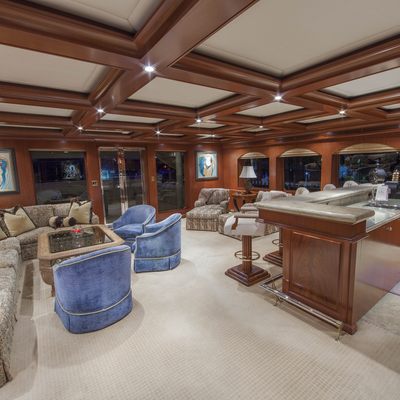
| Length | 44.2m / 145' |
| Beam | 8.2m / 26'11 |
| Draft | 2.1m / 6'11 |
| Gross Tonnage | 391 GT |
| Cruising Speed | 15 Knots |
| Built | |
| Builder | Trinity Yachts |
| Model | Custom |
| Exterior Designer | Trinity Yachts |
| Interior Design | Dee Robinson Interiors |
Amenities & Entertainment
For your relaxation and entertainment Relentless has the following facilities, for more details please speak to your yacht charter broker.
Relentless is reported to be available to Charter with the following recreation facilities:
- 1 x 8.84m / 29' Intrepid Sports Tender with 2 x Yamaha 225 HP engines
- 1 x 5.18m / 17' Novurania Tender with 1 x 115 HP engine
For a full list of all available amenities & entertainment facilities, or price to hire additional equipment please contact your broker.
- + shortlist
For a full list of all available amenities & entertainment facilities, or price to hire additional equipment please contact your broker.
'Relentless' Charter Rates & Destinations

Summer Season
May - September
$150,000 p/week + expenses
High Season
Cruising Regions
Caribbean Bahamas

Winter Season
October - April
Caribbean Antigua, Bahamas, Saint Martin, St Barts
HOT SPOTS: Virgin Islands
Charter Relentless
To charter this luxury yacht contact your charter broker , or we can help you.
To charter this luxury yacht contact your charter broker or
Update your yacht
Yacht Owner, Captain or Central Agents - Send us latest Photos, Charter Rates or Corrections Send Updates
SIMILAR YACHTS FOR CHARTER
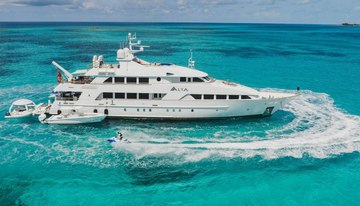
44m | Palmer Johnson
from $185,000 p/week
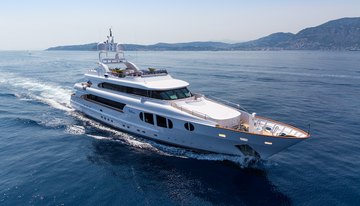
43m | Mondo Marine
from $161,000 p/week ♦︎
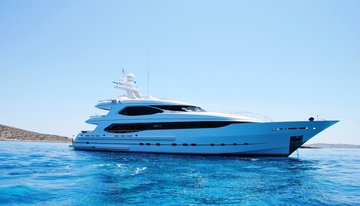
42m | Oceanco
from $118,000 p/week ♦︎
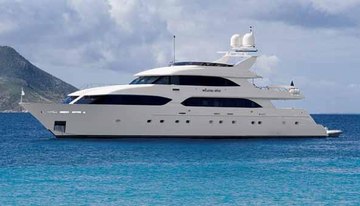
43m | Westship
from $106,000 p/week ♦︎

from $129,000 p/week ♦︎
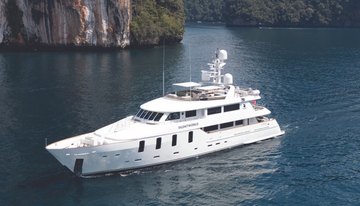
Silentworld
40m | Cies - Oassive
from $130,000 p/week
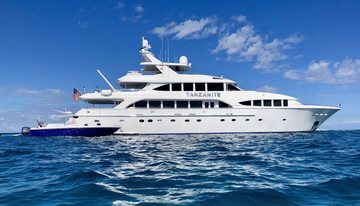
44m | Westship
from $135,000 p/week
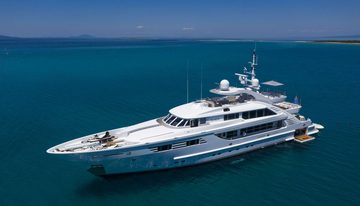
from $155,000 p/week
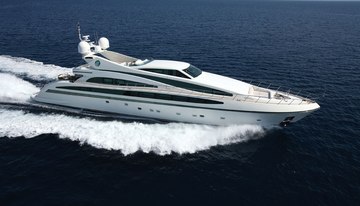
from $75,000 p/week
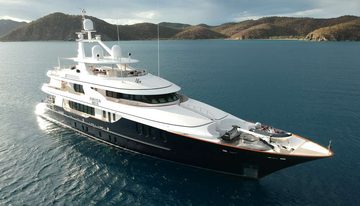
46m | Hakvoort
from $200,000 p/week

48m | Christensen
from $175,000 p/week
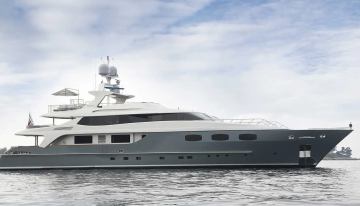
43m | Baglietto
from $139,000 p/week ♦︎
NOTE to U.S. Customs & Border Protection
Specification
SEASONAL CHARTER RATES
- Share on Facebook
- Share Yacht
SIMILAR LUXURY CHARTER YACHTS
Here are a selection of yachts which are similar to the current charter yacht. To view all similar luxury charter yachts click on the button below.
As Featured In
The YachtCharterFleet Difference
YachtCharterFleet makes it easy to find the yacht charter vacation that is right for you. We combine thousands of yacht listings with local destination information, sample itineraries and experiences to deliver the world's most comprehensive yacht charter website.
San Francisco
- Like us on Facebook
- Follow us on Twitter
- Follow us on Instagram
- Find us on LinkedIn
- Add My Yacht
- Affiliates & Partners
Popular Destinations & Events
- St Tropez Yacht Charter
- Monaco Yacht Charter
- St Barts Yacht Charter
- Greece Yacht Charter
- Mykonos Yacht Charter
- Caribbean Yacht Charter
Featured Charter Yachts
- Maltese Falcon Yacht Charter
- Wheels Yacht Charter
- Victorious Yacht Charter
- Andrea Yacht Charter
- Titania Yacht Charter
- Ahpo Yacht Charter
Receive our latest offers, trends and stories direct to your inbox.
Please enter a valid e-mail.
Thanks for subscribing.
Search for Yachts, Destinations, Events, News... everything related to Luxury Yachts for Charter.
Yachts in your shortlist
UK Edition Change
- UK Politics
- News Videos
- Paris 2024 Olympics
- Rugby Union
- Sport Videos
- John Rentoul
- Mary Dejevsky
- Andrew Grice
- Sean O’Grady
- Photography
- Theatre & Dance
- Culture Videos
- Fitness & Wellbeing
- Food & Drink
- Health & Families
- Royal Family
- Electric Vehicles
- Car Insurance Deals
- Lifestyle Videos
- UK Hotel Reviews
- News & Advice
- Simon Calder
- Australia & New Zealand
- South America
- C. America & Caribbean
- Middle East
- Politics Explained
- News Analysis
- Today’s Edition
- Home & Garden
- Broadband deals
- Fashion & Beauty
- Travel & Outdoors
- Sports & Fitness
- Climate 100
- Sustainable Living
- Climate Videos
- Solar Panels
- Behind The Headlines
- On The Ground
- Decomplicated
- You Ask The Questions
- Binge Watch
- Travel Smart
- Watch on your TV
- Crosswords & Puzzles
- Most Commented
- Newsletters
- Ask Me Anything
- Virtual Events
- Wine Offers
- Betting Sites
Thank you for registering
Please refresh the page or navigate to another page on the site to be automatically logged in Please refresh your browser to be logged in
NYC lawyer who died in yacht disaster wrote haunting LinkedIn post weeks before
Christopher morvillo formerly worked as a prosecutor investigating the september 11 terror attacks, article bookmarked.
Find your bookmarks in your Independent Premium section, under my profile

The latest headlines from our reporters across the US sent straight to your inbox each weekday
Your briefing on the latest headlines from across the us, thanks for signing up to the evening headlines email.
A New York City lawyer who died after a yacht sank off the coast of Sicily wrote a haunting post on LinkedIn two months before he joined the doomed voyage.
In one of his only posts on the site , Christopher Morvillo, 59, thanked his legal team after they helped British tech tycoon Mike Lynch win a fraud trial and discussed living “happily ever after.”
Lynch owned the luxury yacht Bayesian , which sank early on Monday.
Five bodies, believed to be those of Lynch, Morvillo, Morvillo's wife Neda, British banker Jonathan Bloomer and his wife Judy have now be recovered by authorities, according to The Associated Press . One woman remains missing. She has not been identified, but Hannah Lynch, Lynch’s 18-year-old daughter, is reportedly unaccounted for.
The remaining passengers have all been found. One person, the ship's chef, died in the storm.

In the LinkedIn post, Morvillo thanked his legal team and his family, and ended with a now poignant flourish.
“And, finally, a huge thank you to my patient and incredible wife, Neda Morvillo, and my two strong, brilliant, and beautiful daughters, Sabrina Morvillo and Sophia Morvillo," he wrote. “None of this would have been possible without your love and support. I am so glad to be home. And they all lived happily ever after….”

Morvillo was a partner at Clifford Chance, a white-collar law firm with offices on Fifth Avenue in Manhattan. He previously worked as a federal prosecutor who investigated the September 11 terror attacks, according to the New York Post .
A statement from Clifford Chance, obtained by US outlet People, read: “We are deeply saddened and still coming to terms with this terrible loss. Our utmost priority is to continue to support Chris's family at this very distressing time. Our thoughts extend to the families and loved ones of all those affected.”
The spokesperson added: “We wish to express our deepest condolences and our love and support to Chris’s family and friends at this incredibly difficult time. We also want to thank the Italian authorities and rescue teams for everything they have done."
The Independent has reached out to Clifford Chance for comment.
Prior to his death, Morvillo and his legal team successfully defended Lynch from fraud allegations brought by Hewlett-Packard stemming from the tycoon's sale of his Autonomy company to HP for $11bn in 2011.
“This verdict closes the book on a relentless 13-year effort to pin HP’s well-documented ineptitude on Dr. Lynch. Thankfully, the truth has finally prevailed. We thank Dr. Lynch for his trust throughout this ordeal and hope that he can now return home to England to resume his life and continue innovating.” Morvillo and his co-counsel wrote in a press release after winning the case.

The 160-foot luxury sailboat was off the cost of Porticello, Italy — near Sicily — when it ran afoul of a small waterspout in the Mediterranean. The Bayesian likely capsized after its mast was broken by the storm, Salvatore Cocina, the head of Sicily's Civil Protection, told CNN .
The ship's hull sank to a depth of 164 feet underwater. Rescue trips to the hull had been slow going as divers can only spend 12 minutes that deep before having to resurface, according to fire rescue officials.
A statement shared by Lynch’s lawyers on behalf of his family read: “The Lynch family is devastated, in shock and is being comforted and supported by family and friends. Their thoughts are with everyone affected by the tragedy.
“They would like to sincerely thank the Italian coastguard, emergency services and all those who helped in the rescue. Their one request now is that their privacy be respected at this time of unspeakable grief.”
Join our commenting forum
Join thought-provoking conversations, follow other Independent readers and see their replies
Subscribe to Independent Premium to bookmark this article
Want to bookmark your favourite articles and stories to read or reference later? Start your Independent Premium subscription today.
New to The Independent?
Or if you would prefer:
Hi {{indy.fullName}}
- My Independent Premium
- Account details
- Help centre




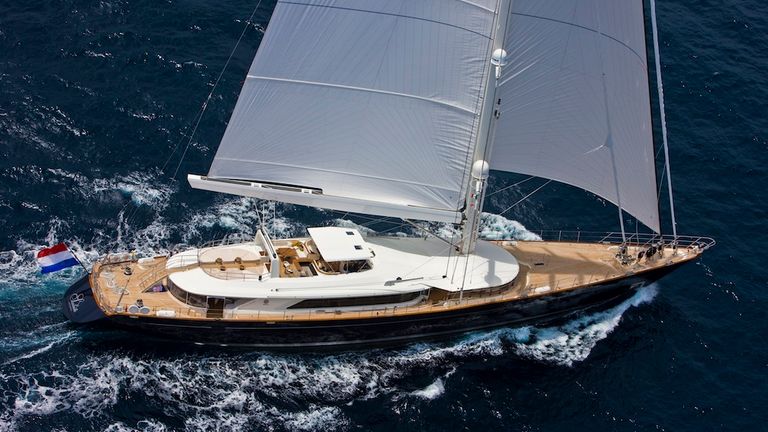










IMAGES
VIDEO
COMMENTS
RELENTLESS is a 60 ft Sunreef sailing catamaran with luxury accommodations for 8 guests. RELENTLESS is a 60′ Sunreef Yacht of pure luxury that offers the ultimate in luxury and comfort for up to 8 guests. She features an up-galley layout, an owner's edition layout with a spacious king owner's suite, and three additional queen cabins, all ...
Relentless II, a Sunreef 80-ft sailing catamaran, is the perfect vessel for an unforgettable sailing vacation in the British Virgin Islands. Her sleek design, spacious accommodations, and abundance of amenities, including an expansive flybridge with sun beds, couches and chairs, a large Jacuzzi nestled by sapphire lounge beds, and a wide range of watersports equipment, offers guests the ...
RELENTLESS: A 60' Sunreef Yacht of Pure Luxury. Relentless is a stunning 60' Sunreef catamaran that offers the ultimate in luxury and comfort for up to 8 guests. She features an up-galley layout, an owner's edition layout with a spacious king owner's suite, and three additional queen cabins, all with en-suite bathrooms and stall showers. ...
Relentless II, a 2022 Sunreef Yacht 80-foot sailing catamaran, is the perfect vessel for an unforgettable sailing vacation in the Caribbean British Virgin Islands. Her sleek design, spacious accommodations, and abundance of amenities, including an expansive flybridge with sun beds, couch and chairs, a large Jacuzzi nestled by sapphire lounge ...
Yacht description. Relentless is a 2020 60ft catamaran, newly designed from Sunreef. This yacht is modern in every respect from the space age shape through to the beautifully designed interior. Layout is one master king suite with a large walk in shower, plus a further three queen cabins with walk around beds and good sized ensuite bathrooms.
The 24.4m/80'1" catamaran yacht 'Relentless II' is an excellent new superyacht for the luxury charter market. Delivered by the Polish shipyard Sunreef Yachts and featuring interior styling by Polish designer Sunreef Yachts she can comfortably accommodate up to 8 guests in 4 cabins.. For those looking for a little more space without compromising on luxury, Relentless II has everything you need.
RELENTLESS: A 60' Sunreef Yacht of Pure Luxury Relentless is a stunning 60' Sunreef catamaran that offers the ultimate in luxury and comfort for up to 8 guests. She features an up-galley layout, an owner's edition layout with a spacious king owner's suite, and three additional queen cabins, all with en-suite bathrooms and stall showers. ...
Relentless is a trailblazer in the Virgin Islands, and we're changing the game. With luxury at every corner, no other fleet offers the same level of luxury and comfort. This custom 60' Sunreef has an owner's suite, plus 3 queen cabins, and will guarantee an unforgettable experience. Relentless II offers the ultimate charter experience; an ...
THE FINEST YACHTING EXPERIENCE. The ultimate Sunreef sailing catamarans available for charter in the Virgin Islands. Explore the islands on our fully equipped catamarans and experience the perfect blend of luxury, adventure and relaxation. Learn More.
Relentless II, a 2022 Sunreef Yacht 80-foot sailing catamaran, is the perfect vessel for an unforgettable sailing vacation in the Caribbean British Virgin Islands. Her sleek design, spacious accommodations, and abundance of amenities, including an expansive flybridge with sun beds, couch and chairs, a large Jacuzzi nestled by sapphire lounge ...
Relentless is a 60ft catamaran launched by Sunreef Yachts in 2020 and available for charters in the Caribbean. Relenless can accommodate 8 charter guests.
Relentless II, a 2022 Sunreef Yacht 80-foot sailing catamaran, is the perfect vessel for an unforgettable sailing vacation in the Caribbean British Virgin Islands. Her sleek design, spacious accommodations, and abundance of amenities, including an expansive flybridge with sun beds, couch and chairs, a large Jacuzzi nestled by sapphire lounge ...
The 33.5m/109'11" 'Relentless ' expedition yacht built by shipyard Kingship is available for charter for up to 9 guests in 4 cabins. This yacht features interior styling by Kingship. Offering a wealth of uncluttered spaces throughout, expedition yacht Relentless is tailor-made for adventures across the high seas; from the tropics to the poles, where all you need to do is kick-back, relax and ...
Relentless ll is an 80ft Sunreef catamaran sleeping 8 guests in 4 cabins. The master cabin has a king bed then the remaining 3 have queen beds. Yacht is fully airconditioned and each room has its own temperature control. There is two rainfall cockpit showers, sat WiFi and a Jacuzzi on deck. Massage therapist and wellness coach onboard
These Sunreef 80ft catamarans are amazing - modern, spacious and absolutely gorgeous! There is great accommodation for up to 8 guests in 1 King and 3 Queen cabins. All the cabins have large windows so you can wake up to the beautiful Caribbean scenery. The décor is very modern and uncluttered with lots of light and neutral colours throughout.
The 39.62m/130' motor yacht 'Relentless' by the American shipyard Westport Yachts offers flexible accommodation for up to 10 guests in 5 cabins and features interior styling by Pacific Custom Interiors. Built in 2006, Relentless offers beautifully proportioned decks for exquisite indoor/outdoor living during a luxury yacht charter.. Guest Accommodation
Yacht Charters Relentless. Meet Relentless, your personal 42-foot classic cruising yacht. A luxury Wesmac boat, this is the newest jewel in our fleet, designed entirely to take you on one-of-a-kind experiences with friends or family. Choose from one of our private Extraordinary Experiences, available exclusively to Club members and resort ...
The real world will fade away as your charter begins on board the magnificent yacht Relentless. Enjoy the perfect respite amid the bright lights and bustle of the city, or go where the bright skies and azure seas blur together at the horizon… where an endless array of sparkling white beaches and swaying palm trees takes your breath away on your own private island getaway.
Catamaran Charter. Rent a sailing catamaran to enjoy more space, exceeding comfort and soothing stability during your vacation. Kalamaki (Athens) Sicily / Capo d'Orlando. Majorc
PRIVATE CHARTERS. SAIL & SNORKEL. For the cure. 3.5 Hr Excursion . BERMUDA'S ULTIMATE CATAMARAN EXPERIENCE-Sail & Snorkel -Guided Island Tour-Stand up Paddle boards & Kayaks-Unlim
Morvillo and his co-counsel added, "This verdict closes the book on a relentless 13-year effort to pin HP's well-documented ineptitude on Dr. Lynch. Thankfully, the truth has finally prevailed.
He cared about the team deeply, exhibiting a relentless passion to excel while displaying genuine love for his players. I especially treasure my conversations with him, talking about football and ...
The 43.28m/142' 'Relentless' motor yacht built by the American shipyard Trinity Yachts is available for charter for up to 10 guests in 5 cabins. This yacht features interior styling by Dee Robinson Interiors. Motor yacht Relentless boasts a wealth of convivial spaces, perfect for luxury yacht charters with families of friends, offering ample opportunities to kick back and relax, or enjoy the ...
NYC lawyer dead after yacht disaster wrote haunting LinkedIn post Emergency services at the scene of the search for a missing boat, in Porticello, southern Italy, Tuesday, Aug. 20, 2024.
Heliport information about UUEJ - Volen [Volen Heliport], MOW, RU
British tech tycoon Mike Lynch and his 18-year-old daughter are among six tourists missing after a luxury yacht sank in a tornado off the coast of Italy. ... Relentless rain and wind battered the ...
O'Connell's Pub #328 among Moscow restaurants: 2226 reviews by visitors and 242 detailed photos. Be ready to pay RUB 1,000 for a meal. Find on the map and call to book a table.
Mike Lynch won an unexpected jury acquittal after a dramatic 12-year legal saga. HP accused him of cooking the books of his company Autonomy to make it seem worth billions more. He finally won ...